
Written and illustrated by Violetta Zein
This part covers the life of Shoghi Effendi from the age of 57 in 1954 to the age of 58 in 1955.
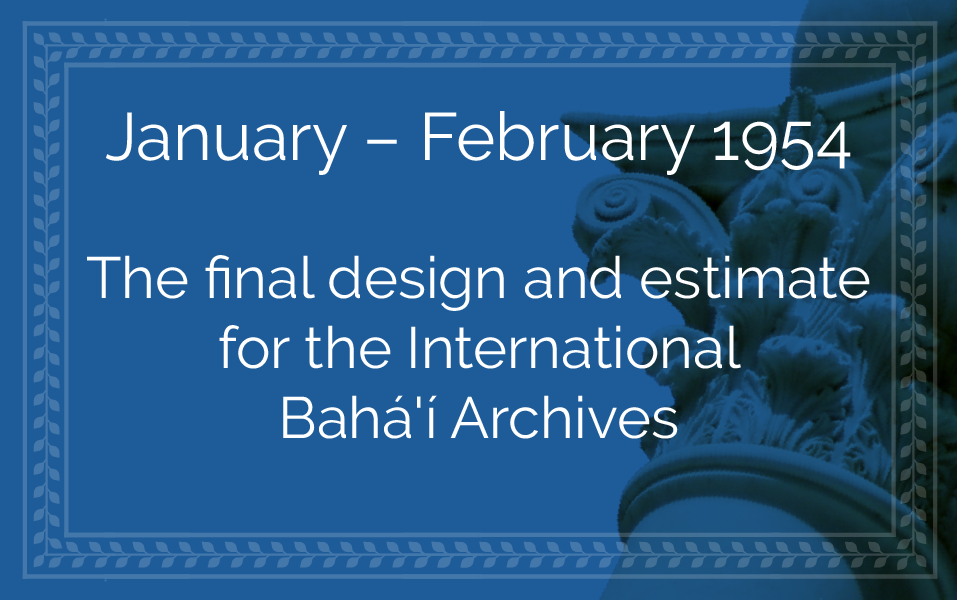
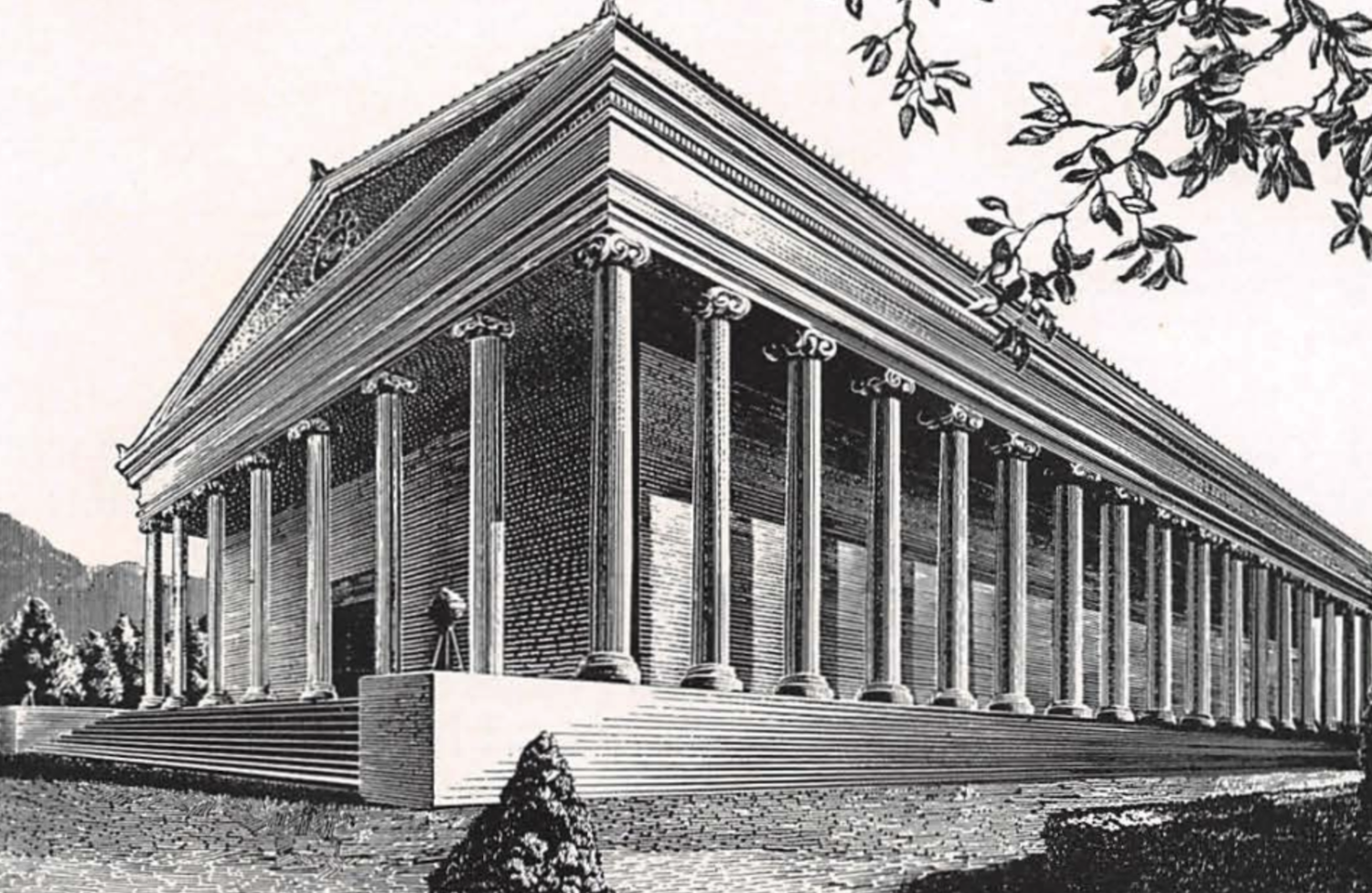
An illustration of the International Bahá'í Archives done by and published in Bahá'í News Issue 303 (May 1956), page 7. This is not the same drawing as the one mentioned in the story below.
Along with the pen and ink drawing of the International Bahá'í Archives he was to bring to New Delhi and display at the Fourth Intercontinental Teaching Conference in October 1953, the Guardian had also included a message to Ugo Giachery instructing him to take the drawing back to Italy and obtain an estimate. The Guardian needed the estimate to make a final decision on the feasibility of the project.
By this point, having worked with the Guardian for 6 years, Ugo Giachery knew his eagerness and wasted no time in writing an explanatory letter, mailing it with the drawing to a trusted friend in Italy so he could begin making inquiries before Ugo Giachery’s arrival from New Delhi, 6,000 kilometers away from Rome, on the other side of the planet.
Leaving New Delhi, Ugo Giachery was delayed in Ṭihrán and only reached Rome before the end of December. Mason Remey had completed the Guardian’s vision for the Archives—all the ideas had been Shoghi Effendi’s—and in Italy, Ugo Giachery secured the collaboration and expertise of one of Italy’s most eminent architects and foremost marble expert: the same marvelous, devoted, and talented Professor Rocca who had sourced the Chiampo marble and the Rose Baveno granite for the superstructure of the Shrine of the Báb.
As soon as he arrived, Ugo Giachery sent the Guardian the only estimate he had been able to collect, along with Professor Rocca’s fully-developed architectural drawing of the International Bahá'í Archives incorporating all the elements that were present in the pen-and-ink drawing.
The Guardian responded immediately, in early January 1954 and suggested changes in the approach to and the front of the International Bahá'í Archives. Once Professor Rocca had incorporated the Guardian’s changes, which the Guardian enthusiastically approved.
The first tentative estimate Ugo Giachery sent had been very encouraging for the Guardian, who requested a final definite estimate guaranteeing the execution of the stone work by a set deadline and without additional material or labor costs.

Dorothy Beecher was born on 21 December, 1898, in Newark, New Jersey. She was a distant relative of Harriet Beecher Stowe, the author of the famous anti-slavery novel, Uncle Tom's Cabin, published in 1852, and believed to have been an influence in the American Civil War. Her grandmother, Ellen Tuller Beecher—Mother Beecher—was active in movements concerned with women's rights, prison reform, the YWCA and the temperance movement.
Mother Beecher was one of the first Bahá'ís in the United States in the 1890s.
Dorothy Beecher discovered the Bahá'í Faith when she was 13. Her grandmother, Mother Beecher, took her to New York to see 'Abdu'l-Bahá. By the time Dorothy was 15, she had declared. After college, Dorothy Beecher began working in the New Jersey public school system.
In June 1921, Dorothy Beecher married Frank Baker, a widower with two children, and took his surname. Their daughter Louisa was born in 1922, and they had a son the next year, in 1923.
The family moved to Lima, Ohio in 1927. For many years in Lima, Dorothy and Frank had to endure opposition from the local community, but the tensions eventually died down after a friendly priest arrived, and Dorothy’s radio show on the Bahá'í Faith became hugely popular.
Dorothy Baker was first elected to the National Spiritual Assembly of the United States and Canada in 1937. She would serve 16 years on the National Assembly.
She was deeply involved with the Race Unity Committee, an organization which worked to educate in order to uproot racism, give parents recommendations for educating their children in the spirit of racial equality, and encouraged the study of African-American culture.
From 1937 to 1946, Baker made six trips through Central and South America. Because of her background in speaking to many audiences, Baker was widely regarded as one of the best Bahá’í speakers in the United States during her time.
Louise Baker—Dorothy’s daughter—pioneered to Colombia in early 1943, and Dorothy visited her three times.
On 24 December 1951, the Guardian elevated Dorothy Baker to the rank of Hand of the Cause. She was in the first contingent of living Hands of the Cause named by the Guardian.
Dorothy Baker went on pilgrimage to Haifa in early 1953, immediately before attending the First Intercontinental Teaching Conference in Kampala, Uganda as the Guardian’s representation in February 1953
Dorothy Baker’s last public talk was in Karachi, Pakistan in early 1954. She was planning to leave Karachi and fly back to the United States and leave with her husband Frank for their new pioneering post for the Ten Year Crusade in Granada, an island in the Caribbean.
From Karachi, Dorothy Baker flew to Rome.
On 10 January 1954, at 10:30 AM local time, Dorothy Baker boarded a BOAC DeHavilland Comet—the first model of jet powered passenger airliner to be in service—bound for London.
Forty minutes later, at 11:10 AM, the plane fractured because of bad design—it had large, square windows. All passengers and crew were lost as the plane went down in the Mediterranean, off the western coast of Italy and in the vicinity of the island of Elba, 200 kilometers northwest of Rome.
Dorothy Baker taught the Faith until the very end.
A few days after the crash, fishermen found a purse belonging to one of her fellow passengers which had washed up on the shore.
Inside the purse was a Bahá'í pamphlet.
On 13 January 1953, the Guardian sent this message to the American Bahá'í community:
Hearts grieved at lamentable, untimely passing of Dorothy Baker, distinguished Hand of the Cause, eloquent exponent of its teachings, indefatigable supporter of its institutions, valiant defender of its precepts. Her long record of outstanding service has enriched the annals of the concluding years of the Heroic and the opening epoch of the Formative Age of the Bahá’í Dispensation. Fervently praying for the progress of her soul in the Abhá Kingdom.
Assure relatives of profound loving sympathy. Her noble spirit is reaping bountiful reward.
Advise hold memorial gathering in the Temple befitting her rank and imperishable services…
The Guardian appointed Paul Edmond Haney as Hand of the Cause after Dorothy Baker’s passing.
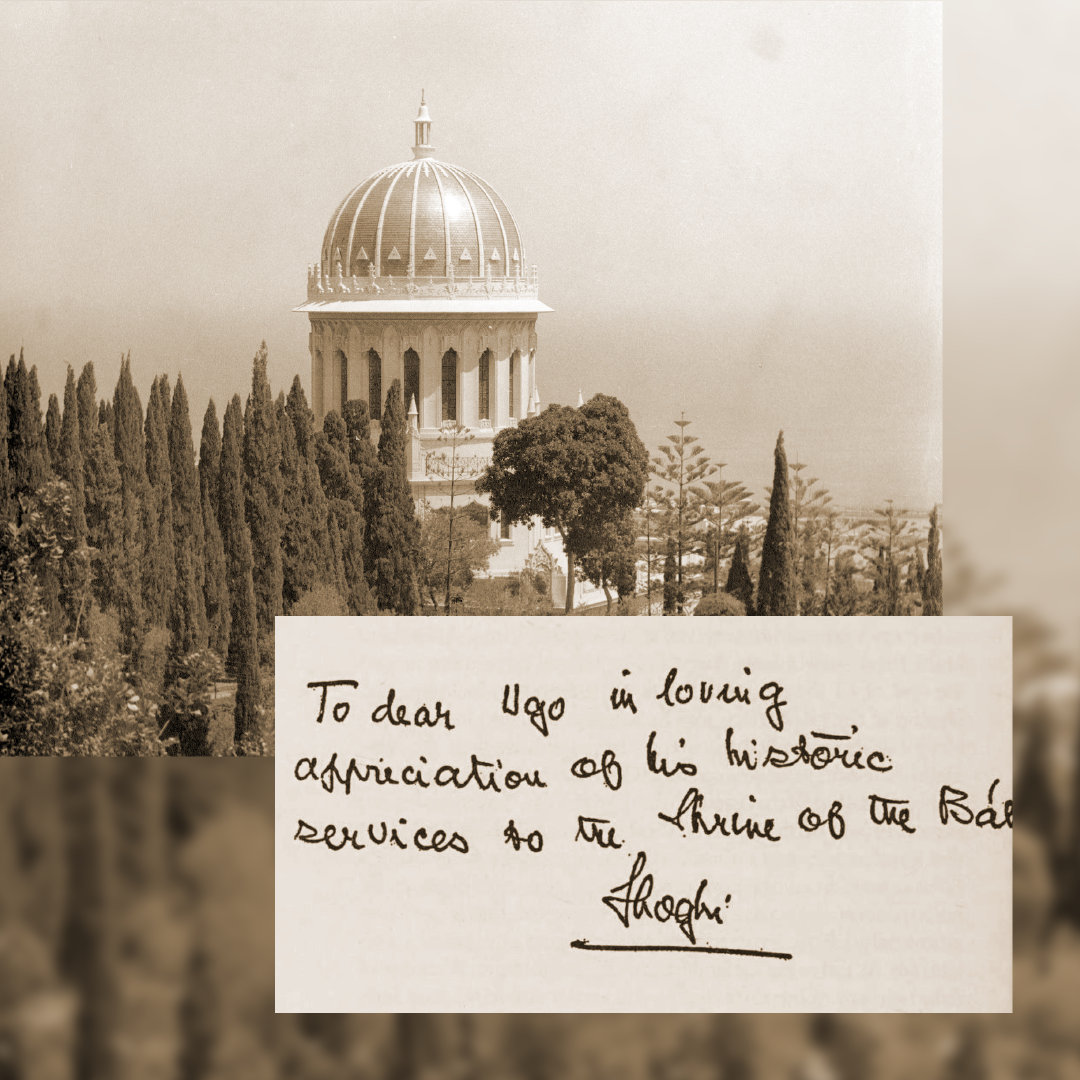
A processed sepia tinted photograph from an original black and white image of the Shrine of the Báb seen from the back and from the west, as an illustration for the photograph gift the Guardian sent Hand of the Cause Ugo Giachery. © United States National Bahá'í Archives, used with permission. Note on the back of the photograph in Shoghi Effendi’s own hand reproduced on page 106 of Shoghi Effendi: Recollections by Ugo Giachery.
In February 1954, Frank Baker—the husband of late Hand of the Cause Dorothy Baker, who had died in a tragic airplane crash—brought Ugo Giachery a personal gift from Shoghi Effendi when he was in Rome after his pilgrimage to the Holy Land.
The memento Shoghi Effendi had sent was a priceless gift, a recompense for Ugo Giachery’s years of effort and the completion of the work of art that was the superstructure of the Shrine of the Báb.
It was a large, sepia-colored photograph of the Shrine of the Báb, taken from an unusual angle, from the west of the building, and, on the back, in Shoghi Effendi’s loving handwriting was an inscription:
To dear Ugo in loving appreciation of his historic services to the Shrine of the Báb. Shoghi.
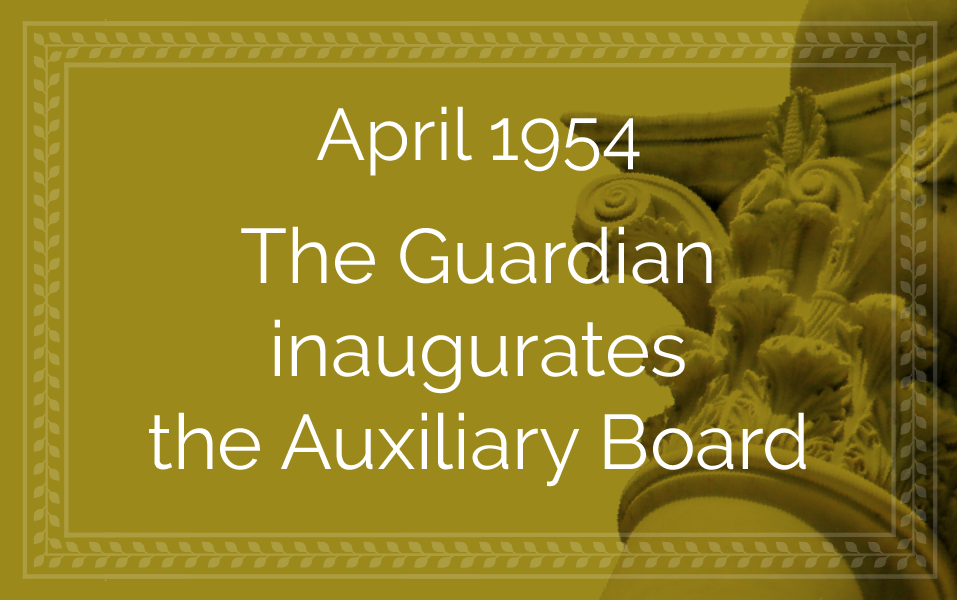
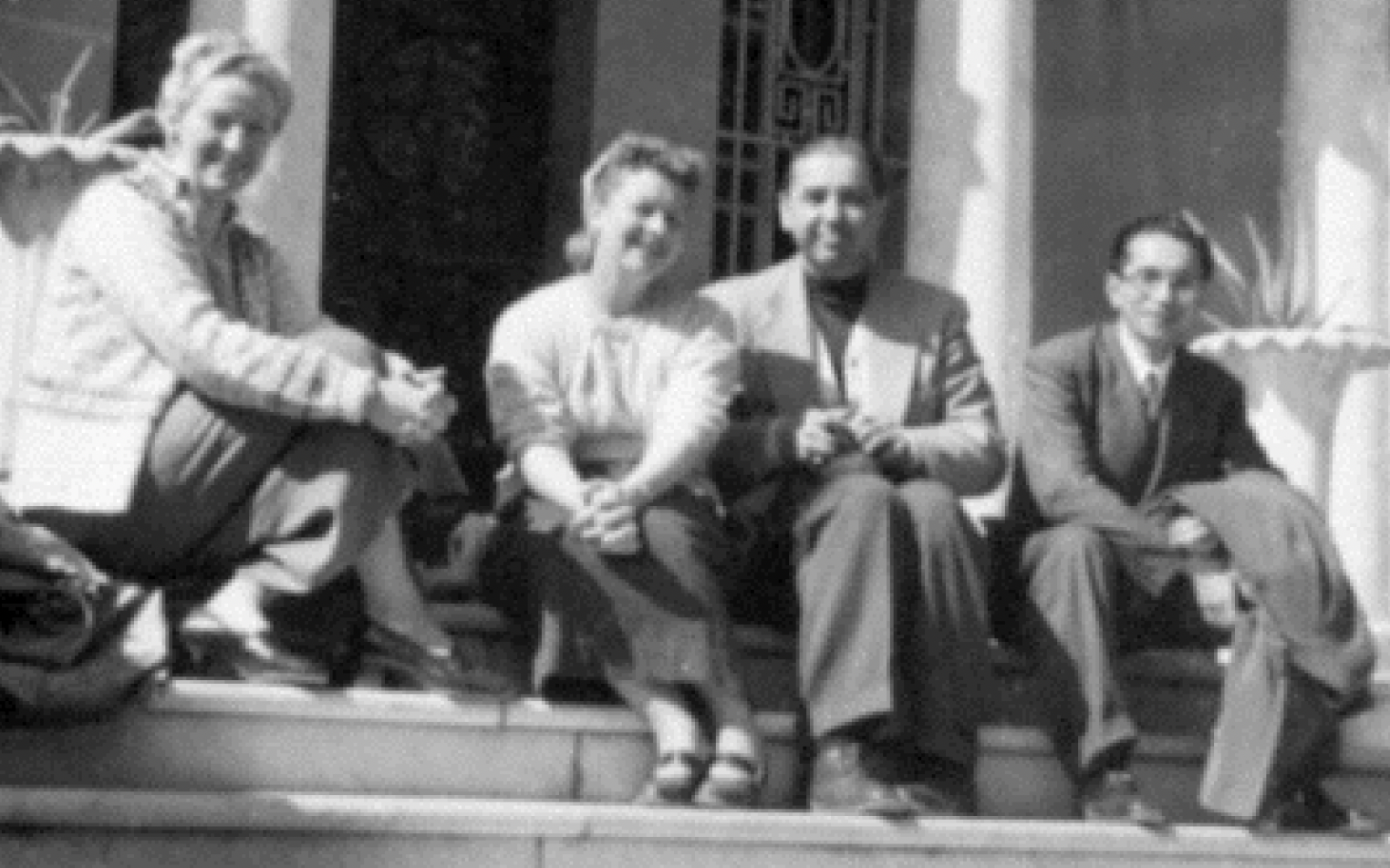
Haifa, February 1954. Hiroyasu Takano, on the right, with fellow pilgrims Loyce Lawrence and Maud and Albert Reimholz. Source: Memories of talks with the Guardian by Hiroyasu Takano (as related at the 1980 Bahá’í National Convention of Japan), on Bahá'í Library Online.
Hiroyasu Takano was the only Japanese Bahá'í apart from Saichiro Fujita to ever meet the Guardian and the very first Japanese Bahá'í pilgrim. He arrived on pilgrimage from late February to early March 1954, on his way back to Japan from the May 1953 dedication of the House of Worship in North America in Wilmette.
During his pilgrimage, the Guardian, of course, spoke at length about the glowing spiritual destiny of Japan—that they would take the lead in the spiritual reawakening of the peoples and nations—and its important role as one of the two centers, with Australia, in the Pacific region.
The Guardian gave two meanings to the word “center.” The first, was that Japan was the pole of a magnet, a force of attraction that pulls strength in from its surroundings. The second meaning was that of a radiating center that emitted light and illumination towards its surroundings. The Guardian said that Australia and Japan needed to be both types of centers for the Pacific region.
The Guardian emphasized the qualities of the Japanese people: they were one of the most industrious nations in the world, their identity was based on centuries of a deeply-refined culture, they were a spiritual and very capable people, their art revealed their innate sense of balance.
One of Shoghi Effendi's most striking comments was regarding the recent sufferings of the Japanese people. The Guardian stated that the suffering endured by the Japanese, the devastation of two atomic bombs on their soil, signified that they had experienced extraordinary sacrifice, and severe trials, which would lead to them becoming a center of light in the region.
Shoghi Effendi advised the Japanese Bahá'ís to raise up strong communities in Tokyo and Osaka, from which they could send out homefront pioneers in as many isolated centers as possible. The Guardian explained that the more isolated centers there were, what happened would be akin to what happens when a pen hits a piece of paper: the first mark is a dot, which becomes a line, which turns into letters, which form words, which combine together to create sentences.
The Guardian gave Hiroyasu Takano a precious gift, one half of a piece of cloth that had lain directly on the body of Bahá’u’lláh, to offer to the National Spiritual Assembly once it had been established. The second half of this blessed piece of fabric was given to the second center in the Pacific region: Australia. The National Spiritual Assembly of Japan would not be elected until 1974, but once they built the Tokyo Bahá'í Center, the sacred piece of cloth, offered by the Guardian, was hung in the center.
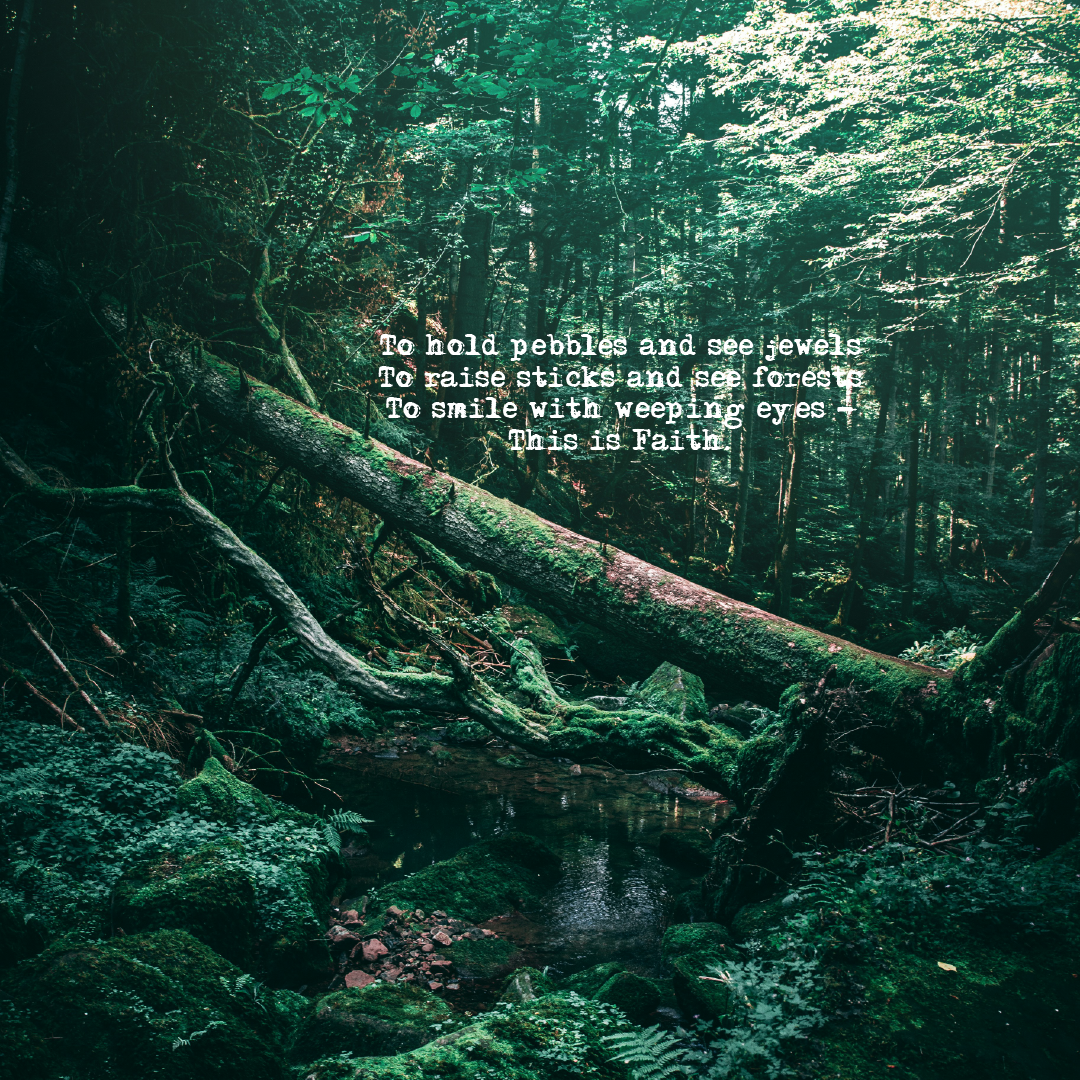
Background image by Oliver Roos on Unsplash.
Shoghi Effendi had always encouraged Rúḥíyyih Khánum to write, no doubt proud of his wife’s literary talents. Once, as she was copying her favorite poems into a book, Shoghi Effendi asked to see them for himself.
The next day, he gave Rúḥíyyih Khánum her book back, saying:
I read them all. They are beautiful, they made me cry.
It was at Shoghi Effendi’s own suggestion that Rúḥíyyih Khánum wrote an article for The Bahá'í World Volume 7 recounting the moving event of the Guardian’s reinterment of the remains of Ásíyih Khánum and Mírzá Mihdí on Mount Carmel, in the shadow of the resting-place of the Greatest Holy Leaf.
It was also the Guardian’s warm encouragement that was the main reason Rúḥíyyih Khánum authored her wonderful book—addressed in 1950 in this chronology—Prescription for Living.
On 4 April 1954, just two days before the Guardian inaugurated the Auxiliary Boards, Rúḥíyyih Khánum penned what is perhaps the definitive and most beautiful Bahá'í poem ever written, “This is Faith”:
THIS IS FAITH
To walk where there is no path
To breathe where there is no air
To see where there is no light–
This is Faith.
To cry out in the silence,
The silence of the night,
And hearing no echo believe
And believe again and again–
This is Faith.
To hold pebbles and see jewels
To raise sticks and see forests
To smile with weeping eyes–
This is Faith.
To say: “God, I believe” when others deny,
“I hear” when there is no answer,
“I see” though naught is seen–
This is Faith.
And the fierce love in the heart,
The savage love that cries
Hidden Thou art yet there!
Veil Thy face and mute Thy tongue
Yet I see and hear Thee, Love,
Beat me down to the bare earth,
Yet I rise and love Thee, Love
This is Faith.

Hands of the Cause for the European Continent with members at their Auxiliary Board at the Conference held in Frankfurt, Germany, October 1-3, 1954. Seated, left to right: Hands of the Cause: Dr. Hermann Grossmann, Dr. Ugo Giachery and Dr. Adelbert Mühlschlegel. Standing, from left to right: Dr. Eugen Schmidt, Tove Deleuran, Anna Grossrmann, Louis Henuzet, Marion Hofman, Angeline Giachery and Dorothy Ferraby. Missing are: Dr. George Townshend, Hand of the Cause, and Elsa Steinmetz and Joel Marangella, members or the Auxiliary Band.from Bahá'í News Issue 288 (February 1955), page 5.
In the last years of his life, during the opening years of the Second Epoch of the Formative Age, the Guardian paid many tributes to the significance of the "unfolding glory" of the institutions at the Bahá'í World Centre, in the course of which he revealed the station and the functions of the institution of the Hands of the Cause.
The Institution of the Hands of the Cause, were that "august institution" which Bahá'u'lláh Himself had foreshadowed, and to which He had appointed, in His lifetime, four prominent Bahá'ís. It was 'Abdu'l-Bahá who had formally established the institution of the Hands of the Cause in His Will and Testament, and he also had appointed four Hands of the Cause posthumously during His ministry.
The Hands of the Cause supported the Guardian in the Holy Land, reinforced ties between the worldwide Bahá'í Faith and the State of Israel, initiated preliminary measures, under the Guardian’s supervision, for the establishment of the Bahá'í World Administrative Centre, they had extended in the name of the Faith the international endowments in the Holy Land, they had represented the Guardian at the four great Intercontinental Teaching Conferences in America, Europe, Africa, and Asia in 1953, They attended National Conventions as the Guardian’s representatives, and in the Guardian’s name, the Hands of the Cause had extensively traveled in North, Central and South America, Europe, Asia and Australia.
The Hands of the Cause had forged intimate bonds of collaboration between the Bahá'í National Spiritual Assemblies engaged in winning victories for the Ten Year Crusade, and in a cable dated 6 April 1954, Shoghi Effendi announced to the Bahá'í world that the Institution of the Hands of the Cause was entering the second phase of its evolution:
The hour is ripe for the fifteen Hands residing outside the Holy Land to proceed during Ridván with the appointment, in each continent separately, from among the resident Bahá'ís of that Continent, of Auxiliary Boards, whose members, acting as deputies, assistants and advisers of the Hands, must increasingly lend their assistance for the promotion of the interests of the Ten Year Crusade.
The Guardian had just inaugurated the Auxiliary Boards.
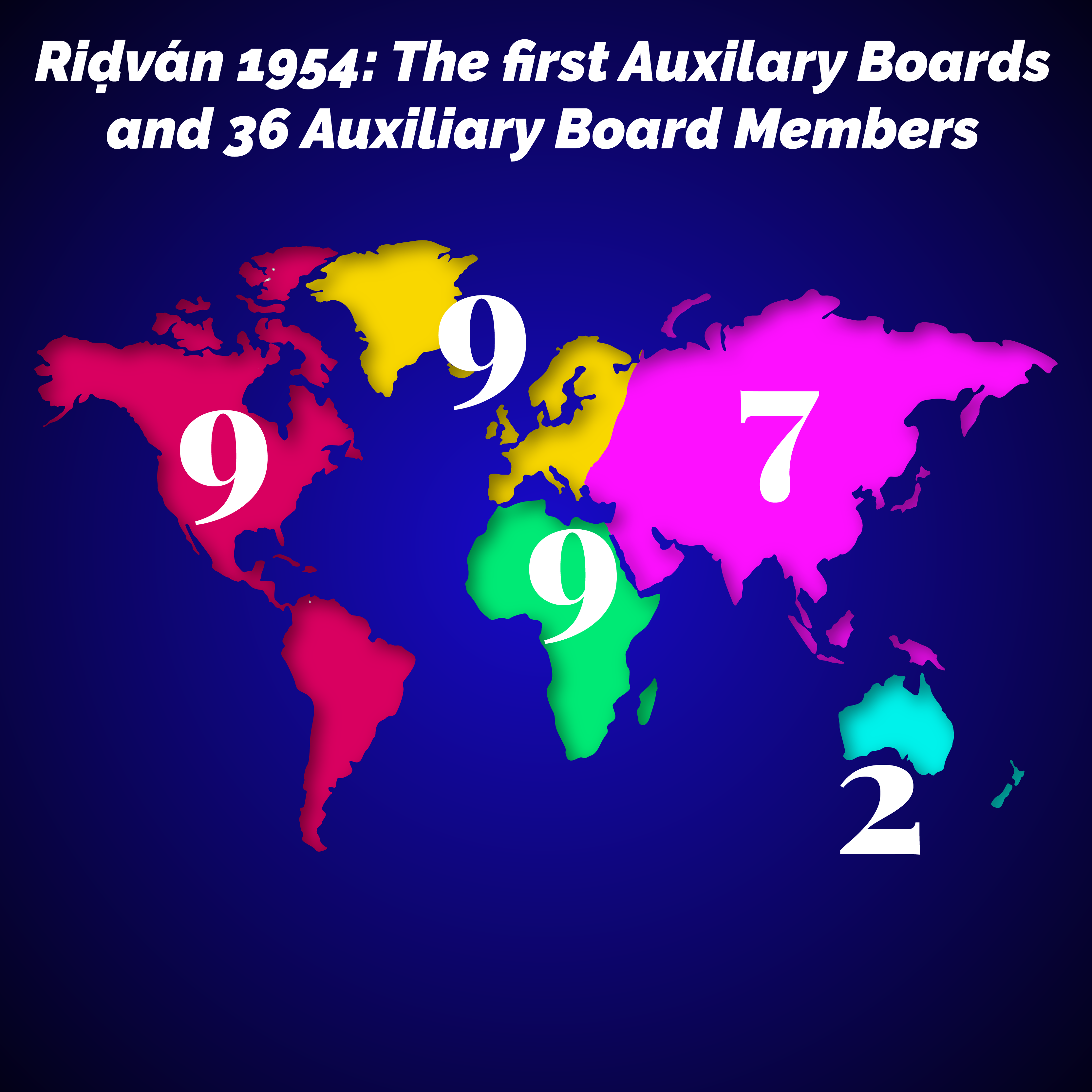
Map asset by Freepik.
The creation of the Auxiliary Boards was a major development in the history of the Bahá'í Faith, the full unfoldment of the appointed arm of Bahá'í Administration, which would, in the time of the Universal House of Justice, become the Institution of the Counsellors.
The Guardian instructed the 15 Hands of the Cause residing outside the Holy Land to appoint Auxiliary Boards on all 5 continents at Riḍván 1954:
- 9 members of the Auxiliary Board in America,
- 9 in Europe,
- 9 in Africa,
- 7 in Asia,
- And 2 in Australia for a total of 36.
The Guardian brought the Auxiliary Boards into being to serve the work of the Hands of the Cause and to ensure that their vital influence would permeate the Bahá’í community.
The Auxiliary Board Members would act as deputies, assistants, and advisers to the Hands of the Cause, increasingly assist in the promotion of the Ten Year Crusade, stimulate and strengthen the teaching work, consolidate emerging Bahá'í communities, liaise with pioneers, deepen the believers, encourage contribution to the fund, and protect the Faith from any and all threats.
Auxiliary Board Members were directly accountable to the Hands of the Cause of their respective continents.
For their part, the Hands of the Cause were instructed to keep in close contact with the Hands of the Cause in the Holy Land and the National Spiritual Assemblies in their areas of responsibility, informing them of the activities of the Auxiliary Board Members.
The Guardian also inaugurated at the same time five Continental Bahá'í Funds for the work of the Hands of the Cause with a contribution on his behalf of £1,000 to each.
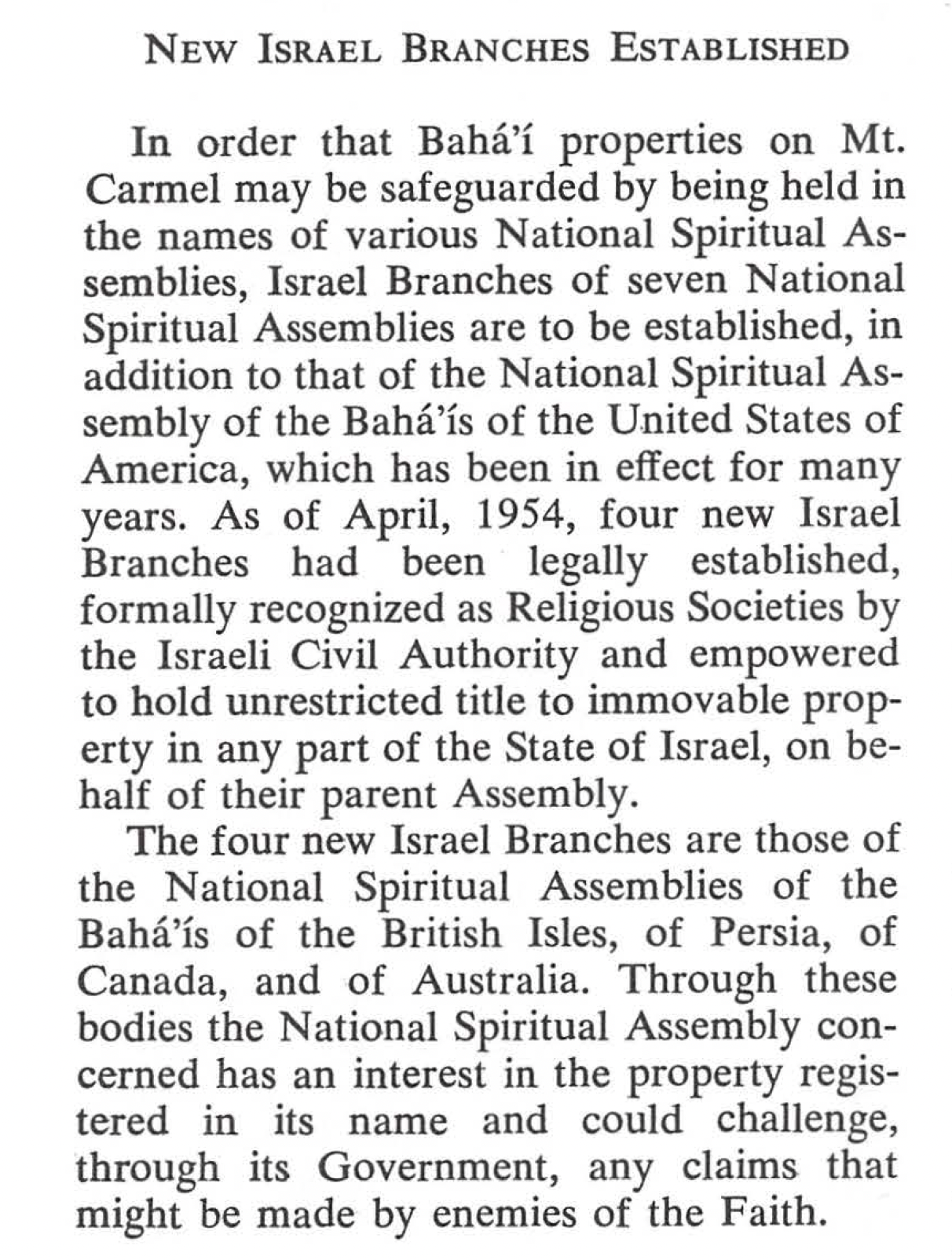
There could be no better illustration for this story than the article written in The Bahá'í World Volume 12, page 38 regarding the formation of four Israel Branches of National Spiritual Assemblies. The fact this information is so early on in the volume speaks of the high importance the Guardian attached to these institutions.
Early in his ministry the Guardian conceived of a unique way to safeguard the properties that were being acquired, and simultaneously establish the international character of the Faith as a legitimate worldwide community.
The Guardian’s solution was to create Israel Branches of various Bahá'í National Spiritual Assemblies.
The first—at the time of the British Mandate—was the Palestine Branch of the joint National Spiritual Assembly of the United States and Canada.
As the Guardian’s land purchases in the Holy Land increased in intensity, he created additional Israel Branches and various parts of the International Endowments of the Faith—the term used by the Guardian to refer to Bahá'í properties in the Holy Land—were held by these formally recognized Israel Branches of National Spiritual Assemblies.
The Guardian laid out their importance, their scope, and their role in his Riḍván message of 1954:
Israel Branches of the British, the Persian, the Canadian and the Australian Bahá'í National Spiritual Assemblies have been legally established, recognized formally as Religious Societies by the Israeli Civil Authorities, and empowered to hold without restriction title to immovable property in any part of the country on behalf of their parent Assemblies. Contact has moreover been established with the President of Israel, its Prime Minister and five other Cabinet Ministers, as well as with the President of the Knesset, culminating in the establishment of a special Bahá'í Department in the Ministry of Religious Affairs, and in an official statement by the Head of this Ministry to Parliament emphasizing the international scope of the Faith and the importance of its World Center--a series of events that have paved the way for the forthcoming official visit, during the early days of the Ridván period, of the President of Israel, himself, to the Báb's Sepulcher on Mt. Carmel.
The legal entities of the Israel Branches—formerly Palestine Branches—of Bahá'í National Spiritual Assemblies had, as their officers, Shoghi Effendi as President and Leroy as Secretary-General, but the entire operation of the bodies, as Leroy noted in a memorandum of record, was under the control of the Guardian.
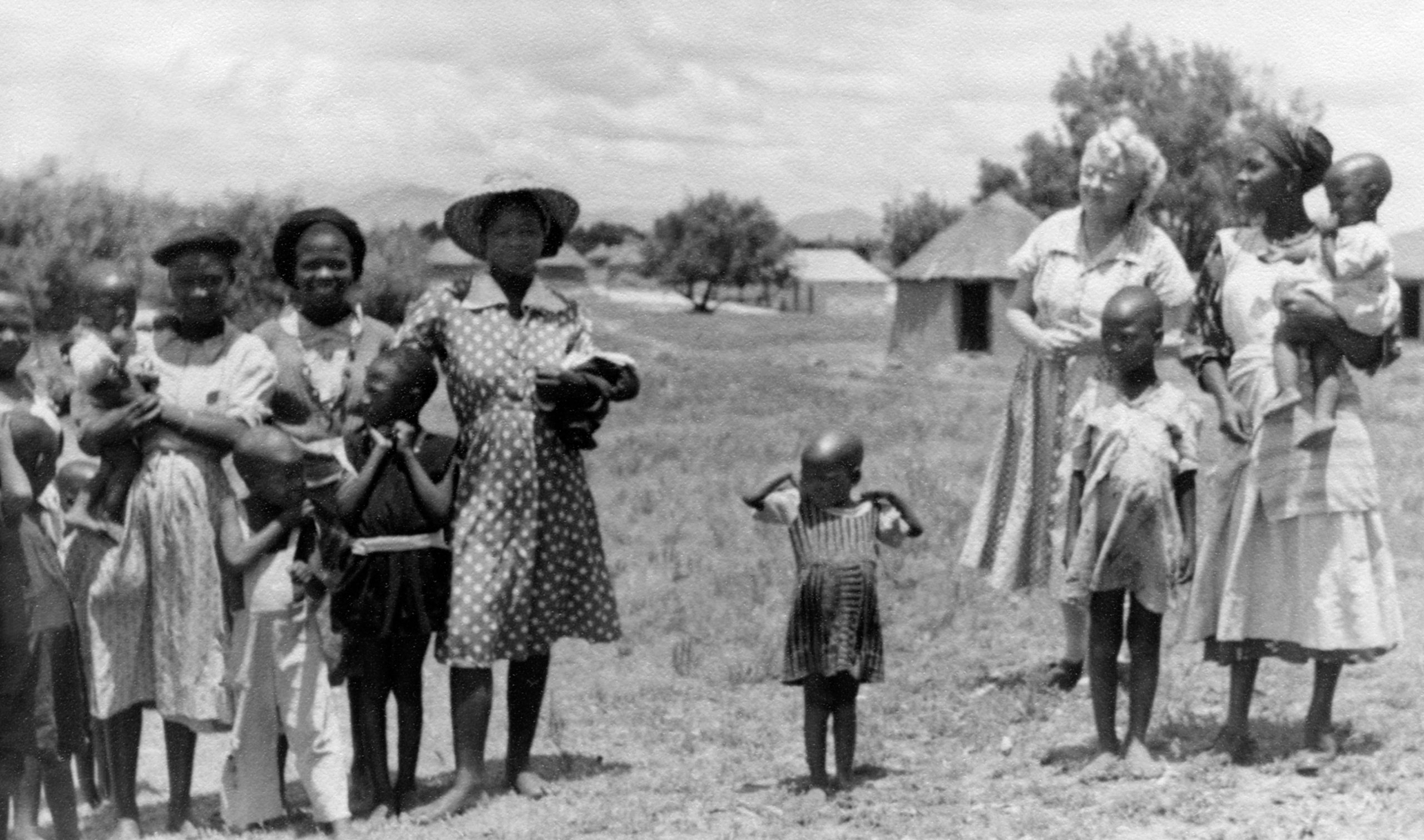
Elizabeth Laws, known as Mother of Love, with local people in Lesotho. Elizabeth and Frederick Laws arrived on 13 October 1953, just three days before the end of the Holy Year at the beginning of a ten-year plan to take the Baha'i teachings around the world. For their services, they each received the accolade, Knight of Bahá’u’lláh, from Shoghi Effendi . Source: Bahá'í Media Bank, © Bahá'í International Community 2023.
The Guardian considered the Knights of Bahá'u'lláh who arose during the Ten Year Crusade heroes, and he drew an important parallel between these Heroes of the Formative Age, and the Heroes of the Heroic Age of the Faith, during the ministry of the Báb:
Yes, they are hardly to be duplicated. And yet—he said after a pause—we must remember, they can never duplicate the acts of the Letters of the Living at the time of the Bab. Those are unique and will never be surpassed by any Baha'i in the world. But the Baha'is of today, in their services and struggles for the Cause of God, are sacrificing and gaining victories almost as great as those of the eighteen Letters of the Living.
The first year of the Ten Year Crusade was gaining momentum, and the Bahá'ís of the world were gaining a deeper consciousness of what was happening to them and in the Bahá'í world. Believers everywhere were responding to the challenges with astonishing vigor and clear-mindedness, something Leroy Ioas considered to be one of the miracles of the opening year of the Crusade.
In his Riḍván message of 1954, the Guardian summarized what the world had accomplished in the first 12 months of the Crusade:
The first twelve months of this decade-long enterprise unexampled in its scope, significance and potentialities in the world's spiritual history and launched simultaneously, amidst the climax of the world-wide festivities of a memorable Holy Year, in the American, the European, the African, the Asiatic and the Australian continents, have witnessed the hoisting of the banner of the Faith of Bahá'u'lláh in no less than a hundred virgin territories of the globe.
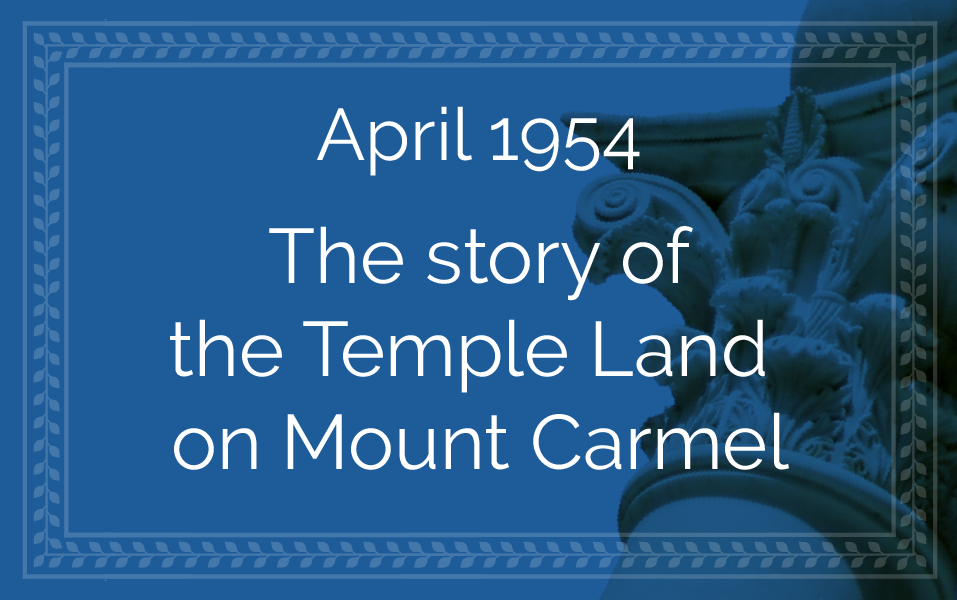
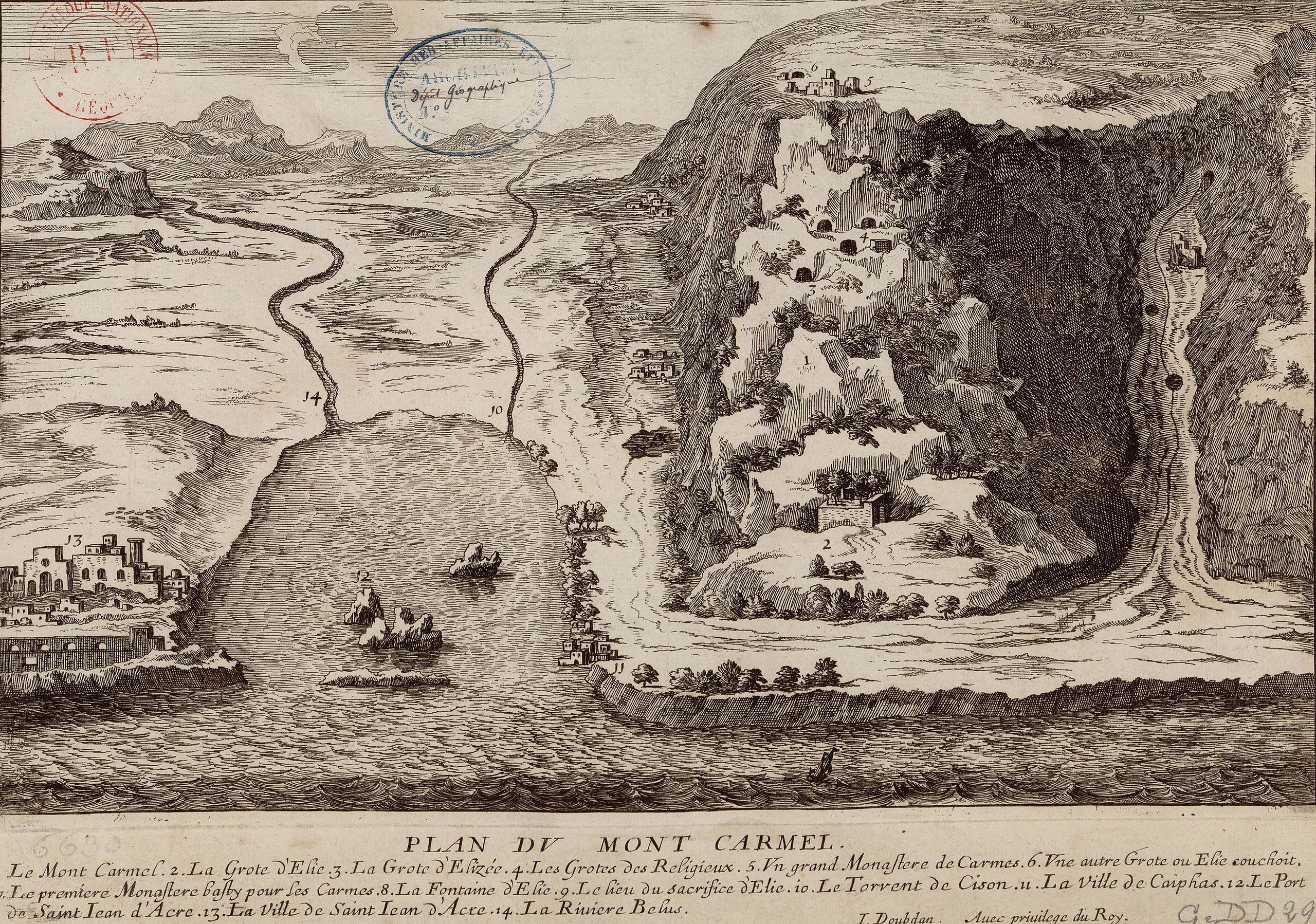
A French map titled Plan of Mount Carmel: Relief view of Mount Carmel and Haifa Bay in the 17th century. The map was originally published in Le voyage de la Terre Sainte (The journey to the Holy Land), by Jean Doubdan between pages 490 and 491 in the third edition of the book published in Paris in 1666. Source: Wikimedia Commons.
When Jerusalem was captured during the First Crusade in 1099, a large sweep of gorgeous land at the crest of Mount Carmel was granted to a religious order: The Carmelite Order of Discalced Monks. The land was truly majestic, with its panorama over the Mediterranean to the west, views of the rolling Valley of Askalon to the south, 'Akká lying on its crescent-shaped coast to the north, and the city of Haifa to the East.
In the 12th century, the Carmelites built the monastery of Stella Maris—Star of the Sea—on. Mount Carmel, and left the remainder of their thousands of precious acres undeveloped.
Seven centuries later, Bahá'u'lláh pitched His tent in the vicinity of Stella Maris, a few days after He had pointed out the spot for the Shrine of the Báb to 'Abdu'l-Bahá midway up Mount Carmel. Accompanied by 'Abdu'l-Bahá and some believers, Bahá'u'lláh visited the “upper” Cave of Elijah on the western edge of Mount Carmel, located inside the Carmelite monastery before walking away from the monastery.
Bahá’u’lláh summoned Mírzá Áqá Ján to transcribe, and began revealing the Tablet of Carmel chanting with a loud and clear voice in such forceful ringing tones, that His melodious voice reverberated around the mountaintop, heard all the way inside the monastery. Shoghi Effendi described this moment:
Such was the commotion created on that historical event, … the earth seemed to shake, while all those present were overpowered by His mighty and wondrous spirit.
The Tablet of Carmel—in which Bahá'u'lláh addresses Mount Carmel itself—is the Charter of the development of the Bahá'í World Centre, prefacing both the Holy Places and the Seat of the International Bahá'í Administrative Order, both to be erected on Mount Carmel itself.
Baha'u'llah had consecrated that soil.
And it was that land which the Guardian now wished to purchase.
The process would take two long, and difficult years.

The Carmelites, the State of Israel, and the British War Office, all claiming ownership of the Temple Land on Mount Carmel. Sources: The coat of arms of the Carmelites from Wikimedia Commons, the emblem of the State of Israel from Wikimedia Commons, and the royal coat of arms of the British War Office from Wikimedia Commons. Background image of Mount Carmel from Wikimedia Commons.
The purchase of the Temple Land was impossible: during the protracted negotiations, not a single person thought it could be done. Everywhere Leroy Ioas went, he was told it could not be done. At one point, the Guardian asked Leroy Ioas:
What do you think, Leroy, when these people say you cannot have something you want?
Leroy Ioas had the perfect response:
When I know Shoghi Effendi wants it, I just don't hear their “No.”
Upon investigation, the question of ownership was revealed to be so complex, Leroy Ioas took it as a confirmation of his efforts because he felt only God could “disentangle such a web.”
The Carmelite Order had owned the Temple Land for 900 years but during the British Mandate, the British War Office had requisitioned the land for military purposes because it overlooked the Haifa harbor.
At the end of the British mandate, the British agreed to resell the property, but the Carmelites didn’t have the funds and the contract was never concluded. The Temple Land was in a property limbo: the Carmelite Order, the British War Office, and the State of Israel all claimed ownership. In the end, the Israeli Defense Ministry requisitioned the land for its strategic value, just as the British had before them.
On top of the ownership complications, the city of Haifa had made plans to turn the land into a center of urban development.
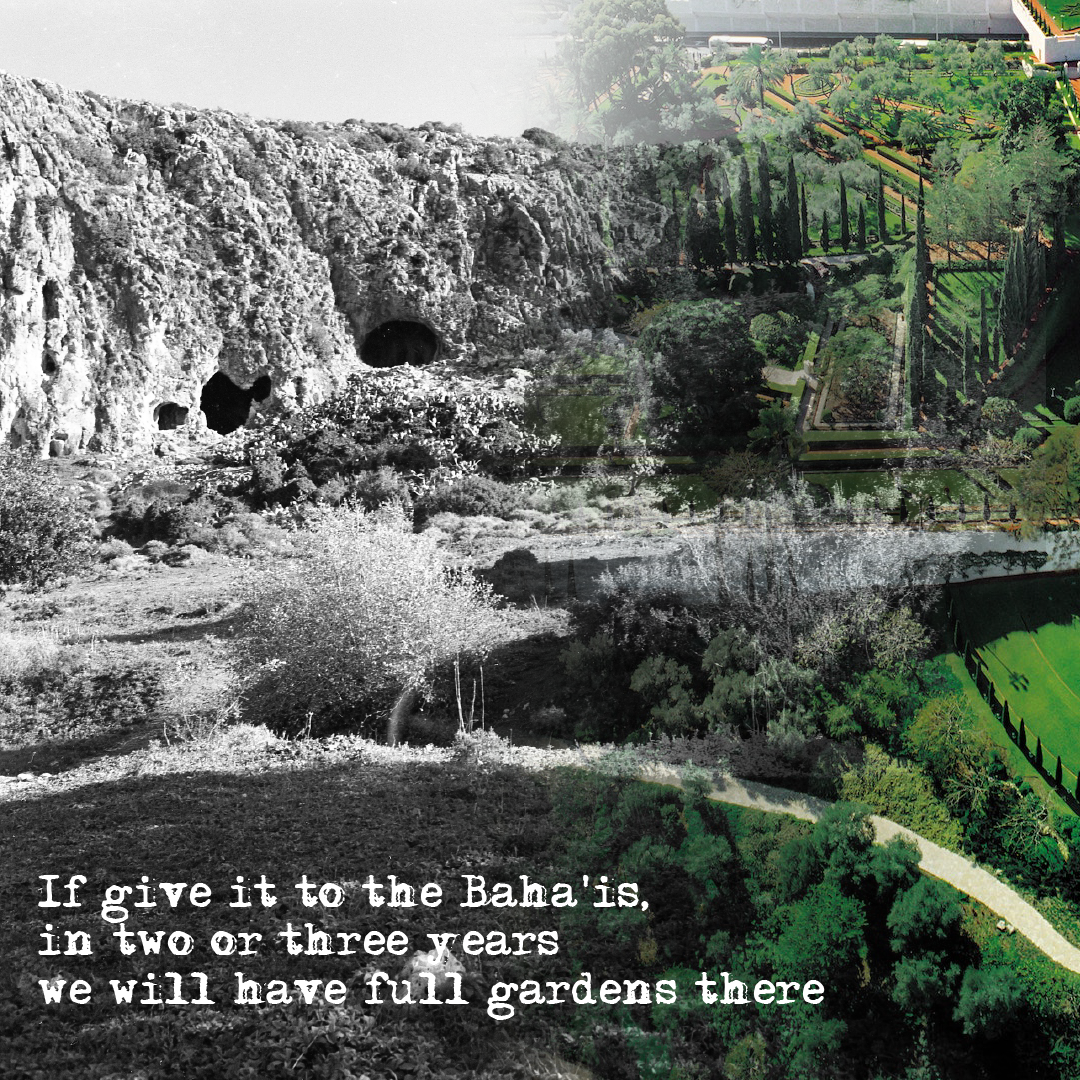
“If give it to the Bahá'ís, in two or three years we will have full gardens there…” Blending of two separate images: a black and white photograph of a wild area of Mount Carmel taken in March 159 from Wikimedia Commons, and a modern-day photograph of the landscaping of the terraces on Mount Carmel below the Shrine of the Báb from Bahá'í Media Bank, © Bahá'í International Community 2023.
This was the situation Leroy Ioas was faced with when the long and difficult negotiations began.
Leroy Ioas worked with many departments inside the Israeli Government, patiently, slowly winning favor for the idea that the Israeli Government could waive its ownership rights to the Bahá'ís if the Bahá'ís agreed to purchase the land outright.
As soon as the Carmelites got wind that the situation was beginning to lean in favor of the Bahá'ís, heated arguments erupted, but one highly-placed official dismissed their criticisms saying that, in 900 years, they had done nothing to develop the land, and the property had degraded. The official said:
If give it to the Bahá'ís, in two or three years we will have full gardens there, it will be an asset to us. Ask the Order what they do with their hard currency, do they bring it into Israel? What do the Baha'is do? They carry on their work with hard currency, they bring us what we need. Who is bringing pilgrims here from everywhere in the world? Whose world center is here?
It was during the course of that meeting that the Israeli Government decided to cede their legal claim to the Temple Land to the Bahá'í Community.
The matter, however, was far from over. The Defense Department occupied the Temple Land and Leroy Ioas had to carry out difficult negotiations with them for many months. One reason the negotiations were complex was because the various branches of the Israeli Defense Department were not on the same page.
One branch of the Defense Department was adamantly opposed to relinquishing the Temple Land and insisted on a meeting in the Defense Minister’s office. The Minister himself was out of town but the meeting was chaired by a brilliant young deputy who, as it turned out, had attended a seminar at Harvard University with one of Leroy Ioas’ longtime railroad colleagues.
He and Leroy immediately developed a warm relationship and Leroy Ioas left the meeting with a letter favorable to release the Temple Land into the hands of the Bahá'ís.
Three services in the Defense Department were still opposed to releasing the land to the Bahá'ís and Leroy Ioas had to endure more lengthy negotiations before they agreed to hand over the land to the Bahá'ís.

“What is so particular about this spot?” A deeply moving image of the Wailing Wall in Jerusalem, a sacred location for Jews, as sacred as the Temple Land on Mount Carmel is to Bahá'ís. Photogrpah by Anthony Garcia on Pexels.
When Leroy Ioas thought everything had been decided, the official representing the State Domain stood in the way of the final settlement. He refused to give the Guardian the exact plot of land which the Guardian had designated as the Temple Land, and on which Leroy Ioas had placed a stone marking the heart of the future House of Worship. Leroy Ioas described his discussion with the State Domain official as “spirited.”
There were two issues which irked the official. The first one was why the Bahá'ís were so intent on the plot of land the Guardian had chosen. He suggested to Leroy Ioas that the Bahá'ís simply choose a different plot of land than the one the Guardian had chosen. He asked:
What is so particular about this spot? We just will not give it to you.
Leroy Ioas responded:
This is the spot we must have because it is a Holy Place. Why don’t you move your Wailing Wall in Arab-held Jerusalem over to New Jerusalem> Why don’t you just use one of the walls of the King David Hotel? You won't do it, because the Temple of Solomon was built right there and the Wailing Wall is one of the walls of the Temple. This is our Holy Place and we don't move a Holy Place any more than you do.
The other issue the State Domain official had was purely about money, and it was a base and unfair accusation that Bahá'ís were throwing their money around in what he described as an arrogant way:
Because you have dollars, you feel you can buy anything you want, but I am going to prevent the sale of this piece of land to you.
Leroy Ioas replied:
Yes, I have dollars, but the Bahá'ís don't use money to force people to do things. What have the Bahá'ís forced you to do? We are building parklands and gardens for you, we are erecting beautiful buildings for you, we use money to serve society. You are a Jew, and if ever a people in history learned what the Hand of God can do, it is the Jewish people. I tell you that we are going to have this land because God wants us to have it and no force on earth can stop it.
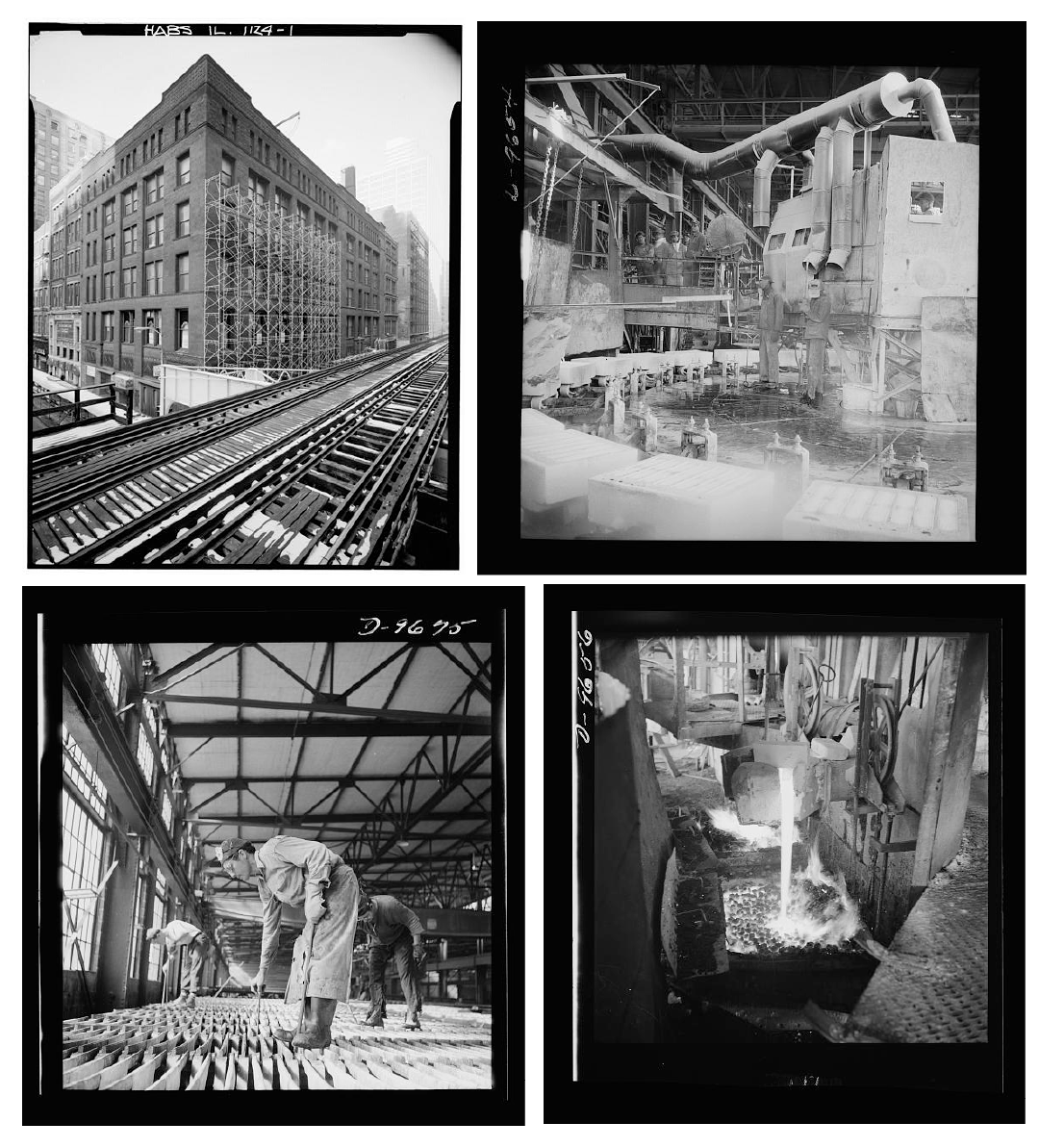
Amelia Engelder, the future Hand of the Cause Amelia Collins, married a mining engineer named Thomas H. Collins. They moved to Bisbee, Arizona and Thomas’ mining endeavors were so successful he founded the Phelps-Dodge Mining Company, still in operation today. These four photographs show the extent of the Phelps-Dodge mining company’s operations and why Hand of the Cause Amelia Collins was in a position to give such immensely generous and sacrificial gifts to the Guardian. Top left: Phelps-Dodge-Palmer Building, 200 West Adams Street, Chicago, Cook County, IL from Library of Congress. Top right: Here sheets of pure copper, formed by electrolysis, are melted and cast into ingots. Large amounts of copper are produced for the war effort at the El Paso, Texas plant of Phelps-Dodge Refining Company from Library of Congress. Bottom left: Electrolytic tanks in a large copper refining operation. Sheets of pure copper are formed by electrolysis, later melted and poured into ingots. Large amounts of copper are produced for the war effort at the El Paso, Texas plant of Phelps-Dodge Refining Company from Library of Congress. Bottom right: Pouring copper ingots at a large copper refining operation. Large amounts of copper are produced for the war effort at the El Paso, Texas plant of Phelps-Dodge Refining Companyfrom Library of Congress. from Library of Congress.
Amelia Collins had moved to Haifa in 1950 and spent the rest of her life in the Holy Land. She lived in a room in the Master’s house just beneath the beloved Guardian’s room, and one night, she noticed the light was still on in Shoghi Effendi’s room. A few hours later, past midnight, the light was still on when she woke up. Five hours later, at 5:00 AM, the light in the Guardian’s room was still on.
Amelia Collins realized something must have been deeply troubling Shoghi Effendi for him not to even get a single hour’s sleep. A few hours later, in the early morning, Amelia Collins knocked on Shoghi Effendi’s door and asked permission to enter.
When she walked in, she asked Shoghi Effendi:
Beloved Guardian, you didn’t sleep at all last night. What is happening; what is wrong?
The Guardian replied he had been busy and praying, but Amelia insisted that he share with her what was burdening him. After she had greatly insisted, the Guardian said:
There is a piece of property, blessed by the foot-steps of Bahá’u’lláh, belonging to the Israeli Government, which has put it on the market for sale. The Christian community is quite interested to purchase it but the government has told them that they own a lot of properties on which they have not done any improvements, but Bahá’ís improve any property they acquire; so this property would first be offered to the Bahá’ís and only if the Bahá’ís do not buy it, it would be sold to the Christians. The Government has offered it to me for sale and I would like to acquire it for a house of worship but I do not have the funds and do not wish to write Iranian friends again to send money. The time is short. I am concerned as the deadline is next Thursday and if I can’t buy it the opportunity is lost.
The Guardian was speaking about the Temple Land, and a miracle was about to occur.
Amelia Collins requested permission from the Guardian to leave. She immediately headed to the telegraph office and sent an urgent wire to Argentina, asking her agents to sell her mining shares immediately.
Amelia Collins was very wealthy, at the head of a significant estate, which she primarily expended upon the Bahá'í Faith. She herself lived simply and served the Guardian, and she donated generously to funds, for purchases of Temple lands and national Bahá'í Centers, but this was of an entirely different order.
Amelia Collins gave the Guardian $108,000 for him to purchase the Temple Land.
In today’s currency, Amelia Collins’s donation would be equivalent to more than $1.2 million dollars.
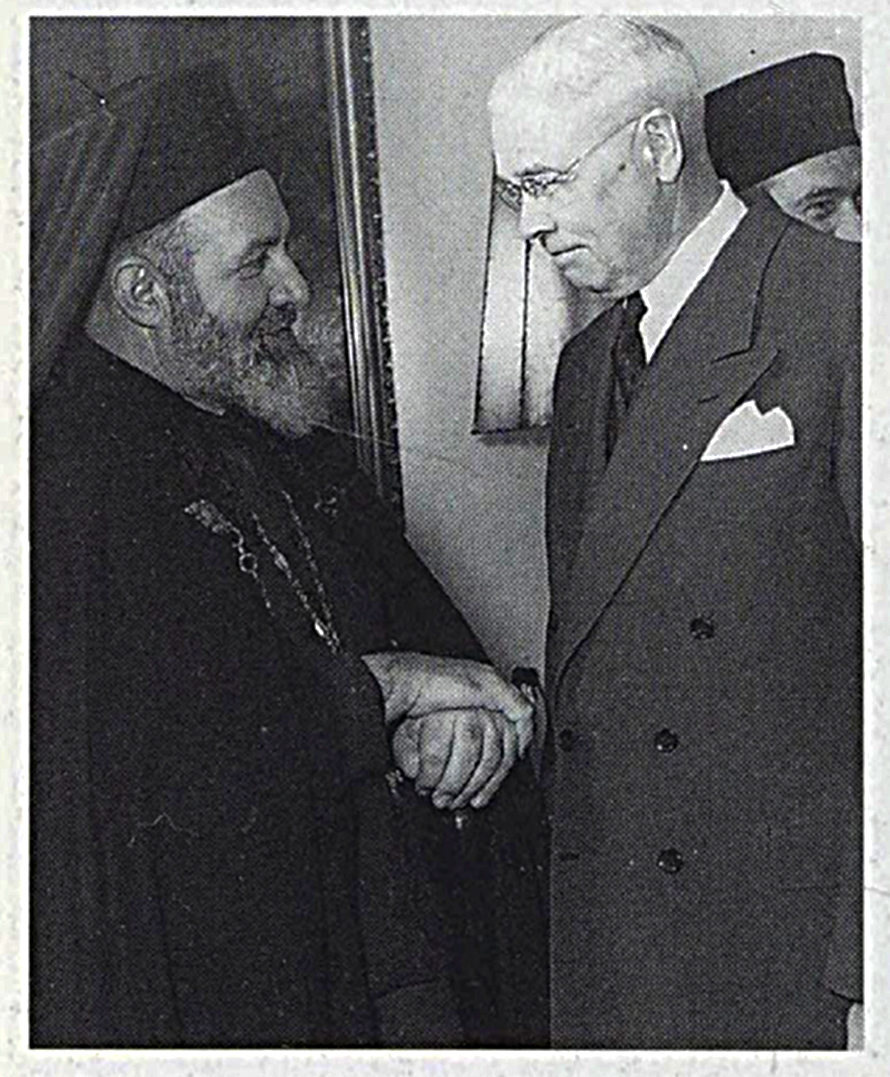
No photographs of Hand of the Cause Leroy Ioas were found with Carmelite monks, but this is a photograph of Leroy Ioas shaking the hand of an Orthodox priest. Leroy Ioas: Hand of the Cause of God by Anita Ioas Chapman, between pages 274 and 275.
On yet another one of the many fronts in his battle to obtain the Temple Land for the Guardian, Leroy Ioas was making headway in his negotiations with the Carmelites. They had finally agreed to a price for the Temple Land, which, through the grace and blessings of Bahá'u'lláh, was within the amount that Amelia Collins had offered to Shoghi Effendi for this purpose.
The contract was signed.
The Carmelites’ land representative in Israel traveled to the Vatican to have the sale confirmed but returned two months later with bad news: The Vatican said they could not do business with the Bahá'ís because the Carmelite property could not be sold to another religious organization.
Two years of arduous, non-stop work and negotiations were simply gone. Everything had been for nothing.
Leroy Ioas wrote to Amelia Collins:
You can imagine how low that made me feel. No one here to discuss the matter with and under pressure from the Guardian not to bother him with anything that is not absolutely necessary.

The spot on Mount Carmel chosen by the Guardian as the site of the future Mashriqu’l-Adhkár of the Holy Land, on the spot blessed by Bahá'u'lláh’s footsteps, where He revealed the Tablet of Carmel and near where He pitched His tent. Source: Bahaimedia.
One night, when the plan had been conceived, the Guardian asked Leroy Ioas if he thought they could get this land. Leroy Ioas replied that he thought it should be possible and that he would look into it. By this point, Leroy Ioas knew full well that once the Guardian decided on a course he went forward as if it had already been accomplished.
There was no time to lose.
A few days later, the Guardian called Leroy over to the Master's house and said he wanted to drive up and take a look at the Temple Land. During their drive up Mount Carmel, the Guardian told Leroy Ioas:
This is a historic day because today we are going to select the site for the Temple.
The Guardian walked over the entire area, indicating to Leroy Ioas which plots were essential and which were not and ended up picking out the most difficult area to acquire, on the highest point of the mountain, and indicated to Leroy Ioas the exact spot where the heart of the Temple should be.
Leroy Ioas picked up a large stone and placed it where the Guardian had indicated. The location of that stone is where the Obelisk stands today.
They returned to the car, and drove back down the mountain, when the Guardian told Leroy Ioas:
Now, the Guardian said, you must get busy and buy that land.
In a message the Guardian sent to the Bahá'í world in April 195, he made the momentous announcement that the spot for the Temple Land in Haifa had been selected:
The site for the first Mashriqu’l-Adhkár of the Holy Land has been selected—an area of approximately twenty thousand square meters—situated at the head of the Mountain of God, in close proximity to the Spot hallowed by the footsteps of Bahá'u'lláh, near the time-honored Cave of Elijah, and associated with the revelation of the Tablet of Carmel, the Charter of the World Spiritual and Administrative Centers of the Faith on that mountain. Funds totaling one hundred thousand dollars have, moreover, been contributed by one of the Hands of the Cause, residing in the Holy Land, and negotiations have been initiated with the Israeli authorities for the purpose of effecting the immediate purchase of the selected site.

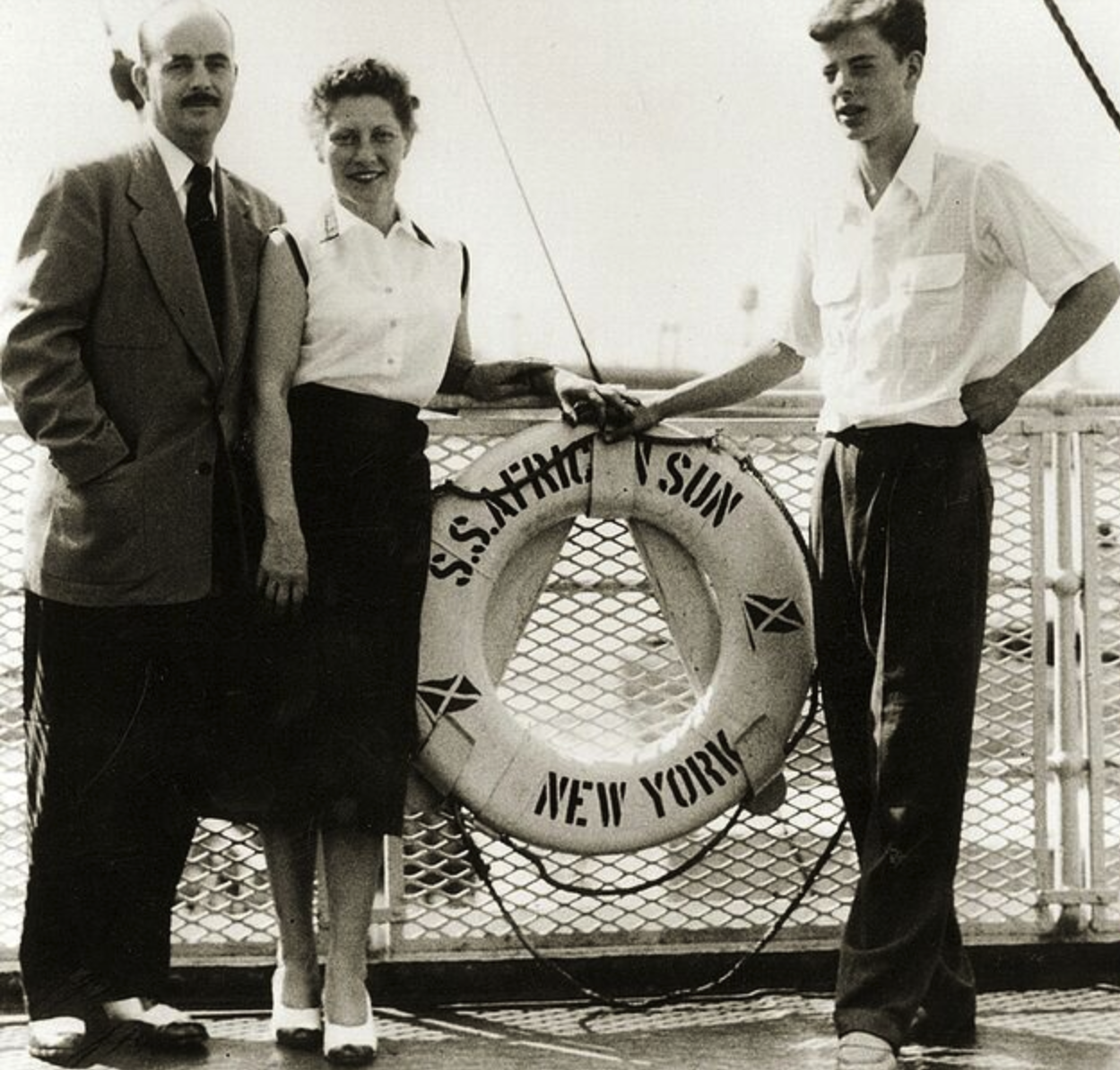
William (Bill) Sears (left), his wife, Marguerite, and son Michael—absent from photo is the Sears' other son, Billy—sailing to their pioneering post in South Africa in 1953 during the Ten Year Crusade. Source: Bahaimedia.
William Bernard Patrick Michael Terence Sears was born of Irish Catholic parents on 28 March 1911 in Duluth, Minnesota. When Bill Sears was 18 months old, on 20 September 1912, at the exact time that 'Abdu'l-Bahá was giving a talk in Minnesota, where Bill was living, he began having a series of dreams about 'Abdu'l-Bahá—whom he called “The Shiny Man” as a child—giving Bill specific instructions:
Fish like Peter. I'm waiting for you, search for me. Be like Peter. Fish.
Bill was deeply spiritual and in a state of constant search from his early childhood. He became a successful playwright, sportscaster and television writer and director. One day, he met Marguerite Reimer and fell in love with her. His life would never be the same.
They were married, but Bill was skeptical about Marguerite’s Bahá'í Faith. Then, Bill Sears began dreaming about 'Abdu'l-Bahá again, and this time, 'Abdu'l-Bahá was showing him a city.
When Bill and Marguerite moved to Salt Lake City, Bill recognized the city from his dream and he started telling Marguerite about the “Shiny Man” he had seen since his early childhood. When they arrived at home, Marguerite handed Bill a photograph of “the Shiny Man” and Bill saw the “Shiny Man” who had been there for him at every step of his life: the same white beard, soft as silk, the same flowing white robes and smile of eternal kindness, he told Marguerite:
This is the man.
Marguerite told Bill:
That is 'Abdu'l-Bahá.
Bill Sears became a Bahá'í almost immediately after. His career exploded, he was earning a huge salary, and he was very popular, and then, all of a sudden, in 1953, Bill Sears gave everything up and he and Marguerite pioneered to South Africa at the outset of the Ten Year Crusade in response to the Guardian’s call for pioneers. They settled on a farm 25 kilometers outside of Johannesburg, raised peacocks, and grew fruits and vegetables, preparing food and cakes from their crops. Their farm was a permanent Bahá'í open house. Despite tick fever, broken ribs, a coronary, Asian flu, malaria, hepatitis and being nearly killed by cobras, Bill Sears loved life in Africa. He was soon on the radio again with a very popular show heard all the way in Mozambique, and began traveling through every corner of Africa to teach the Faith.
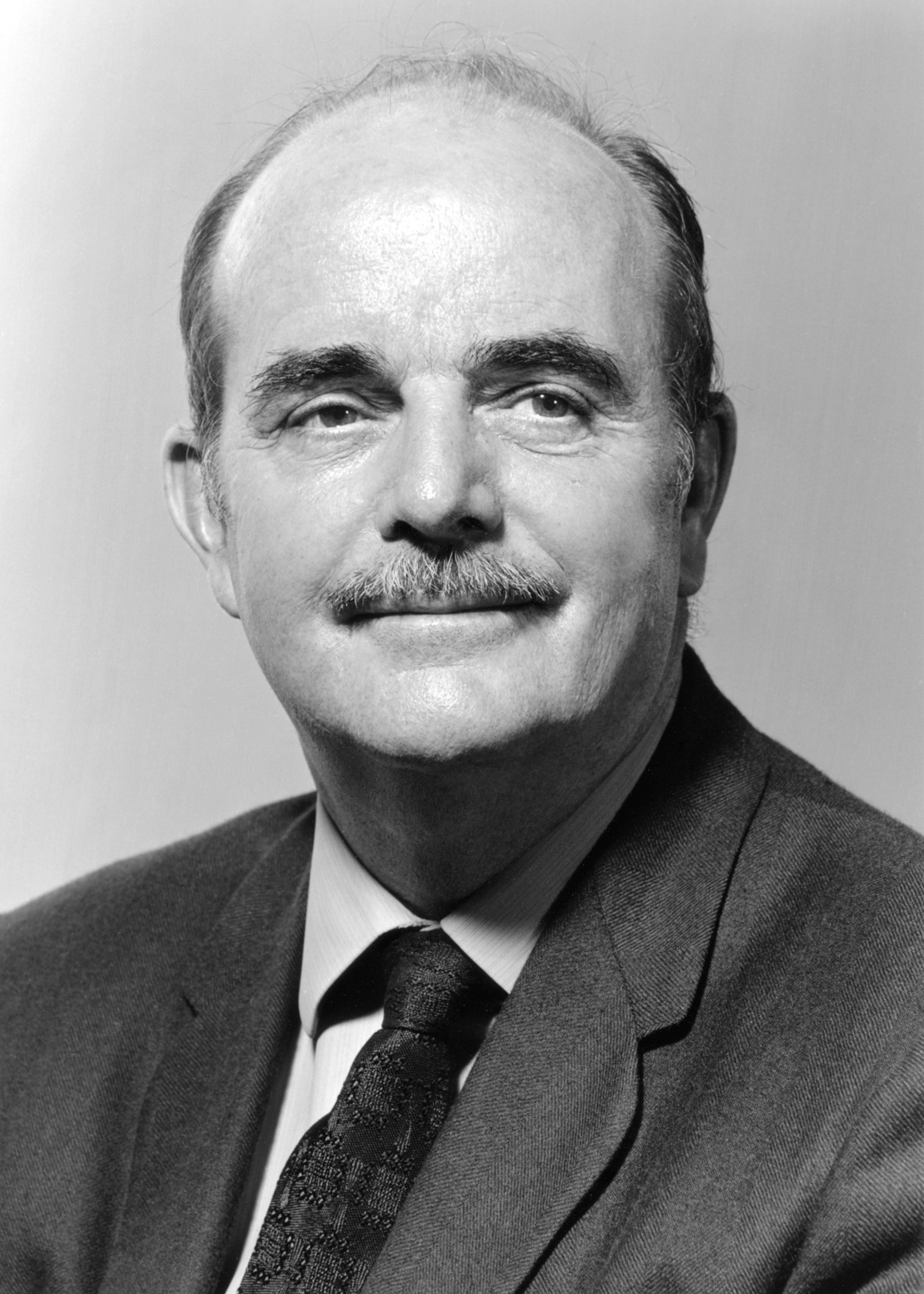
William “Bill” Sears (1911-1992). Source: Bahá'í Media Bank, © Bahá'í International Community 2023.
Future Hand of the Cause William “Bill” Sears arrived in Haifa on the morning of 1 April 1954 from South Africa with 20 kilograms of luggage, with, in his pockets and on his person, two cans of potatoes, a bottle of ketchup, a small tin of coffee, 50 Greek pamphlets, 7 notebooks, 4 bottles of sundry toiletries and a 4-kilogram electric water heater.
Bill Sears spent all day eagerly waiting to see the Guardian—swinging between his fear to stand before him and his yearning to have the courage to look upon him and tell him of his love and beg his forgiveness—recalling:
I wanted to take a long pole and push the sun down into the Mediterranean so that evening would hasten.
Darkness came that night, enveloping the Shrine of the Báb and hiding it from the pilgrims’ view, Bill Sears had spent the day in prayer preparing himself for this moment, his first dinner with the Guardian, but word soon came that Shoghi Effendi was still at Bahjí making plans to illuminate the Shrine of Bahá'u'lláh and would not be with them for dinner. Bill Sears remarked:
Haifa without the Guardian is like an eye without its sight. Dr. Luṭfu’lláh Ḥakím's whimsical comment is a virtual truth, “It is the Holy Land in his presence and the Hell-i-Land in his absence.”
With the pilgrims that night were Amelia Collins, Leroy Ioas, Mason Remey, as well as Rúḥíyyih Khánum, who was so kind and loving. She knew the inner disappointment that each pilgrim tried not to show, and the Hands of the Cause showered the pilgrims with love.
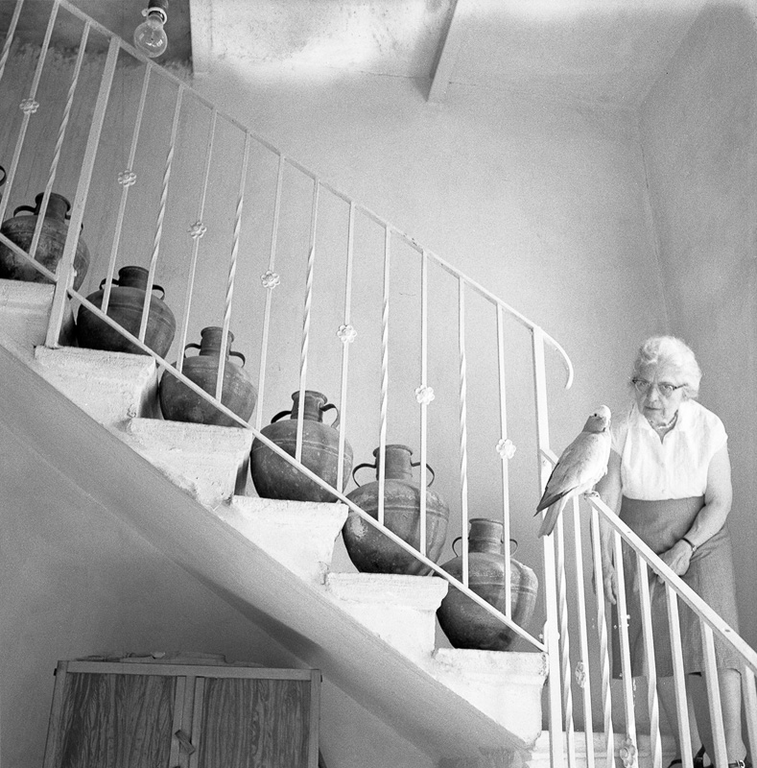
Jessie Revell and Tutti the Parrot on the staircase of the Western Pilgrim House, at the bottom of which Bill Sears meets the Guardian in the story below. Photograph taken by Arthur L. Dahl, and part of the © Gregory C. Dahl collection, used with permission for non-commercial purposes. Source: Gregory C. Dahl.
After dawn prayers at the Shrines, weed-pulling in the garden, a joyful laughter-filled lunch, writing in his journal, transferring books for a new library, tea, and getting ready for his first dinner with Shoghi Effendi, Bill sears was in the upstairs north sitting room of the Western Pilgrim House when there was scurrying around, the quick sound of footsteps, and a light tap at the door:
He is here!
The words Bill Sears had been waiting to hear for 36 hours. The quiet Pilgrim House instantly came to life, all the pilgrims rushed downstairs in a single file and the first words Bill Sears heard the Guardian speak were to the woman pilgrim in front of him, blocking his view. The Guardian shook her hands and said:
Good evening
After the woman had stepped aside, there was nowhere for Bill Sears to hide, and his eyes met the Guardian’s, who greeted him as he had greeted his fellow-pilgrim:
Good evening.
Bill Sears could never remember exactly how he had responded, because immediately after, something infinitely more memorable happened: he saw Shoghi Effendi come before him and soon, he was in the Guardian’s embrace:
We have been expecting you for a long time. We have heard much about you. Now we are happy that you are with us at last.
The Guardian kissed Bill Sears first on the right cheek, then on the left, and Bill Sears hung to the Guardian tightly, his chest hurting, his throat tightened, his eyes welling up with tears and thinking “I have come home.”
Bill Sears was seated directly opposite the Guardian, so close he could have reached over and touched his hand. When he looked around table, he realized he wasn’t the only one with tears in his eyes: all the pilgrims’ eyes were misty, each of their hearts knotted to each other, sharing in the ecstasy of meeting the Guardian for the first time.
Bill Sears felt what he described as a transcendental happiness, watching the Guardian with wrapt attention and increasing devotion. Shoghi Effendi asked about Bill Sears’ journey and his usual brilliant eloquence and silver-tipped tongue—he had, for decades earned a living through his wittiness—utterly failed him, he was, as he rarely ever was, speechless, but he realized the Guardian would never have been swayed by a witty or clever retort. He could only be impressed—or his judgement influenced—by one thing: service to the Faith.
During his pilgrimage, Bill Sears realized that his life was changing, and that his former concepts of the Faith, of service, were changing forever, and he began to fear that transformation, afraid of it not being permanent. He remembered the Hidden Word by Bahá'u'lláh which stated:
O MY CHILDREN! I fear lest, bereft of the melody of the dove of heaven, ye will sink back to the shades of utter loss, and, never having gazed upon the beauty of the rose, return to water and clay.
Bill Sears knew that by meeting the Guardian he had “gazed upon the beauty of the rose,” and he desperately did not want to “return to water and clay.” But Bill Sears was also confident in the process of pilgrimage, he gave it a great deal of thought and came to the conclusion that, having seen the light, the true pilgrim would, forever, find darkness abhorrent, and that, indeed, was the purpose of true pilgrimage. The Guardian, before leaving, told the pilgrims, his head nodding up and down as he spoke, his loving eyes bestowing a glance on each pilgrim:
I hope you have a good night's rest. Tomorrow you will go to Bahjí, to the Shrine of Bahá'u'lláh. Yes.
And then, Shoghi Effendi was gone.

“Shoghi Effendi is like the rays of the sunlight. He exposes whatever subject matter is latent on the inner film of each pilgrim. The same sun in the same field on the same day will warm and raise up many different flowers.” Photo by Carl Jorgensen on Unsplash.
Bill Sears was a rare pilgrim with a gift of seeing clearly the Guardian and his work, a rare pilgrim to have left utterly recreated, and an even rarer pilgrim to have the ability to eloquently put words on feelings that were not only transformational, spiritual, but which, for most pilgrims, would have been impossible to describe. This is how Bill Sears describes the effect of the Guardian on everything and everyone:
Shoghi Effendi is like the rays of the sunlight. He exposes whatever subject matter is latent on the inner film of each pilgrim. The same sun in the same field on the same day will warm and raise up many different flowers.
Bill Sears revisited this tremendously fascinating idea of the Guardian having a different effect on everyone, and developed it, coming to the conclusion that—possibly like the sun—everyone saw a different Guardian based on their own condition and requirements:
He is different things to different people, I feel sure. He is a different Guardian to the same people on different days. Yet you feel that he is always the same at the center. He is like an ocean.
What Bill Sears came away with, in a nutshell, after nine days in the presence of the Guardian, was that pilgrimage and the presence of the Guardian were the gift, and repaying that gift was service to Bahá'u'lláh—and the Guardian, and the Ten Year Crusade—in the field:
The Guardian calls you to a higher service. He lifts you up to heights of limitless joy, then sets you gently down. Having revealed the treasure, he requests the payment, which is service to the Faith of God.

“He is truly the Sign of God on earth. He is the present form of the Most Great Ocean of Bahá'u'lláh.” Photo by Matt Hardy on Unsplash.
One of the most beautiful things Bill Sears ever wrote during his pilgrimage is about the oceanic, universal presence of the Guardian and how it relates to the Covenant, which ‘Abdu’l-Bahá had likened to the ocean. Bill Sears speaks about the ocean as a shelter for the fish who faithfully live inside the Covenant, but as a storm of destruction for Covenant-breakers:
A shelter for the fish who live upon his bounty, a storm of destruction. for those who sail against his tide or into forbidden waters. He is truly the Sign of God on earth. He is the present form of the Most Great Ocean of Bahá'u'lláh. `Abdul-Baha told us that the Covenant was this ocean.
If we live within its strengthening grace, we prosper as fish gain strength in the waters of the sea. If we venture beyond its waters, we perish. If we do not feed upon its waters, we die within the sea itself, and, like dead bodies in the ocean, the waves of God spew us up and wash us onto the sands to wither and waste away.
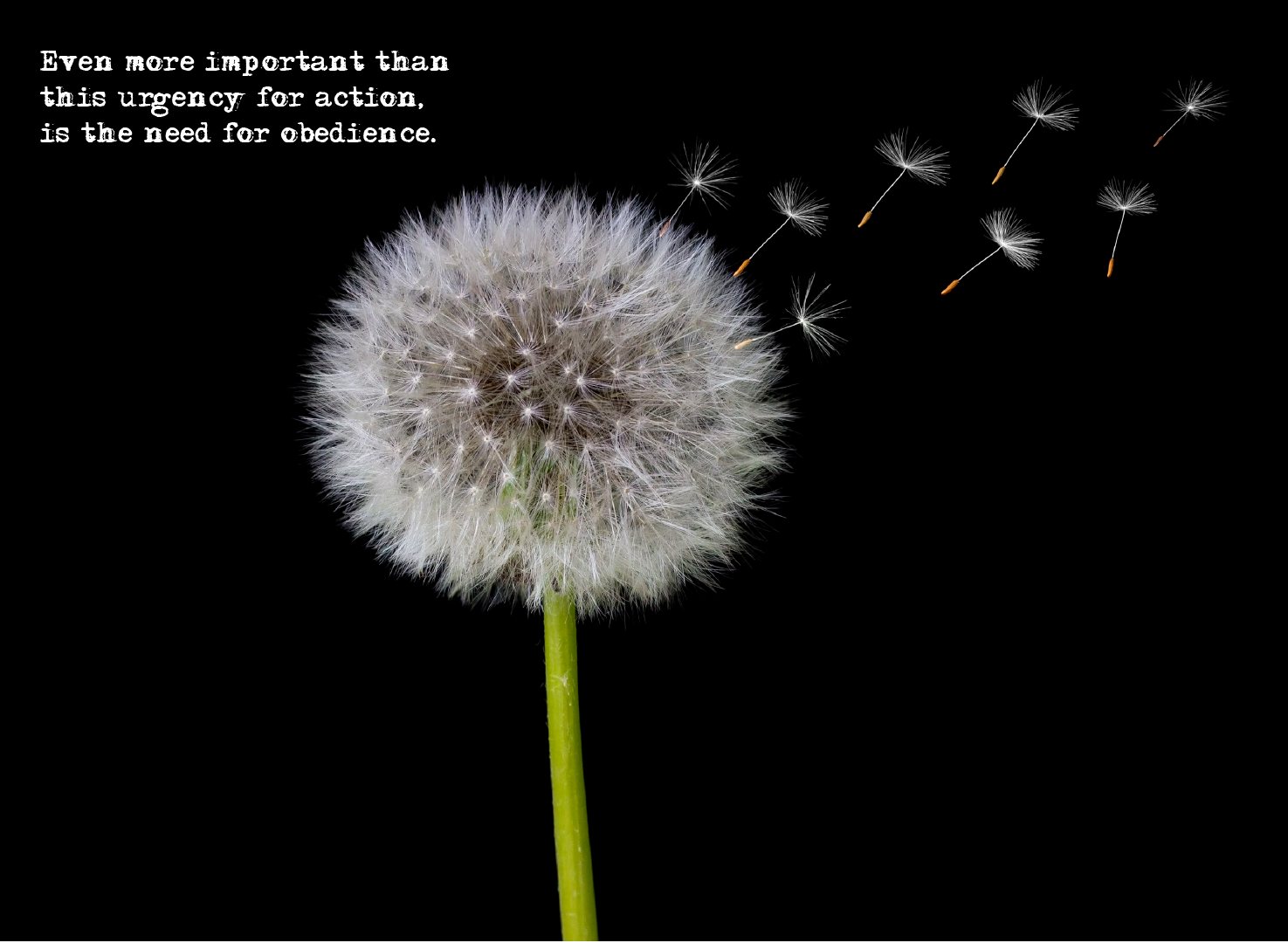
“Even more important than this urgency for action, is the need for obedience.” Photo by Herbert Goetsch on Unsplash.
Bill Sears was struck during his pilgrimage by the importance of obedience in relationship to service and immediate action—yet another hallmark of his spiritual maturity and depth as a Bahá'í:
Even more important than this urgency for action, is the need for obedience.
In His Will and Testament, Bahá'u'lláh had commanded obedience to 'Abdu'l-Bahá on the part of all Bahá'ís, especially the male relatives of the Báb and Bahá'u'lláh to “turn, one and all, their faces towards the Most Mighty Branch,” and in 'Abdu'l-Bahá’s Will and Testament, he had also ordered the obedience of all Bahá'ís to the Guardian, stating emphatically “the beloved of the Lord must obey him and turn unto him. He that obeyeth him not, hath not obeyed God.”
Bill Sears linked obedience to effective service: with obedience, service was effective, without obedience it was either a failure or a partial success, but never a full success:
You know now that there can be no partial obedience to God. If there is, you have only a partial understanding of the Faith, and you get only partial results. you have investigated and made your choice; exercised your independence in coming to the Faith.
Bill Sears knew, one year into the Ten Year Crusade that now, more than ever was the time for obedience. Bill Sears does not make this comparison, but he arrived on pilgrimage on year after the Ten Year Crusade was inaugurated. A Crusade implies a conquest, a conquest implies a general and his soldiers. without obedience from soldiers—Hands of the Cause, Knights of Bahá'u'lláh, Auxiliary Board Members, Bahá'í pioneers and individual believers—how can the General—the Guardian—spiritual conquer the planet? Here are Bill Sears’s words:
We must be like the great cypress trees standing outside the Shrine of Bahá'u'lláh. They bow and bend low before the breeze of God from whichever direction it may blow.
With all these profound realizations, the fear in each pilgrim’s heart—but especially in Bill Sears’, was to not live up to the transformations and realizations, the bounties of pilgrimage:
Your only fear now is that you may fall short of the possibilities he had made you see in yourself.
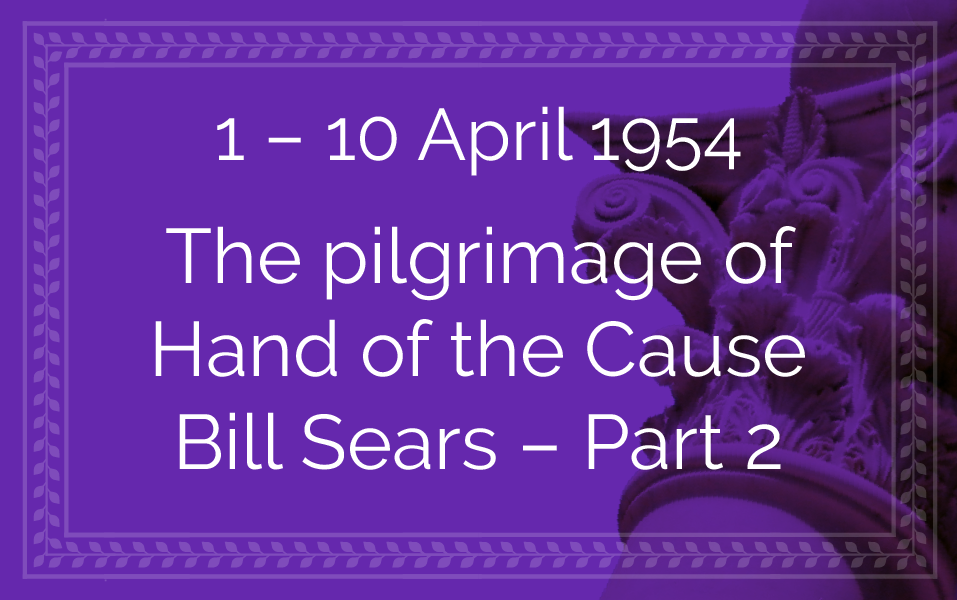
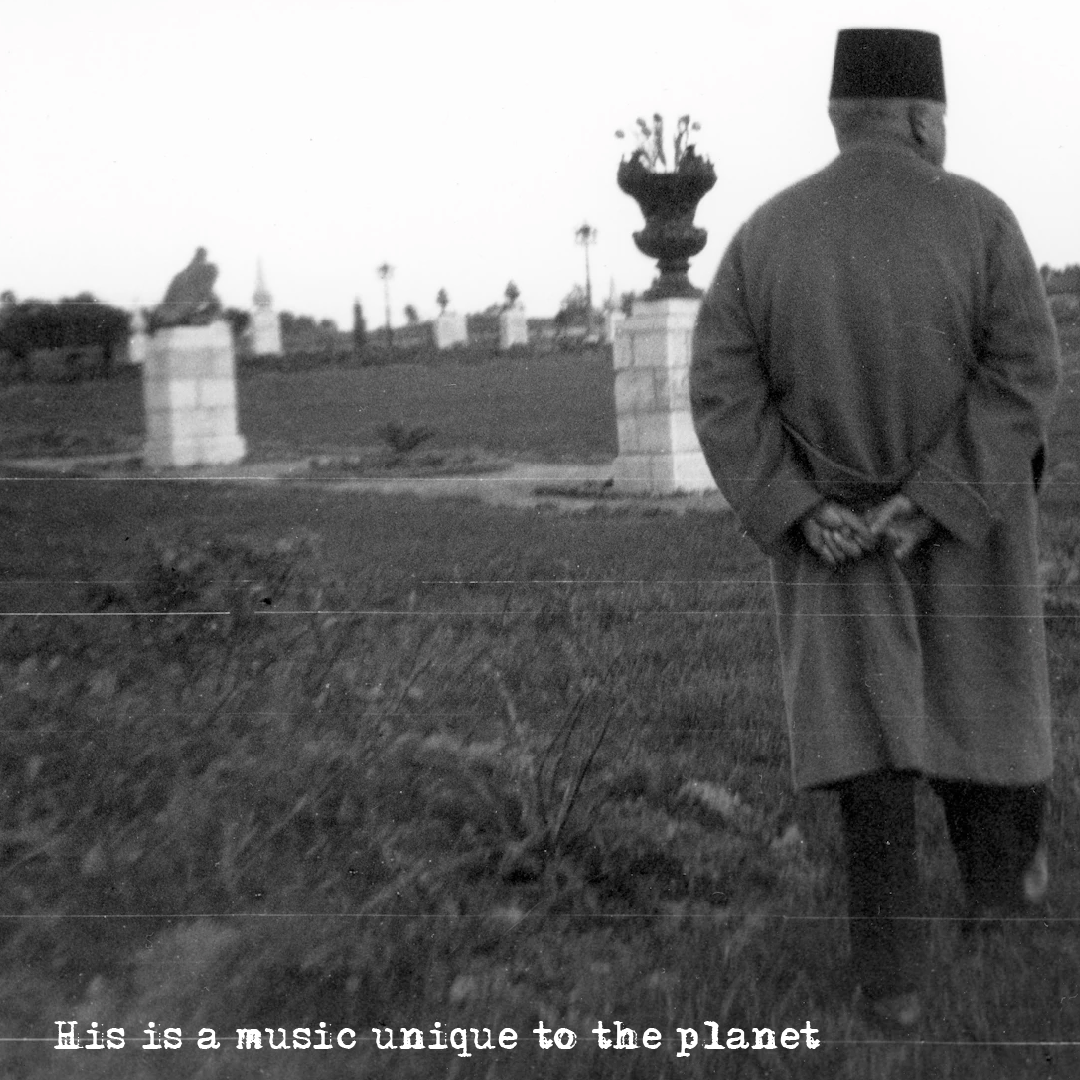
“His is a music unique to the planet.” Shoghi Effendi surveying the gardens at Bahjí, 1950s. Source: Bahá'í Media Bank, © Bahá'í International Community 2023.
Shoghi Effendi was impossible to fully, perfectly, adequately describe because he was the Guardian. In Bill Sears’ analysis:
His is a music unique to the planet. It is a spiritual language which transcends even a musical language. `Abdu'l-Bahá said there was a spiritual language as different from our language as ours is from the cries of animals. This is the language of the presence of the guardian. It cannot be expressed, it must be experienced. What is written here is but the shadow of the reality. Only a pilgrimage of your own will clothe it in flesh. If you have seen him, you will understand this.
Bill Sears said the Guardian was short in stature but with a very strong, firm and sturdy, which he had felt during his long hug.
Shoghi Effendi’s eyes were dark but when he became animated, they turned a lighter shade. His face was clean-shaven except for a small, dark mustache, and he had beautiful, regular features, a medium to dark complexion, and dark hair, greying on both sides—at the time Shoghi Effendi was 57 years old.
The most striking feature of the Guardian’s physical appearance to Bill Sears was his latent energy:
There is an energetic quality about his person, even when at rest.
Bill Sears was impressed with the Guardian’s hands:
He has very small, slender hands which are shapely and expressive. All of his gestures are extremely graceful.
Shoghi Effendi often dressed the same, and many pilgrims described him wearing these exact clothes: a rust-colored coat, a brown tie, a black fez, a slender gold Bahá'í ring on the second finger of his right hand.
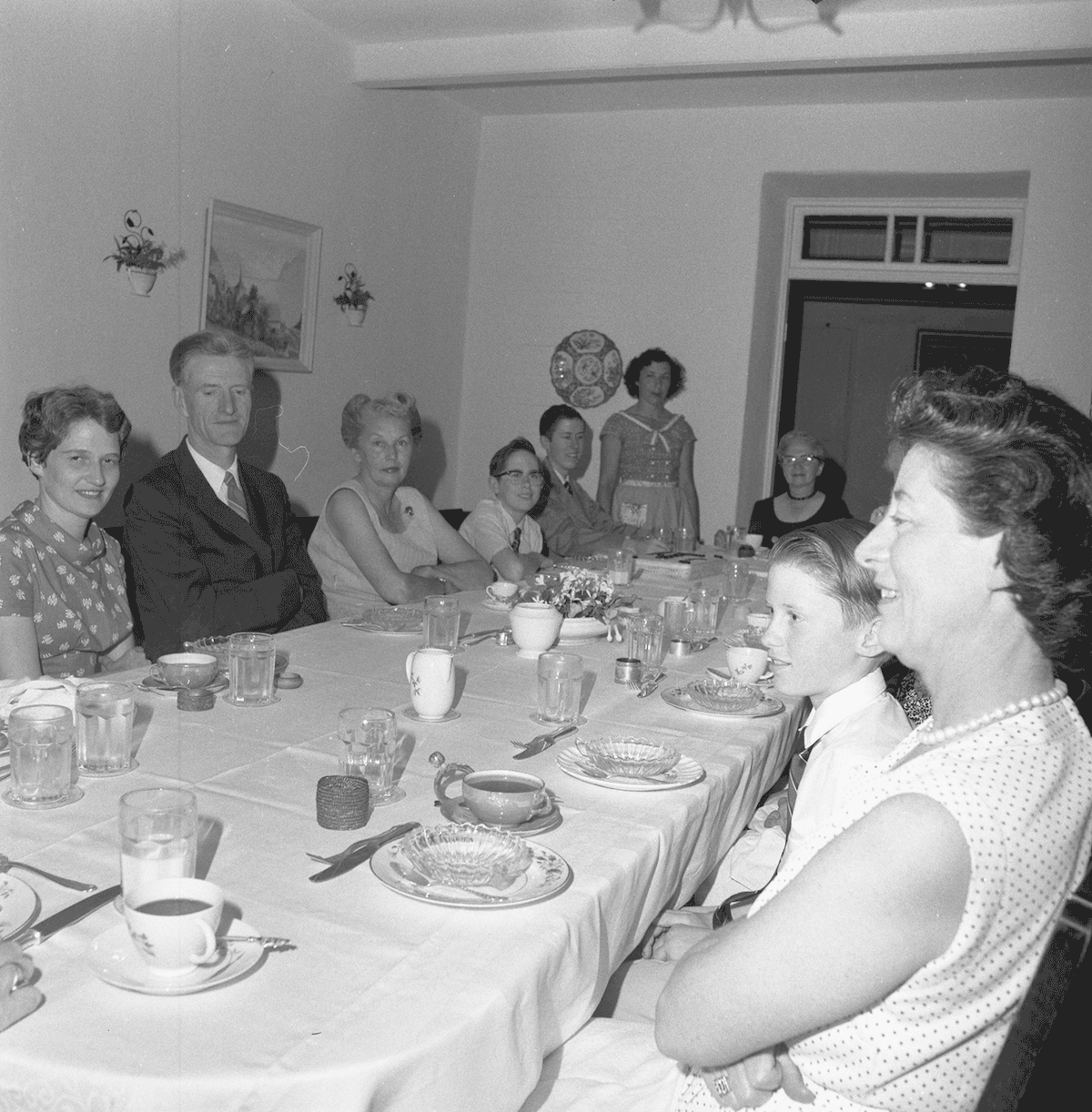
Dinner in the Western Pilgrim House in 1960, second photograph of a series of two, the first photograph was placed in the chronology in part 17. Doris Holley is sitting at the end of the table To Doris Holley’s right, and on our left are Keith Dahl, Roger Dahl—the birthday boy—Marjorie Haney, and her husband Hand of the Cause Paul Haney. On the very right-hand edge of the photograph is Joyce Dahl, Roger’s mother, with her other son Greg to her right. Detailed caption provided by Greg C. Dahl. Photograph taken by Arthur L. Dahl, and part of the © Gregory C. Dahl collection, used with permission for non-commercial purposes. Source: Gregory C. Dahl.
The dinner table at the Western Pilgrim House was long and narrow, seating ten people comfortably. The most recent pilgrim to arrive was always seated at the seat of honor, at the head of the table, and Rúḥíyyih Khánum always sat to the Guardian’s immediate right.
At every dinner, the Guardian brought with him something new and exciting: a new cable, a drawing, or a document, and openly discussed the work of the Faith in the field and in the Holy Land with the Hands of the Cause and the Members of the International Bahá'í Council.
Bill Sears realized he was blessed during his pilgrimage because Shoghi Effendi was happy throughout his nine days in the Holy Land. The work of the Faith in the field was progressing well and that was always, as Bill Sears said “the barometer of [the Guardian’s] spirits,” and Bill Sears remembered him laughing and chuckling and on two occasions, bursting into loud, hearty laughter. The Guardian’s joy carried everyone’s spirits on it, like a sailboat on a soaring wave.
The Guardian was overjoyed when he received news of three virgin territories opened to the Faith in West Africa and—as always, the Guardian carried all the Faith’s statistics in his mind—he said:
Now, we have opened two hundred and twenty-five countries to the Faith.
The Guardian was very expressive when he talked, nodding his head as if to say “Yes, it is true,” and he never used the words “I” or “me,” but always inclusive, using “we” or the “the Bahá'ís” or “the Faith,” instead. The Guardian’s language was particularly delightful to the professional writer and speaker in Bill Sears:
No one speaks English as Shoghi Effendi speaks it. There may be a moment's hesitation as he searches for a word, but each time he brings forth a jewel that inspires a quiver of delight.
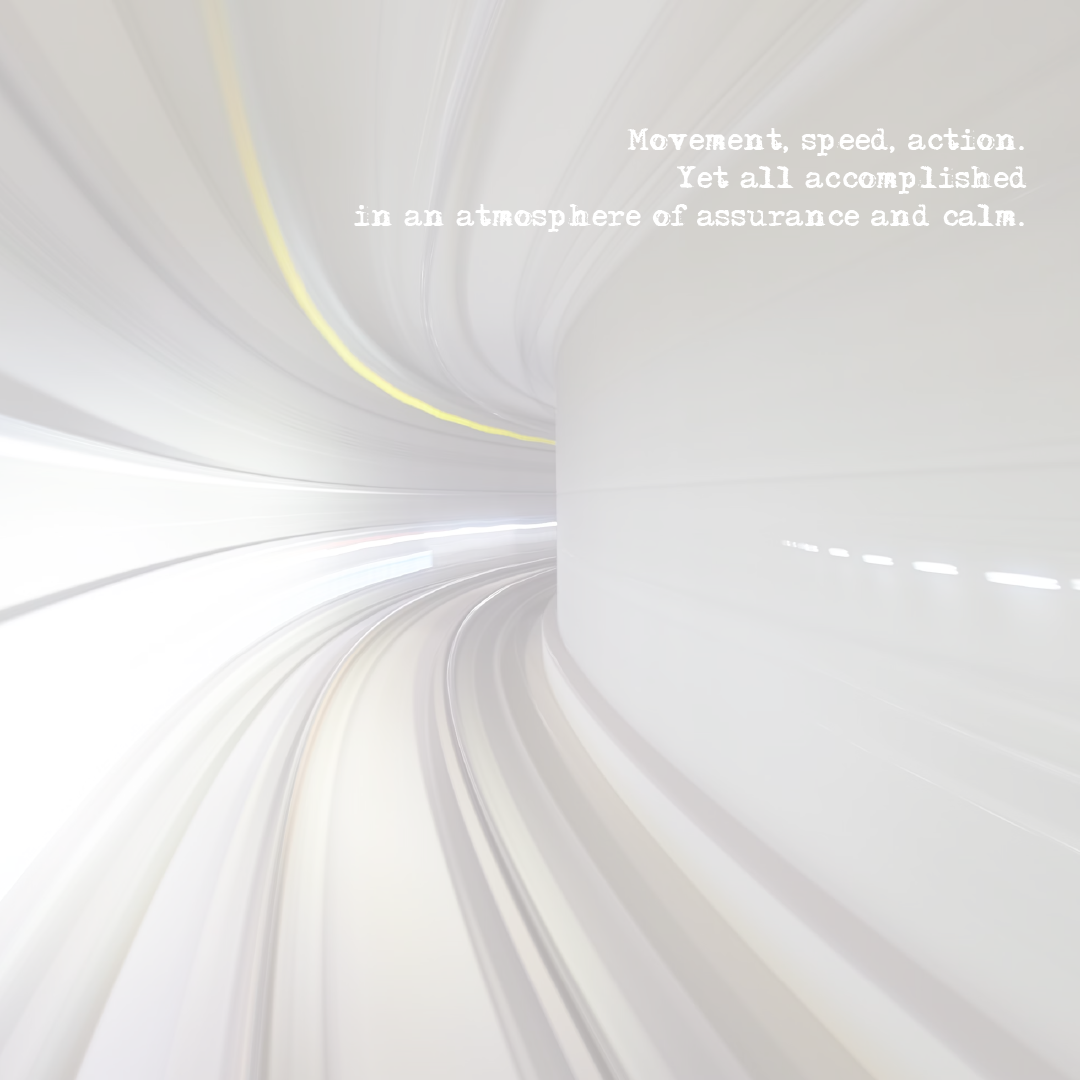
“Movement, speed, action. Yet all accomplished in an atmosphere of assurance and calm.” Photo by Mathew Schwartz on Unsplash.
The Guardian’s energy was what impressed Bill Sears the most:
The overpowering feeling of motion which you associate with the Guardian, never leaves you after that first meeting…Movement, speed, action. Yet all accomplished in an atmosphere of assurance and calm.
The Guardian’s energy had a direct effect on the pilgrims themselves:
The closer we are to him, the more active we become, the more accelerated our pace; yet, the more sublime our attitude and the less panicky our methods.
But Bill Sears was conscious that the energy of the Guardian in person was nothing compared to the energy he deployed across the earth for the Ten Year Crusade:
The guardian moves across the vast spaces to be conquered by the Faith as a cyclone moves. Its speed is astounding, yet at the heart of the cyclone all is at peace as it moves.
The presence of the Guardian was something Bill Sears felt strongly, not only energy but warmth:
This is what it is like to be in the presence of the Guardian. He is the power of electricity that can heat, warm, comfort and light our lives, but if we misuse it we are destroyed. The breeze that cools you when you are feverish, the wind that sails your craft speeding on its way, the gentle breath that shakes the ripened fruit and drops them at your feet is the gale, the hurricane that rushes in to crush what has become a vacuum.
It is astounding how much Bill Sears felt of the Guardian in nine short days, he was exceptionally sensitive to his presence, extremely affected by his energy:
You can feel the heat of his pace, you are shaken by the draft of his passing. You can see the light of his spirit. He is a giant comet that blazes across the sky, drawing into his orbit all the bits of matter that can feed the flame of his fire.
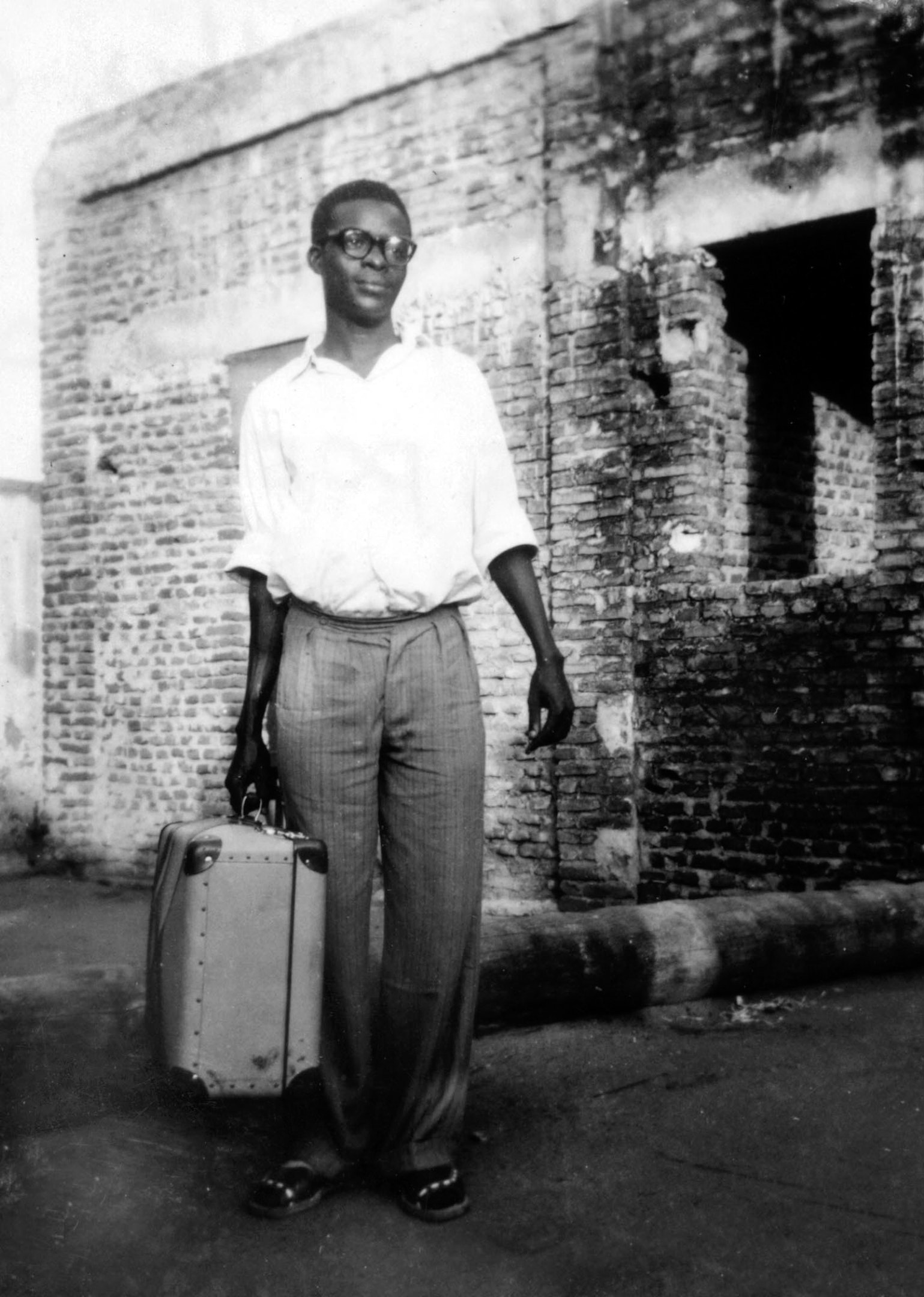
Early Cameroonian Baha'i and pioneer James Mbu on his way to Northern Ghana in 1956. Source: Bahá'í Media Bank, © Bahá'í International Community 2023.
Pioneering and pioneers were two of the Guardian’s greatest loves, and Bill Sears understood that he suffered because Bahá'ís did not understand the concept the way he did. The Guardian said that Bahá'ís felt it difficult to leave their homes and pioneer, even if it was homefront pioneer. But the Guardian was not asking them to make a sacrifice, he said, he was protecting them from the calamity that was rushing toward them inwardly. In essence, this meant that pioneering was an inward process, not an outward one, even if that was what it looked like, superficially. The Guardian spoke about America in straightforward terms:
America is no longer even actively quarreling. They are passively stagnant.
The Guardian explained that this passivity, this stagnation, was the reason he asked them to disperse, so they could become alive again, revivified, and not wither away. The failure of American Bahá'ís to disperse and pioneer and arise to fulfill the goals of the Ten Year Crusade would cause them spiritual and material suffering.
The Guardian was so passionate about teaching during Bill Sears’ pilgrimage that Rúḥíyyih Khánum, herself, said one night:
Shoghi Effendi, if you keep on speaking so movingly, I'll have to leave and pioneer.

Windows on the Western Pilgrim House. Source: Bahá'í Media Bank, © Bahá'í International Community 2023.
Bill Sears speaks beautifully about every pilgrim’s daily dread: the Guardian leaving the dinner table:
Finally the moment of heartache comes. The Guardian pushes his ringed serviette forward for the last time. His eyes look across the table and into yours. He understands. You feel that you are an arrow pulled back to the farthest stretching point in his bow. He now has only to let go and you will speed on your way to the task he has assigned.
The pilgrims were feeling ambiguous: they wanted to keep the Guardian at their side, but they were anxious to let him leave and get on with his important work. Bill Sears describes the moment after the Guardian left the room:
When Shoghi Effendi leaves the room after the evening meal, the room becomes quite silent for some time. All eyes are watching the door through which has gone. Part of our hearts have gone with him.
Slowly, gradually, the pilgrim’s eyes leave the door out of which the Guardian has walked, deep sighs heard around the table, breathing out the last of the air they had inhaled in his presence, and gently, they begin stirring, but into a different state:
We have come back from a different world. It is empty in this one without him. You wish it were tomorrow night already. You seat yourselves at the table, or go up to the sitting room where you can repeat to each other all that he said.
These moments, Bill Sears said, moments of tenderness and love are what remains of these blessed Haifa nights when you return home. They are moments you relive again and again. By this point, Bill Sears was looking forward to rush back to his pioneer post and begin his work again.

The pathway to the Eastern Pilgrim House in Haifa near the Shrine of the Báb. Source: Bahá'í Media Bank, © Bahá'í International Community 2023.
Bill Sears’ pilgrimage affected him deeply and he came to realize that each pilgrimage is in fact two pilgrimages: one, the pilgrimage of the head and the pilgrimage of the heart:
The first is the pilgrimage of the mind; notes taken of special information, new developments of the Faith while you are present, instructions from the Guardian to be applied to one's community or one's self. This is the pilgrimage of “what the Guardian said.”
The second is the pilgrimage of the emotions: the sea that surges inside the pilgrim from the moment he catches his first glimpse of that glistening, golden dome. This is the warm flooding tide that soon will fill every empty inlet along the coastline of his spirit. This is the pilgrimage of joys, ecstasies, sorrows, shames, repentances and reformations that storm through his being. It is the first meeting with the Guardian, the first walk along the tile-red path that leads to the shrine of the Bab, the moment that holy door is swung inward for the first time and you enter the presence of the gentle, lovable Bab, the very air of whose Shrine throbs with the blood of the martyrs. This is the pilgrimage of reunion with the welcoming arms of the wonderful Master. It is above all, the awe-stricken moment when the impure heart dares to present itself before that sanctified spot where the Supreme Manifestation is enshrined. This is the pilgrimage of Bahjí, Mazra’ih, Riḍván, the house at 'Akká, the prison-cell, the sufferings, the triumphs that are relived again through the eyes of each pilgrim who looks upon this land so much beloved.
The Guardian told the pilgrims:
The pilgrimage is given to you that you may take in and then give out, to receive and then impart, to absorb and then bestow. Without this there has been no pilgrimage. It will dissolve into nothing.
The Holy Land, the Bahá'í Holy Places, the Shrines of Bahá'u'lláh, the Báb, and 'Abdu'l-Bahá, are the heart of the Bahá'í Faith, and the heart gives life, it reinvigorates the bloodstream, filling it with oxygen anew and sending it back out to the body, the brain, the arms, the legs, giving them new energy, new life.
Bill Sears thought the process was the same with pilgrimage: pilgrims came to the heart of the Faith, weighed down by the impurities of the world, they were cleansed, purified, then filled with new life and sent back to their posts and homes. Then, said Bill Sears:
In this last moment, you learn the supreme lesson; it does not matter what you have done, who you may be, what your powers, talents, and background in the Faith may have been up until now. nothing matters except your complete consecration to Bahá'u'lláh from this moment on. All else is secondary.
It was time for Bill Sears to go home.
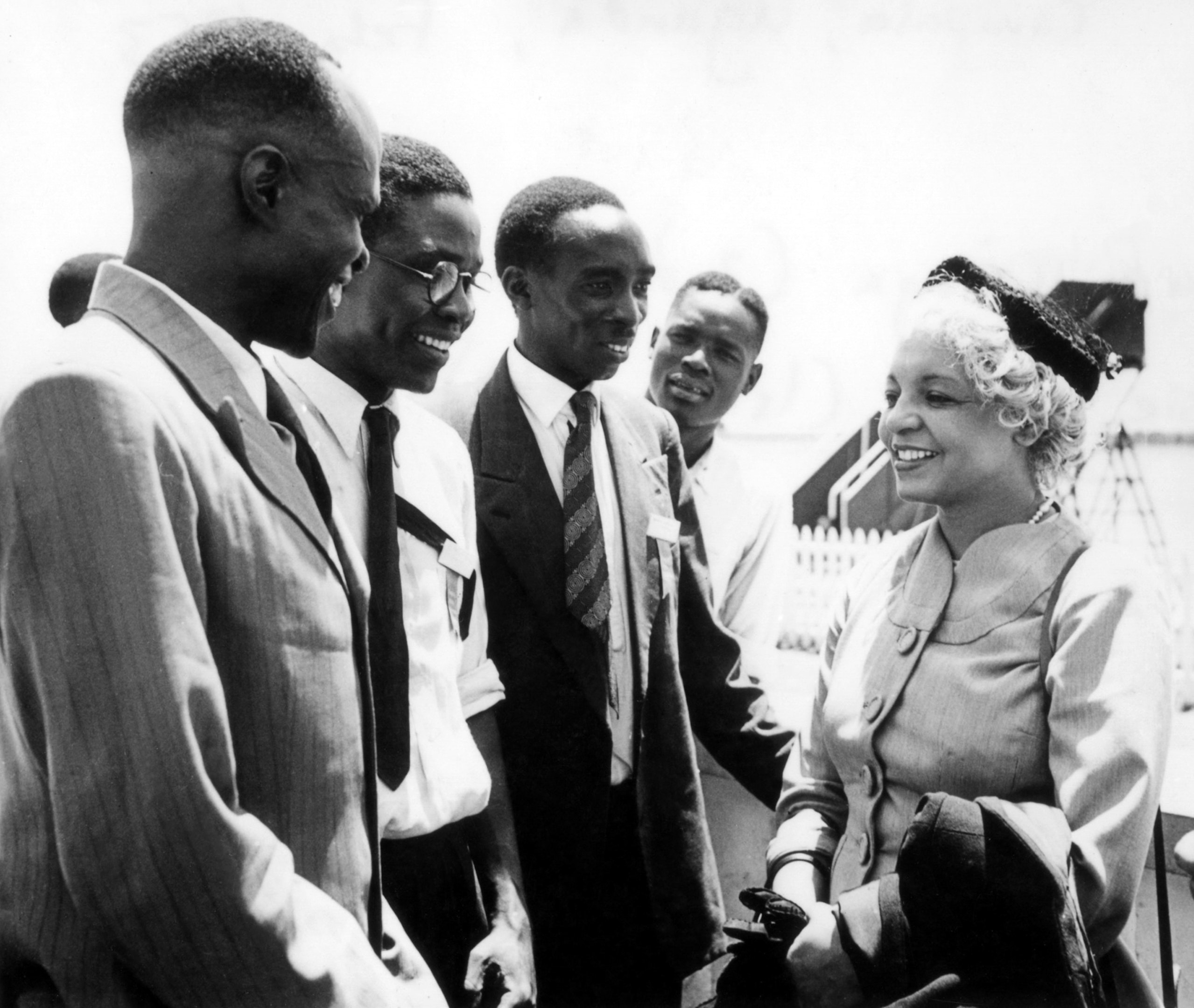
“I hope when you make your next pilgrimage, that you will bring some of your African children with you.” Enoch Olinga, later to be appointed a Hand of the Cause (second left), and Elsie Austin (right) with other African Bahá’ís at the African Intercontinental Bahá’í Conference, Kampala, Uganda, 1953. Source: Bahá'í Media Bank, © Bahá'í International Community 2023.
9 April 1954 was the last night of Bill Sears’ pilgrimage.
The Guardian came around the head of the table to take his hands in parting. Bill Sears clung to Shoghi Effendi, trying to drain courage from him. The Guardian said he would pray for the success of the teaching work in South Africa, then, he embraced Bill Sears, and kissed on the cheeks. Bill Sears pressed the Guardian to his heart, and Shoghi Effendi smiled lovingly at him:
I hope when you make your next pilgrimage, that you will bring some of your African children with you.
Then he was gone!
At 4:00 PM the next afternoon, 10 April 1954, everyone gathered on the white marble steps of the Western Pilgrim House to wish Bill Sears farewell: Rúḥíyyih Khánum, Leroy Ioas, Amelia Collins, Mason Remey, Luṭfu’lláh Ḥakím, Sylvia Ioas, Jessie and Ethel Revell, Muḥammad Tabrizi, Muḥammad Iṣfahání, Salah Jarrah, among others.
Bill Sears entered the taxi and Hand of the Cause Amelia Collins told him:
We shall pray for you.
As Bill Sears left Haifa, he watched the Shrine of the Báb through the car window, twisting his head with each turn to keep the Shrine in view until the very last second.
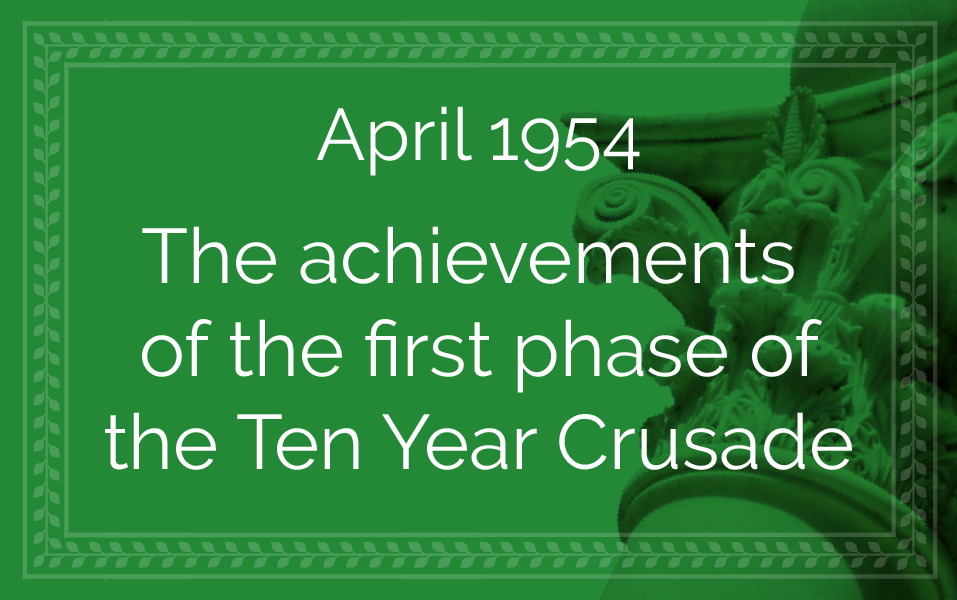
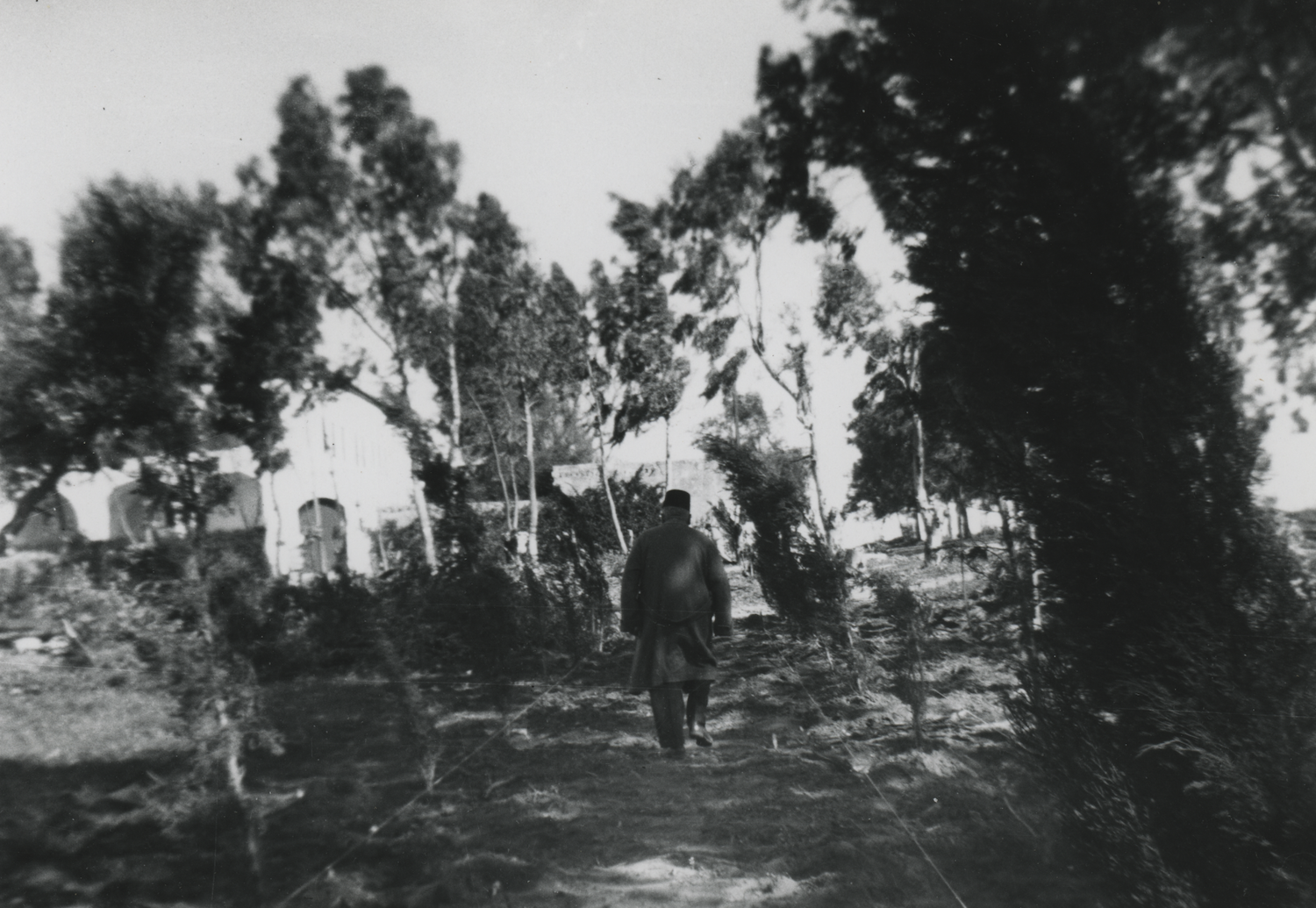
The Guardian walking a path at Bahjí in the 1950s. © United States National Bahá'í Archives, used with permission.
In the Spring of 1954, a year after Shoghi Effendi had designed and created the gardens at Bahjí , there were torrential rains, a deluge of water that lashed the ground propelled by a strong northeast wind, and a good part of Shoghi Effendi’s new garden was flooded.
It was urgent to find a solution, and Shoghi Effendi conceived a brilliant plan to build an impediment to the rain in the form of a large embankment made of solid earth with no mortar which would prevent another flood.
The embankment also provided a great height from which the entire garden could be admired, and Shoghi Effendi quickly added a second embankment, and planned for a third, which would be built after his passing.
The Guardian added gates and steps for pilgrims to climb onto the embankment, as well as three broad paths, one on each of the three terraces, bordered with cypresses.
Soon after, Shoghi Effendi landscaped the three-terraced embankment with row upon row of geraniums, making the ground look like it was on fire with their countless ruby-red blossoms. By 1954, the Guardian had added smaller, wrought-iron gates and dozens and dozens of lamp-posts all around the newly-expanded gardens, all ordered in Italy according to the Guardian’s specifications.
When Ugo Giachery next saw the gardens in 1954, he marveled at the effect of the masses of geraniums, which recalled to him descriptions of the hanging gardens of Babylon, and was overcome by the serene beauty of Bahjí, brilliantly-lit with hundreds of lights, as beautiful at night as during the day.
It seemed to Ugo Giachery as a fairytale, and he was utterly overwhelmed by the bliss of silence and solitude, thinking of the ancient mythical descriptions of the hanging gardens of Babylon. There was such an air of mystery and wonder at Bahjí, such a bliss of silence and solitude, a palpable element of the sacred which assured the pilgrim of the presence of God in these holy precincts.
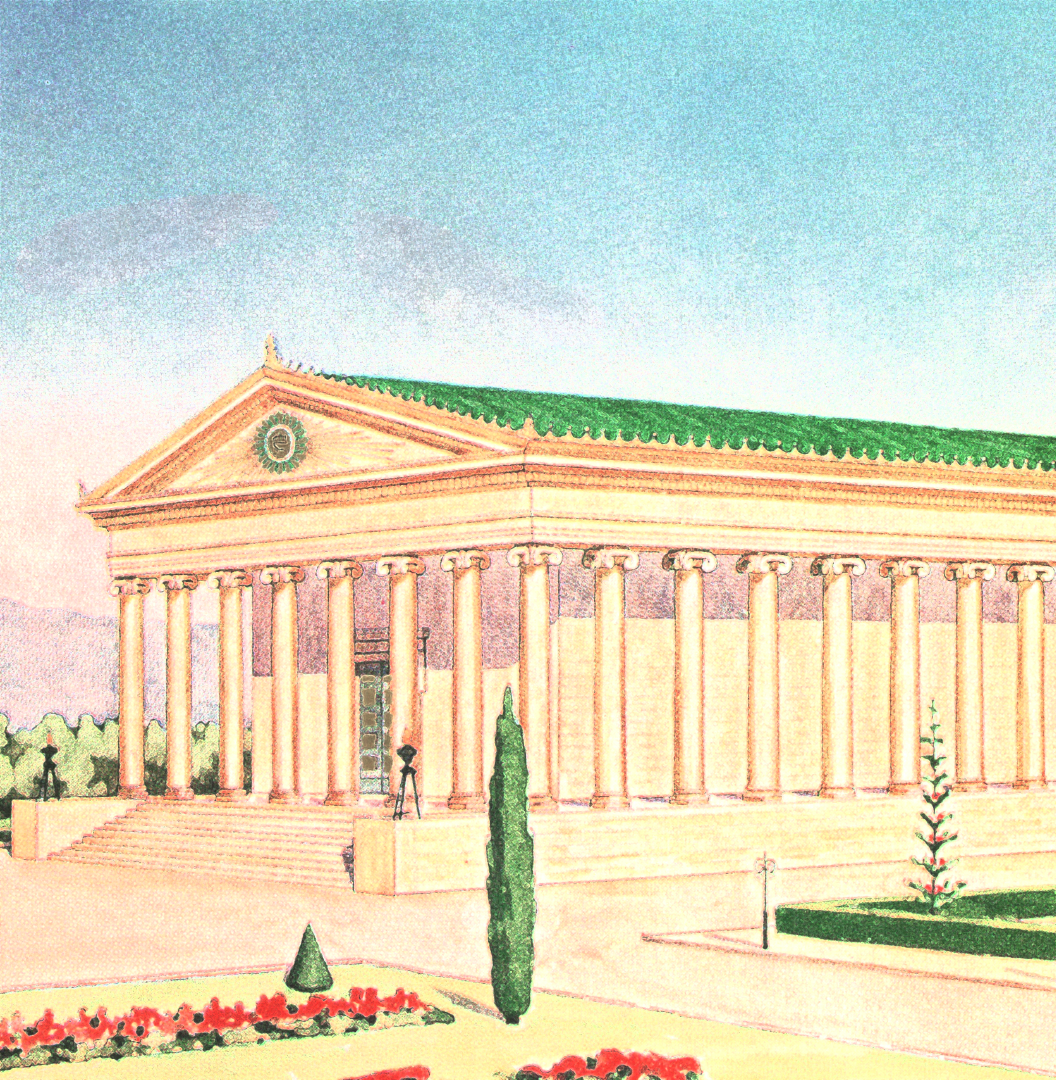
Modern digital interpretation of the watercolor sketch of the final design for the International Bahá'í Archives. Original design published in Part XV of this chronology © United States National Bahá'í Archives, used with permission.
The first phase of the first five years of the Ten Year Crusade lasted from Riḍván 1953 to Riḍván 1954 and the Guardian’s vision was that it would be characterized by the opening of as many of the 131 virgin territories as possible.
In his joyful Riḍván message for April 1954, marking the end of the first phase of the Ten Year Crusade, the Guardian calls this world-encircling enterprise the Bahá'í community’s “sublime mission for the spiritual conquest of the planet” and lists the Bahá'í pioneer’s and Knights of Bahá'u'lláh’ sublime achievements in just 12 months:
- Over 100 virgin territories were opened to the Faith, which included Sultanates, Emirates, Sheikhdoms, Protectorates, Trust Territories and Crown Colonies,
- The Faith arrived as far north as Arctic Bay, Franklin, 73 degrees latitude
- And as far south as the Falkland Islands near Magallanes, the world's southernmost city
- The most isolated outposts in the world where Bahá'ís could now be found were Sikkim at the foot of the Himalayas, the Lofoten Islands in Norway, Fezzan in the Sahara Desert, the Andaman and the Seychelles Islands, penal colonies in the Indian Ocean, the three Guianas in South America and the leper colonies on the Atlantic Coast, the inhospitable and windswept North Sea Faroe and Shetland Islands, Hadhramaut on the sunbaked shores of the Arabian Peninsula, St. Helena isolated in the midst of the South Atlantic Ocean and the Gilbert Islands, the war-devastated, sparsely populated Atolls situated in the heart of the Pacific Ocean
- The Bahá'í Faith was present in 78 countries
- Bahá'í literature was now available in 130 languages
- The African Campaign doubled the number of countries were the Faith was present in just one year
- There were now over 600 African Bahá'ís representing over 60 indigenous tribes
- There were now 190 African Bahá'í centers
- New Bahá'ís in Africa arose to become Knights of Bahá'u'lláh’s themselves
- The Bahá'í Faith was introduced to 34 Native American tribes American Indian tribes, raising the total number of tribes contacted throughout the western Hemisphere to thirty-four.
- The first Greenlandic, the first Pygmy, the first Berber, the first Fijian, Bahá'ís declared during the year
- In the Holy Land, the superstructure of the Shrine of the Báb was finally completed
- The Temple Land for the first House of Worship in the Holy Land was selected
- Bahá'í Continental Funds were inaugurated
- Properties were acquired on Mount Carmel to build the International Bahá'í Archives—the first building on the Arc; The design was approved and construction will begin shortly
- The Ḥaram-i-Aqdas was additionally embellished, around the Shrine of Bahá'u'lláh
- Israel Branches of the British, the Persian, the Canadian and the Australian Bahá'í National Spiritual Assemblies were legally established and formally recognized as Religious Societies by the Israeli Civil Authorities
- Contact at the Bahá'í World Centre was established with the President of Israel, its Prime Minister, five other Cabinet Ministers, and the President of the Knesset, culminating in the establishment of a special Bahá'í Department in the Ministry of Religious Affairs
- The site of the Síyáh-Chál and its surrounding area in Ṭihrán was purchased
- Women in Iran were now allowed to be elected on Local Spiritual Assemblies and the National Spiritual Assembly
- 11 Temple Funds were been inaugurated,
- New National Bahá'í Centers were purchased around the world, and their collective value is now over $1.5 million
- The landscaping around the House of Worship of North America was completed
- The first Dependency of a House of Worship in Bahá'í history was decided upon for the Mother Temple of America
- A number of Local Spiritual Assemblies in the United States were incorporated
- New National Bahá'í endowments were established in Anchorage, Alaska.
- The Local Spiritual Assemblies of Tucson, Arizona and of Sacramento, were now allowed to perform legal Bahá'í marriages
- Bahá'í Holy Days have been recognized in Los Angeles, California and Castro Valley, California; Niles Township, Michigan; Seattle, Washington; Newton, Massachusetts; Prince George County, Maryland; Cleveland, Ohio; Kenosha, Wisconsin; Maywood, Illinois.
In his 1954 Riḍván Message, the Guardian informed the Bahá'í World regarding the importance of the International Bahá'í Archives:
The design of the International Baha'i Archives, the first stately Edifice destined to usher in the establishment of the World Administrative Centre of the Faith on Mt. Carmel—the Ark referred to by Baha'u'llah in the closing passages of His Tablet of Carmel—has been completed, and plans and drawings forwarded to Italy for the purpose of securing bids for its construction immediately after the conclusion of the necessary preliminary steps taken in the Holy Land for its forthcoming erection.
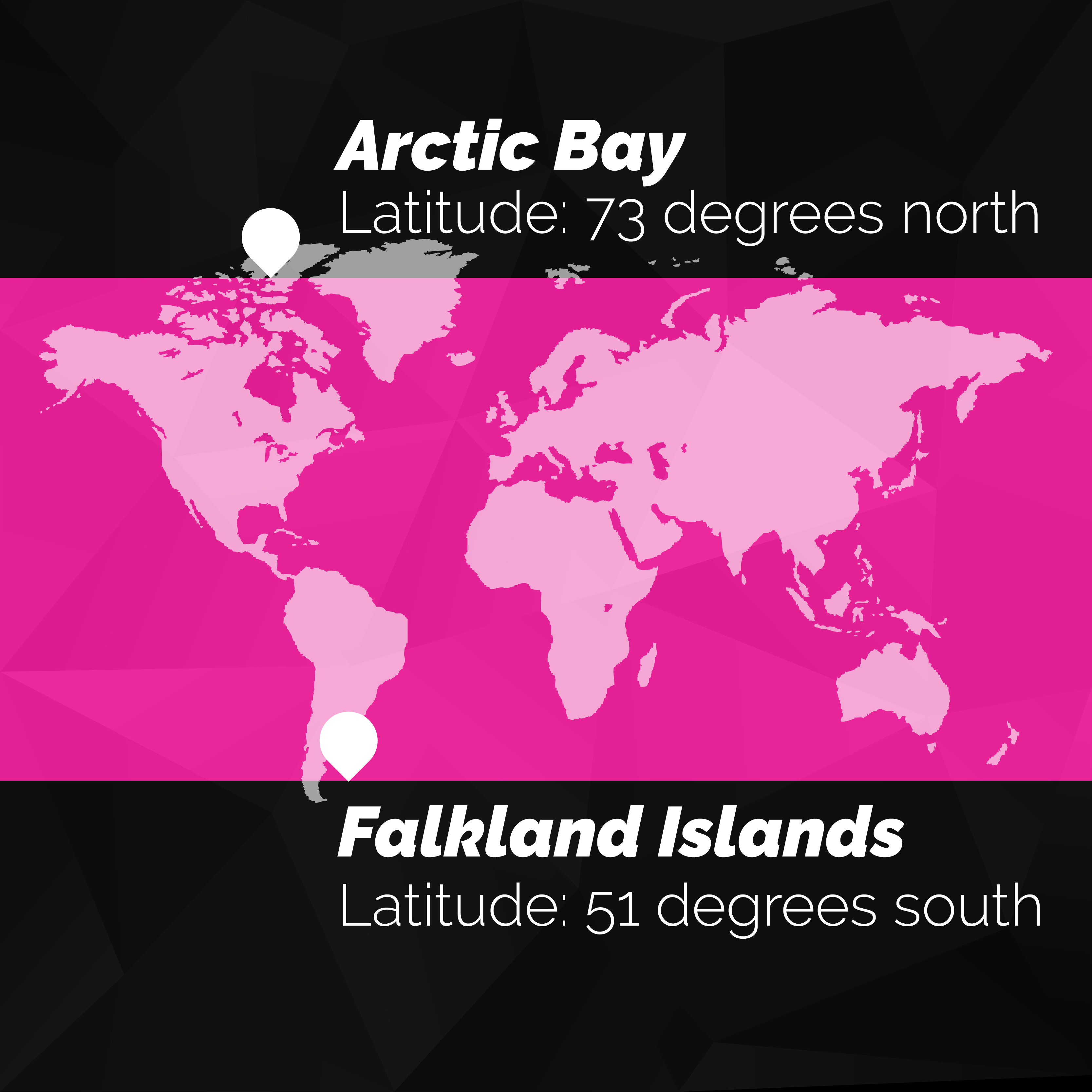
Map asset by Freepik.
The Book of Daniel, in the Old Testament, dates back to 167–163 BC. It was one of the prophecies which 'Abdu'l-Bahá cited, when he spoke about certain milestones that would be achieved by the Faith. In Daniel Chapter 12 Verse 12, he states:
Blessed is he that waiteth, and cometh to the thousand three hundred and five and thirty days.
This prophecy, 'Abdu'l-Bahá explained, refers to the Centenary of the Declaration of Bahá'u'lláh, by which time, the Master stated emphatically,
The teachings of God [will] be firmly established upon the earth, and the Divine Light…flood the world from the East even unto the West.
Speaking of this 1,787-year-old prophecy, the Guardian was exultant:
Think of it! Daniel said it would take until 1963, yet we have practically accomplished it nine years ahead of schedule. Think of it!—the Guardian paused, then said—Of course, Daniel did not know what kind of Prophet Baha'u'llah would be.
Everyone laughed, and then Leroy Ioas said:
Shoghi Effendi, if I may say so, Daniel also did not know what kind of Guardian we were going to have.
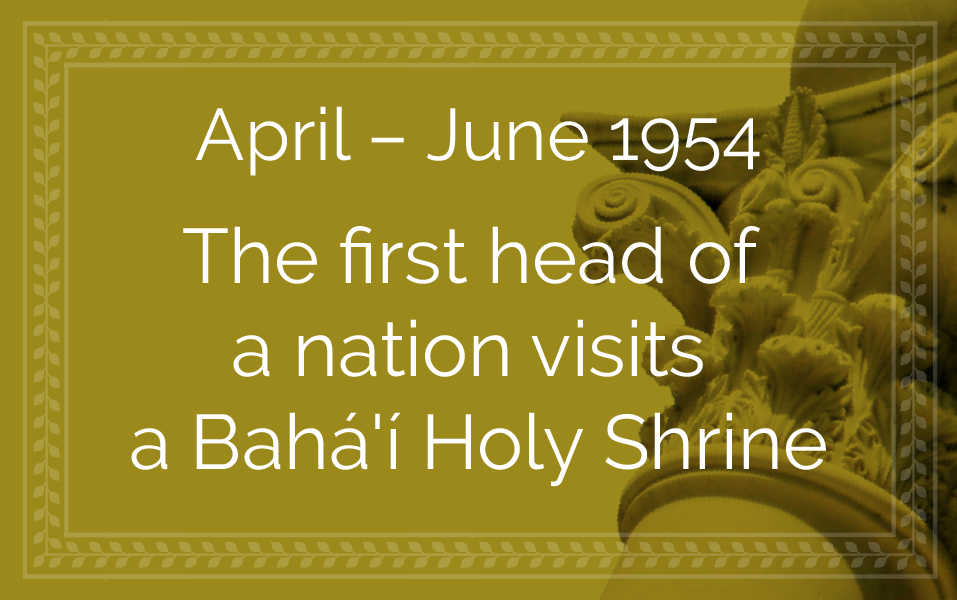

President Yitzhak Ben-Zvi, second President of the State of Israel. By Fritz Cohen—This is available from National Photo Collection of Israel, Photography dept. Government Press Office (link), under the digital ID D673-098 Source: Wikimedia Commons, Public Domain.
Sometime in about 1919, a poor, young Jewish couple, walking through Palestine, passed in front of Bahjí, where they meet 'Abdu'l-Bahá who, warm and courteous, took them into the Shrine of Bahá'u'lláh.
This young couple was Yitzhak Ben-Zvi and his wife Rachel Yanait. Yitzhak Ben-Zvi would be the second president of the State of Israel.
In 1954, Shoghi Effendi received confirmation that President Yitzhak Ben-Zvi would indeed care to visit the Shrine of the Báb in Haifa, and he formally extended the invitation. The date of the visit was fixed to the morning of 26 April 1954, and the Director of the President’s Office wrote to the Guardian that the President would "be pleased to pay you an official visit."
On the morning of President Ben-Zvi’s visit, the day of 26 April 1954, Hands of the Cause Leroy Ioas and Mason Remey—respectively Secretary-General and President of the International Bahá'í Council—went to the Megiddo Hotel to personally welcome the President and his wife, Rachel Yanait, and found them finishing breakfast. President Ben-Zvi and his wife invited them to have coffee with them and their military aide, and at 9:00 AM, they drove to the Guardian’s home, the house of the Master at 7 Haparsim, accompanied by their military aide and another staff member.
The Guardian and Rúḥíyyih Khánum warmly welcomed them, and they sat down to have a friendly and informal discussion, in which the Guardian outlined the aims and objectives of the Bahá'í teachings and the deep love Bahá'ís had for Israel.
President Ben-Zvi told the Guardian that he knew the Bahá'í Faith, and proceeded to tell the Guardian and Rúḥíyyih Khánum about their delightful encounter with 'Abdu'l-Bahá in 1919, 35 years ago. He and Mrs. Ben-Zvi were young—he was 35 and she was 33—, they were poor, they were newlyweds—they had married just one year before meeting 'Abdu'l-Bahá in 1918—and they were poor. They had decided to hike the length and breadth of the Holy Land, and they arrived at the gate of Bahjí, only to be kindly and courteously welcomed by the Master who served them tea. Here they now were, President Ben-Zvi and his wife Rachel Yanait, 70 and 68, drinking the same wonderful Persian tea with 'Abdu'l-Bahá’s grandson in Haifa.
Shoghi Effendi—always having the perfect gesture at the perfect moment—offered the President and his wife a wrought silver-bound album containing colored views of the Bahá'í Holy Places in Haifa and Bahjí. The Guardian accompanied the Presidential party to the Shrine of the Báb, marking the first time in Bahá'í history that the head of a sovereign nation ever made a visit to a Bahá'í Holy Shrine.
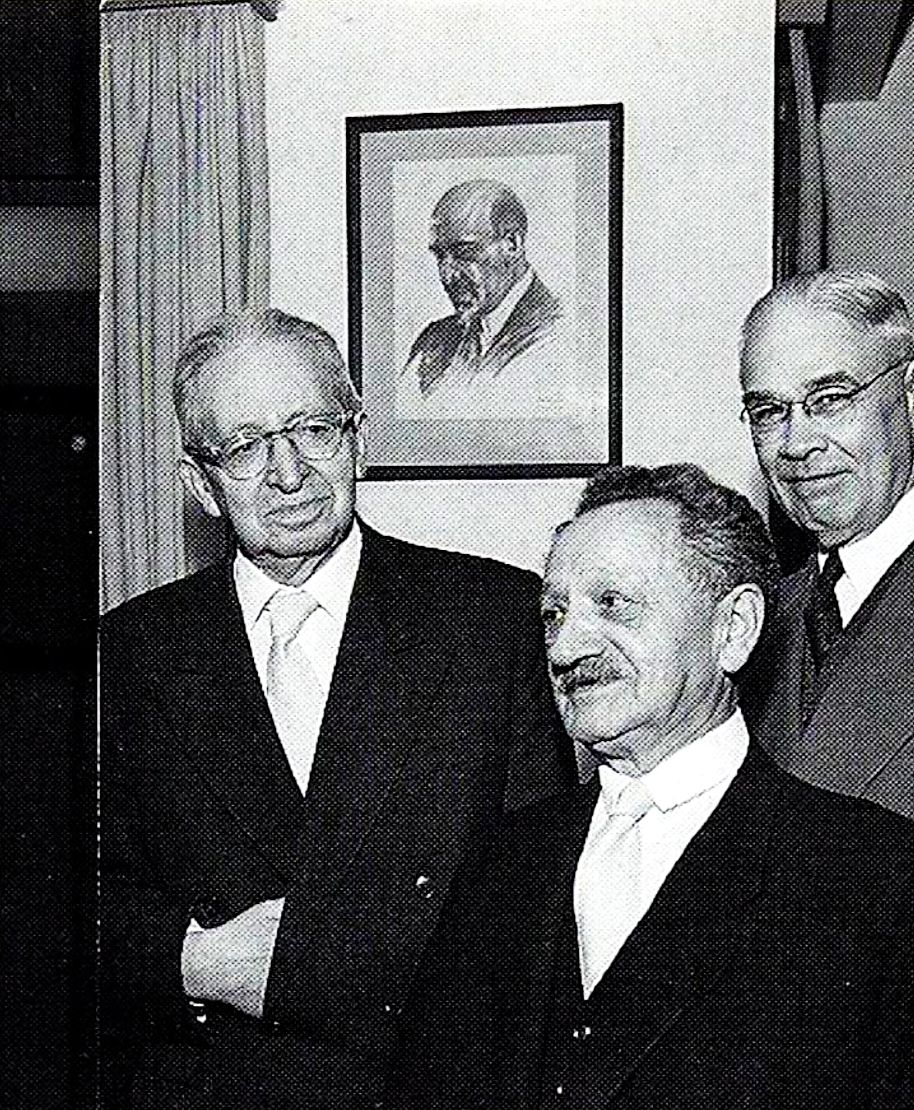
No photograph of President Ben-Zvi’s visit to the Shrine of the Báb was found. Above is photograph of President Yitzak Ben-Zvi, Yosef Sprinzak, the first Speaker of the Knesset of the State of Israel, and Hand of the Cause Leroy Ioas, in 1959. The photograph on the wall is that of the first President of Israel, Chaim Weizmann. Source: Leroy Ioas: Hand of the Cause of God by Anita Ioas Chapman, between pages 274-275.
The Guardian led the President and Mrs. Ben-Zvi through the gardens, fragrant with the heady smell of roses and lilies, showing them the panorama from Mount Carmel stretching from Haifa to 'Akká.
After this, the Guardian escorted the Presidential couple to the Shrine of the Báb. At this point Leroy Ioas realized he was going to have to tell the President of Israel to remove his shoes before entering the Shrine. Once he did, President Ben-Zvi turned to him and spoke a short sentence in Hebrew, which he explained:
I quoted to you what God said to Moses when He approached the Burning Bush: Put thy shoes from off thy feet, for the place whereon thou standest is holy ground.
Then the President said
Of course I will take off my shoes. This custom originated with us, when God spoke to Moses.
President and Mrs. Ben-Zvi were very impressed with their visit to the Shrine of the Báb and the spirit of the sacred precincts and commented warmly on the beauty of the gardens. The President told the Guardian how grateful they were to have them and how proud they were that the World Centre of the Faith was in Israel.
Before leaving, President Ben-Zvi thanked the Guardian for his warm hospitality, and for the Bahá'í community’s work in Israel, extending his best wishes for the worldwide success of the Faith.
Walking behind with one of the President's aides, Leroy Ioas said to him:
Isn't this a good occasion to issue a press release?
The aide replied:
Yes, but I'm so busy today—why don't you write it?
Leroy did so and sent it off to the papers.
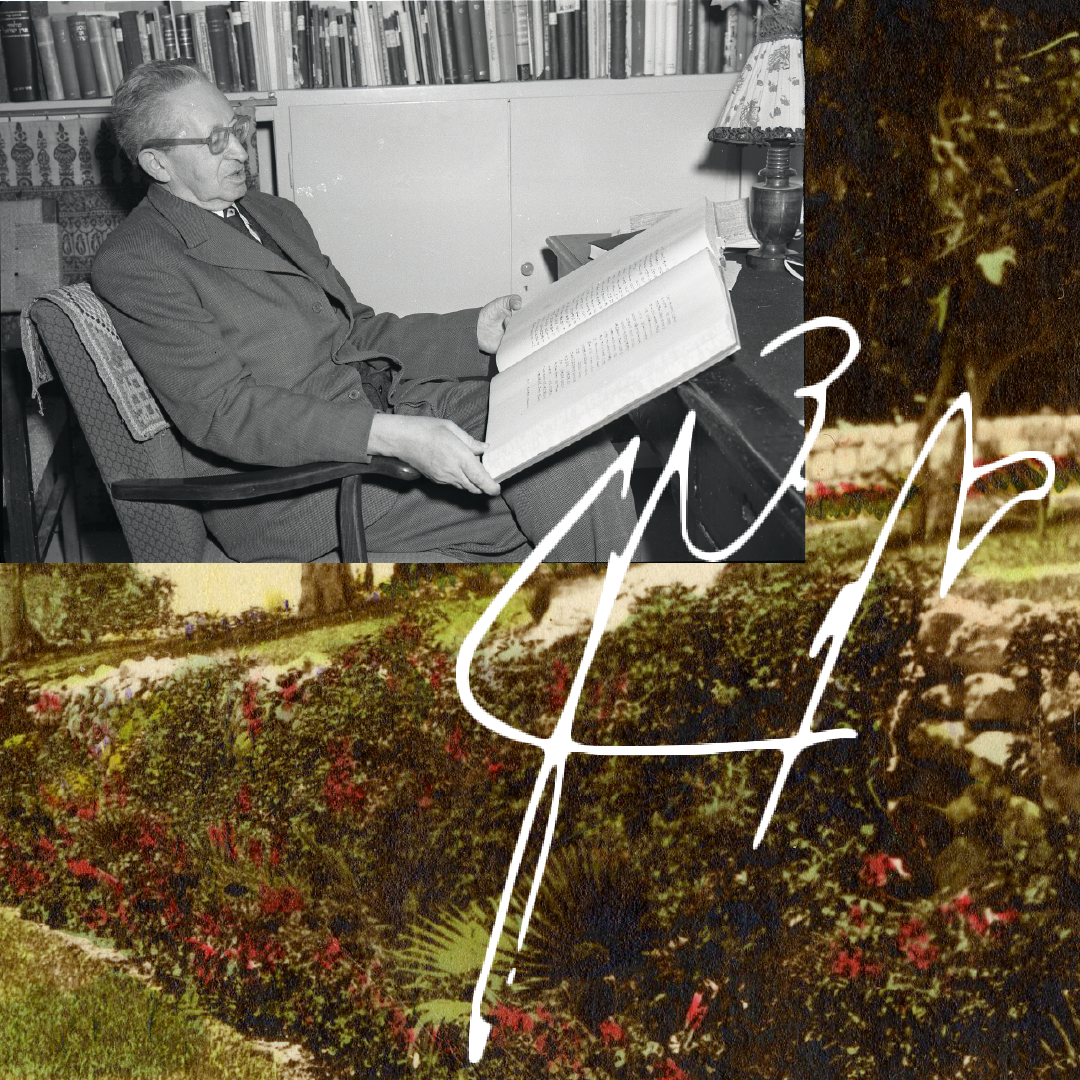
Top photograph: President Ben-Zvi in December 1952 by Benno Rothenberg, Meitar Collection, National Library of Israel, the Pritzker Family National Photography Collection. Source: Wikimedia Commons. Bottom photograph: The signature of President Yitzak Ben-Zvi for a story about exchanging letters with Shoghi Effendi. Faigl.ladislav, Yitzhak Ben-Zvi Own work by uploader, traced from bitmap from havelshouseofhistory.com. Source: Wikimedia Commons. Background: color postcard of the Shrine of the Báb. © United States National Bahá'í Archives, used with permission.
Three days later, on 29 April 1954, President Ben-Zvi personally wrote to the Guardian expressing his appreciation:
I should like to express my thanks for your kind hospitality and for the interesting time I spent with you visiting the beautiful Gardens and remarkable Shrine.
On 4 May 1954, the Guardian sent a message to the Bahá'í world announcing the historic visit of the President of Israel to the Shrine of the Báb:
The President of the State of Israel, accompanied by Mrs. Ben Zvi, visited, as anticipated, the Shrines on Mount Carmel, following a reception in their honor held in `Abdu'l-Bahá's house marking the first official visit paid by the Head of a sovereign independent State to the Sepulchers of the Martyr-Prophet of the Faith and the Center of Bahá'u'lláh's Covenant.
On 26 May 1954, the Guardian and Rúḥíyyih Khánum traveled to Jerusalem to pay a return call on President Ben-Zvi, cementing the historic relationship.

First Local Spiritual Assembly of Kampala, Uganda, Riḍván 1952. Standing, in the back row from left to right: Philip Hainsworth (pioneer), Chrispian Kajubi (Ganda tribe), Enoch Olinga (Teso tribe), ‘Alí Nakhjávání (pioneer), Frederick Bigabwa (Toro tribe), Peter Musoke (Ganda tribe). Seated, in the front row, from left to right: Samihih Banáni (pioneer), Músá Banáni (pioneer), Violette Nakhjaváni (pioneer).Source: Bahaimedia. Caption for the photograph from The Bahá'í World Volume 16, page 84.
On 4 June 1956, the Guardian made an extraordinary statement in a letter he wrote to the National Spiritual Assembly of the British Isles:
Of all the places in the world where the Baha'i Faith exists and is spreading, the Guardian is definitely most pleased with Africa, and most proud of Uganda. He feels that the spirit shown by white and [African] pioneers alike in that continent, presents a challenge to the Baha'is everywhere in the world, and that old and staid communities may well learn from, and emulate the example of, the believers of Africa, many of them scarcely a year old in the Cause of God!
Two exceptional Bahá'ís were at the heart of the great teaching success the Guardian was speaking about in his remarkable statement, ‘Alí Nakhjávání, the future member of the first Universal House of Justice, and future Hand of the Cause, Knight of Bahá'u'lláh Enoch Olinga, the “Father of Victories.”
Enoch Olinga’s life was transformed when ‘Alí Nakhjávání taught him the Faith in 1952 in Kampala, Uganda, and he had gone on to win extraordinary victories during the Ten Year Crusade, drinking the sweet elixir of pioneering in Shoghi Effendi’s name, kindling the fire of Faith in the hearts of countless souls, and planting the seed of the tree of the love for the Covenant in the hearts of new Bahá'ís.
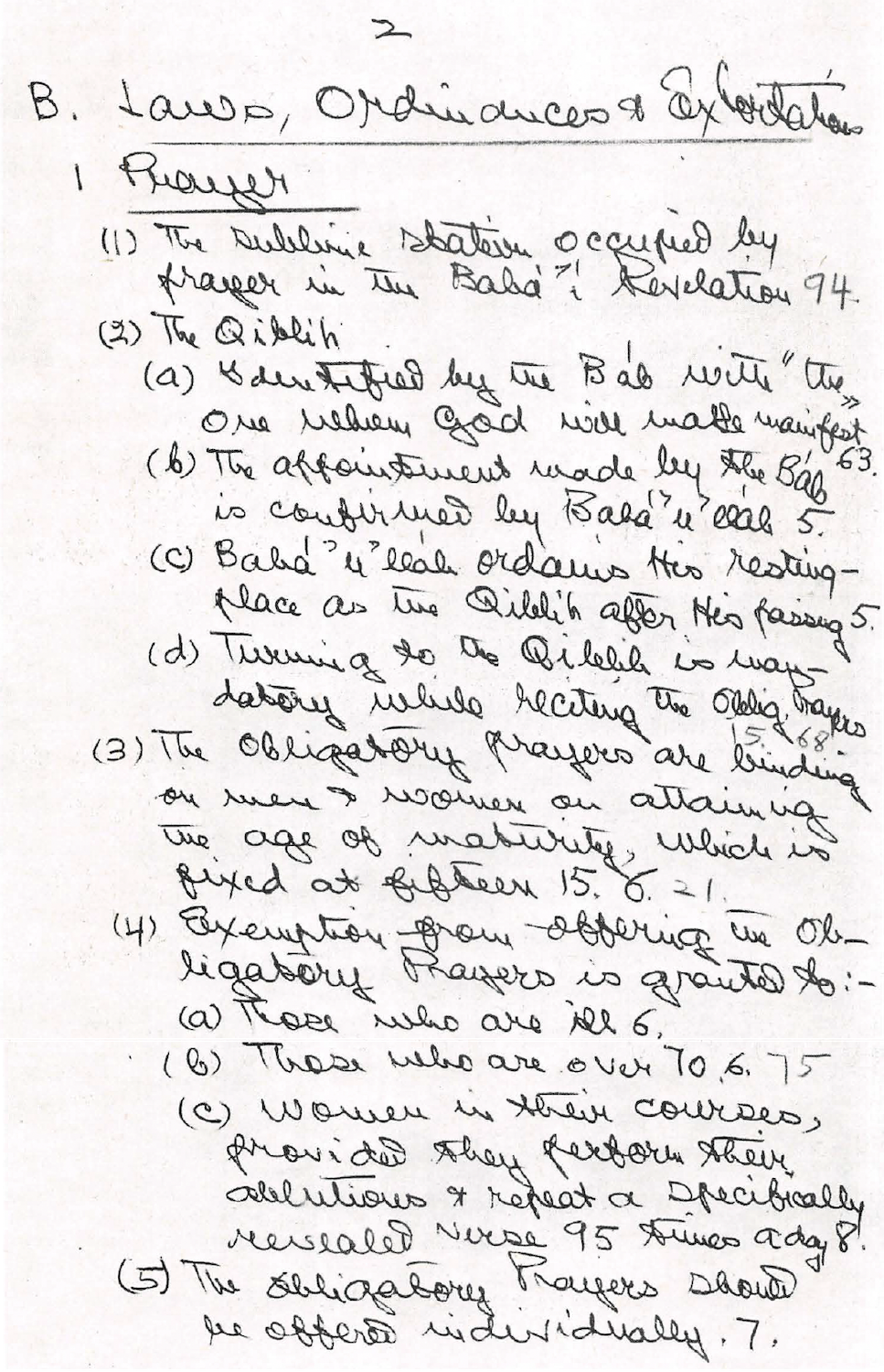
Facsimile of a page of Shoghi Effendi’s handwritten outline of laws and ordinances of the Kitáb-i-Aqdas, as part of his project of the synopsis and codification of the Most Holy Book. This section can be found in the current publication of the Kitáb-i-Aqdas under section IV. Laws, Ordinances and Exhortations: A. Prayer: sections 1 through 5. Source: The Bahá'í World Volume 15, page 92.
In 1954, the Guardian started working on the codification of the Kitáb-i-Aqdas and prepared notes for his translation of the Kitáb-i-Aqdas. He would not be able to finish this work before his untimely passing in November 1957.
Throughout his ministry, the Guardian translated approximately one third of the Kitáb-i-Aqdas in Gleanings from the Writings of Bahá'u'lláh, in this last long letter, the Promised Day is Come, and in Epistle to the Son of the Wolf.
Shoghi Effendi did not write major letters or publish any new translations of the Writings of Bahá'u'lláh between 1941—when he wrote The Promised Day is Come—and his passing, but for 3 years between 1954 and 1957, he dedicated himself to codifying the crowning achievement of Bahá'u'lláh’s life, His Book of Laws.
In the spring of 1957 Shoghi Effendi spent three full weeks dedicated to working on the codification of the Kitáb-i-Aqdas but told Rúḥíyyih Khánum he would not be able to complete it.
Shoghi Effendi’s work—his copious notes and his codification—were published by the Universal House of Justice in 1973 under the title A Synopsis and Codification of the Laws and Ordinances of the Kitáb-i-Aqdas. The Guardian had done most of the work and the Universal House of Justice appointed a special committee to add the few remaining touches before it was published.
Shoghi Effendi had stated that when the time came for the Kitáb-i-Aqdas to be translated, it should be accompanied by copious notes to provide background, context, and explanations for some of Bahá'u'lláh’s references.


An early photograph of the original Shrine of the Báb raised by 'Abdu'l-Bahá, showing virgin land on Mount Carmel above the holy edifice, the subject of the story below. © United States National Bahá'í Archives, used with permission.
In order to safeguard the dream of 'Abdu'l-Bahá’s 19 terraces below and above the Shrine of the Báb, the Guardian set his sights on acquiring a portion of Mount Carmel on the heights directly above the Shrine of the Báb, in the direct continuing access of Ben Gurion Avenue, at the base of the mountain.
After studying the matter, Leroy Ioas found a 10,000-square meter plot, located in the exact spot the Guardian had requested, and made initial contacts with the landowners—the State of Israel—and Haifa Municipal authorities and Government authorities.
The Israeli State was ready to relinquish the land to the city of Haifa for public building purchases, and the Guardian felt they should try to purchase 4,000 square meters of the land which directly overlooked the Shrine of the Báb and its gardens.
After lengthy negotiations, the State agreed to relinquish its claim on the property on the condition that the Bahá'ís agreed to use it for gardens and lease it to the city for several years in order to extend their municipal gardens.
The Guardian approved and arduous negotiations ensued.
Finally, in late October 1954 the contract was signed for the 4,000-meter plot of land, which was purchased and held in the name of the Israel Branch of the National Spiritual Assembly of Iran.
The pen used to sign this contract was given to the National Bahá'í Archives of Iran.
When the land was purchased, the Guardian was outside the Holy Land, but he took time to thank his heroic aide, sending a message to Leroy Ioas:
Tell Leroy abiding appreciation outstanding success.

This early photograph of Mount Carmel was cropped to show the virgin land east and northeast of the Shrine of the Báb, where the International Bahá'í Archives now stand. The Shrine of the Báb is on the very edge of the left side of the photograph. © United States National Bahá'í Archives, used with permission.

This early photograph of Mount Carmel was cropped to show the virgin land east and northeast of the Shrine of the Báb, where the International Bahá'í Archives now stand. The Shrine of the Báb is on the very edge of the left side of the photograph. © United States National Bahá'í Archives, used with permission.
The Guardian had known exactly where he wanted to build the International Bahá'í Archives. It was a plot of land higher up on Mount Carmel than the Shrine of the Báb, and to the southeast, a plot of land boasting an ugly building that was owned by a very hostile Covenant-breaker living in the United States.
The reason that the Guardian was not able to start building the International Bahá'í Archives as soon as the land was purchased was because small tracts of land had not been purchased, which were essential to the construction of the International Bahá'í Archives.
The parcel that the Guardian cared the most about was a small 1,300-suqare meter lot owned by a Covenant-breaker, a member of the family of 'Abdu'l-Bahá who lived in America. For 30 years, the Guardian had tried and failed to purchase this land, but he was thwarted each time by the Covenant-breaker’s the greed and stubbornness.
This plot of land was close to the Shrine of the Báb and overlooked the resting place of the Greatest Holy Leaf, and adjoined the land where Ásíyih Khánum and Mírzá Mihdí, 'Abdu'l-Bahá’s mother and younger brother, were laid to rest.
The property had been neglected for decades and was an eyesore to the beautiful surroundings that Shoghi Effendi had painstakingly created. In 1954, Leroy Ioas appealed to the Israeli authorities and the property was expropriated on the recommendation of the Mayor of Haifa.
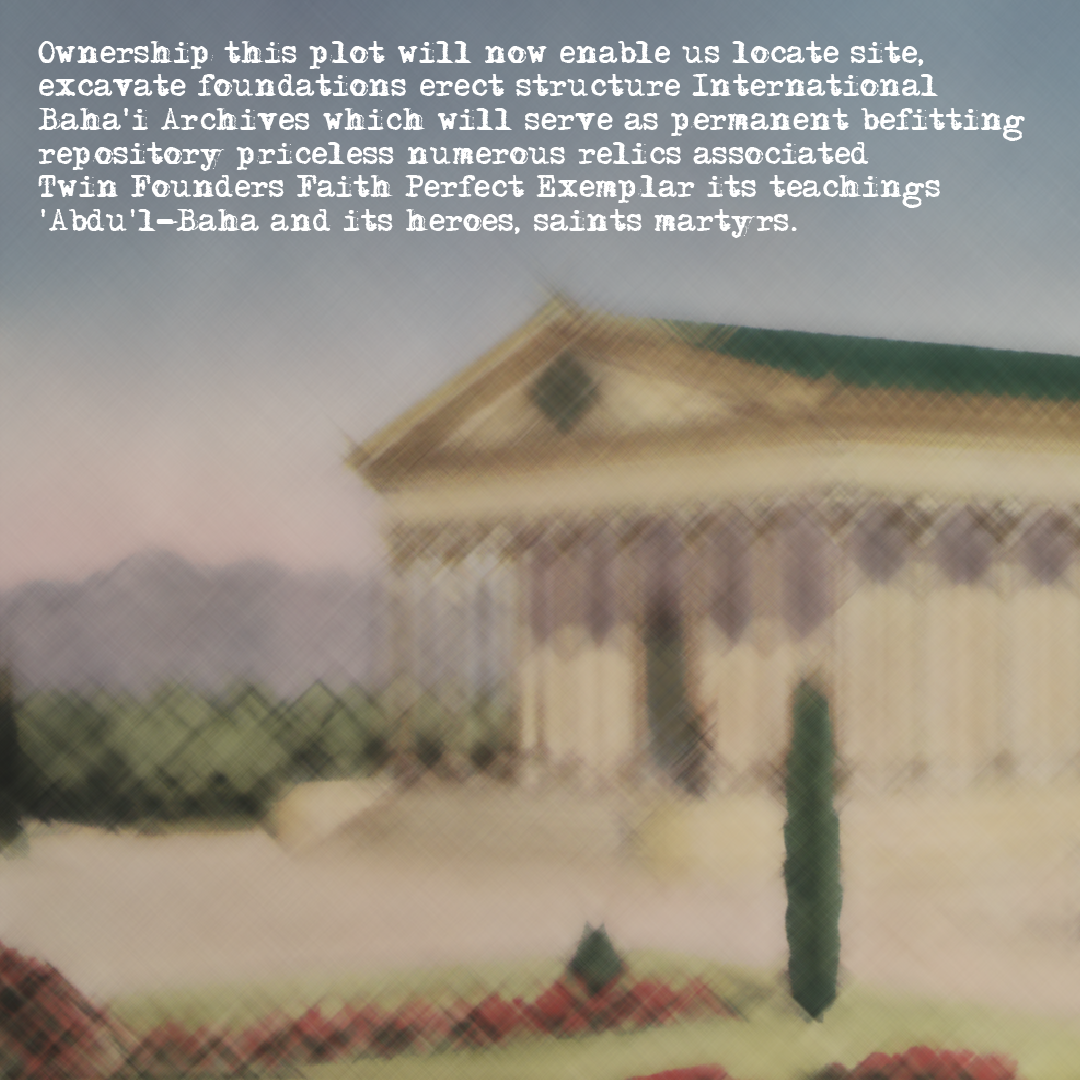
Background: digital painting of the previously-attributed watercolor design of the International Bahá'í Archives.
On 27 November 1954, Leroy Ioas bought the plot on behalf of the Guardian, and the same day, Shoghi Effendi sent a message to the Bahá'í world of great importance, unveiling to Bahá'ís the significance of the purchase of this plot.
After Leroy Ioas successfully negotiated the expropriation of the Covenant-breaker’s land, Shoghi Effendi cabled:
Tell Leroy delighted victories.
Within a few months of its purchase, the Guardian began excavation work for the International Bahá'í Archives.
As soon as Leroy Ioas had acquired the property, the Guardian informed the Bahá'í world:
Ownership this plot will now enable us locate site, excavate foundations erect structure International Bahá'í Archives…which will serve as permanent befitting repository priceless numerous relics associated Twin Founders Faith Perfect Exemplar its teachings ['Abdu'l-Bahá] and its heroes, saints martyrs.
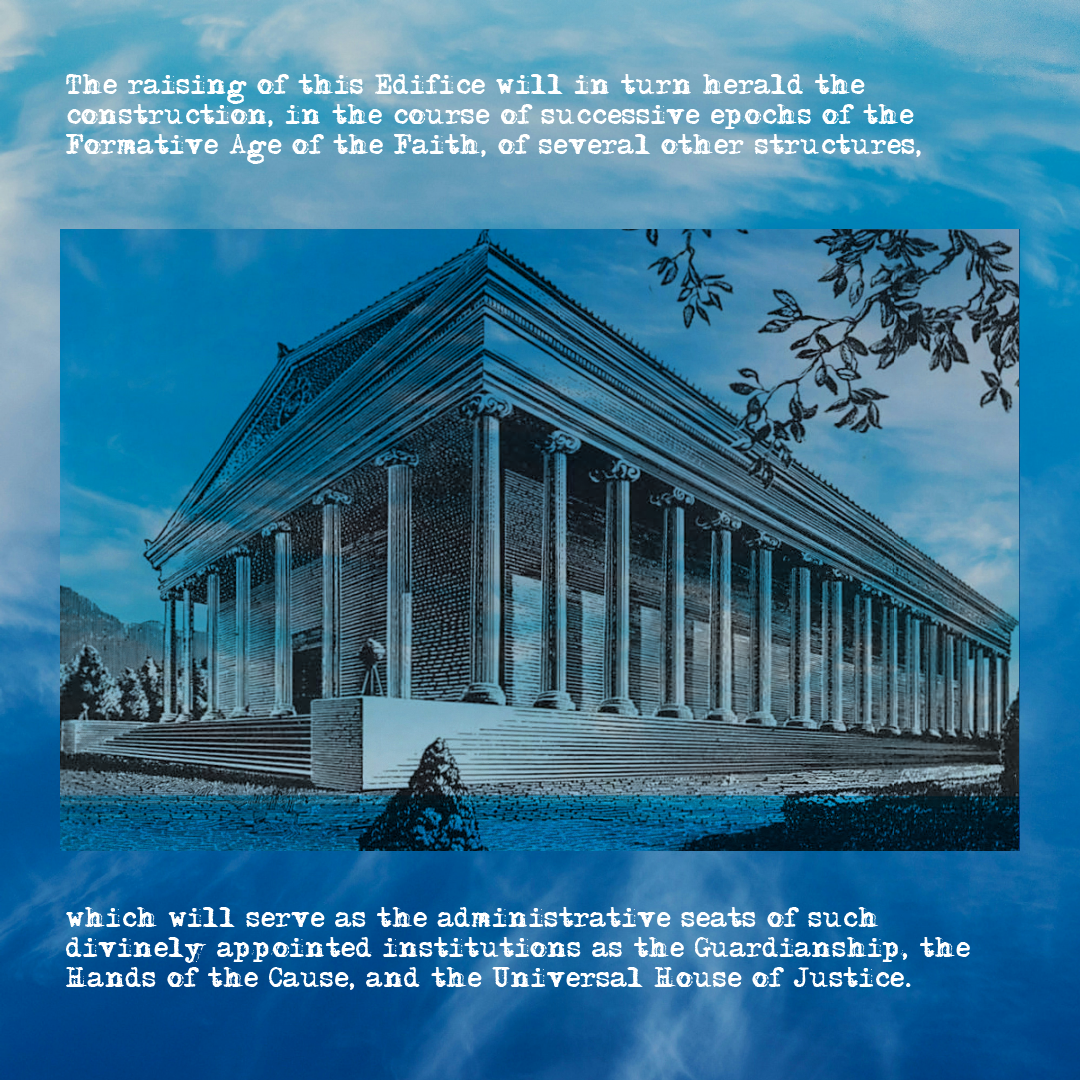
Illustration of the Archives Building by Carl Scheffler. Source: Bahaimedia. Background photo by Kseniia Ilinykh on Unsplash.
On 27 November 1954, when the purchase was complete, the Guardian made the decision to provide the Bahá'ís of the world for the first time, with a complete vision of what the Arc signified, and the importance of the International Bahá'í Archives.
Not only would the International Bahá'í Archives house the precious relics associated with the three Central Figures of the Bahá'í Faith—as he had indicated in his first brief message—but the International Bahá'í Archives—a major goal of the Ten Year Crusade—would officially be the first building erected on the Arc, the seat of the future international Administrative Order of the Faith that would, in time, include the Seat of the Universal House of Justice.
It was a watershed moment in Bahá'í history:
The raising of this Edifice will in turn herald the construction, in the course of successive epochs of the Formative Age of the Faith, of several other structures, which will serve as the administrative seats of such divinely appointed institutions as the Guardianship, the Hands of the Cause, and the Universal House of Justice.
These Edifices will, in the shape of a far-flung arc, and following a harmonizing style of architecture, surround the resting-places of the Greatest Holy Leaf, ranking as foremost among the members of her sex in the Bahá'í Dispensation, of her Brother, offered up as a ransom by Bahá'u'lláh for the quickening of the world and its unification, and of their Mother, proclaimed by Him to be His chosen "consort in all the worlds of God."
The ultimate completion of this stupendous undertaking will mark the culmination of the development of a world-wide divinely-appointed Administrative Order whose beginnings may be traced as far back as the concluding years of the Heroic Age of the Faith.
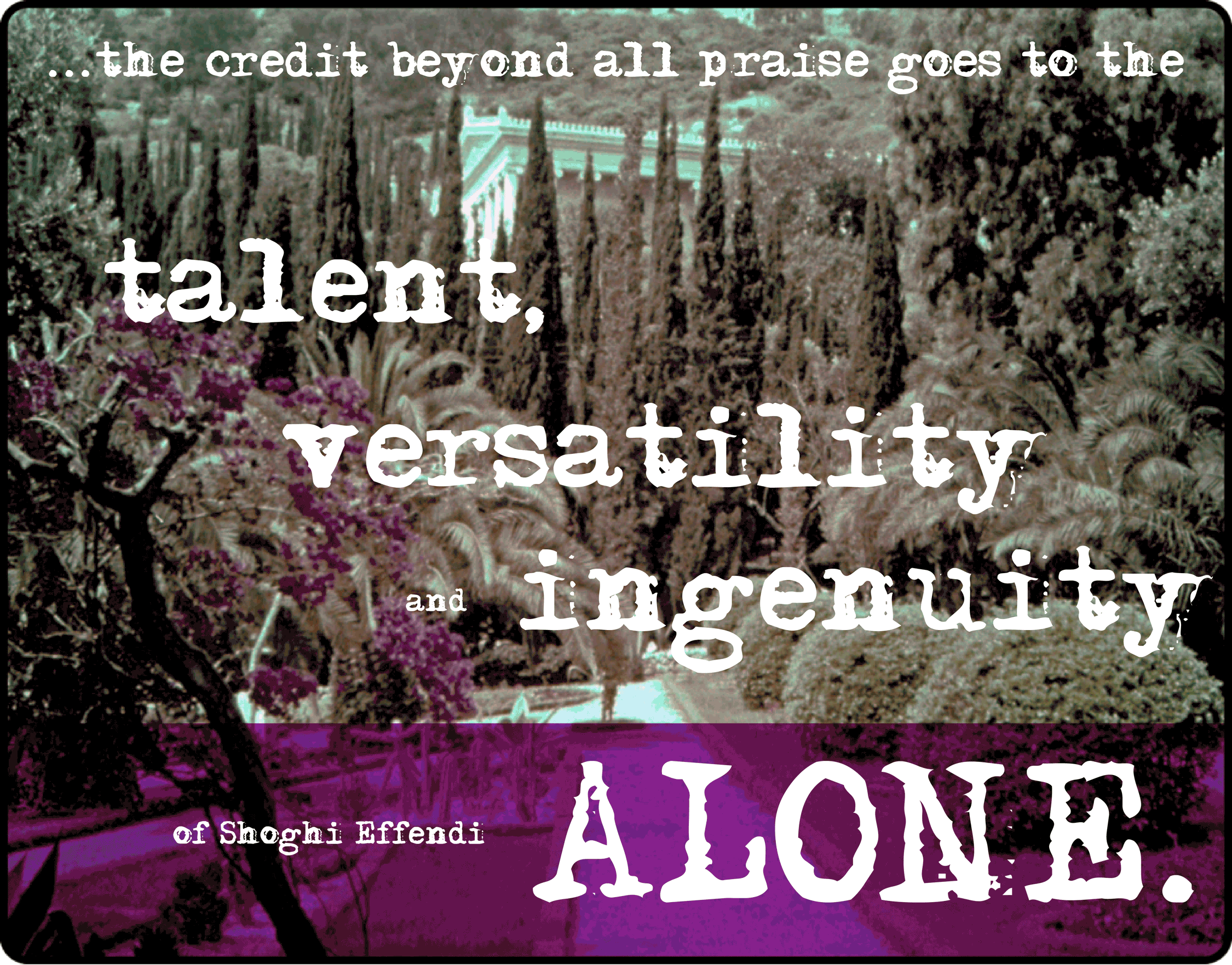
The gardens below the International Bahá'í Archives on Mount Carmel. Source: Bahaimedia.
Shoghi Effendi was used to working with very, very simple tools, and he really loved to lay out his gardens or make measurements with his distinctive “ball of twine and pickets” system. He had done this for the gardens around the Shrine of the Báb, he had used the same method to design the Ḥaram-i-Aqdas gardens in four days in 1952, and he was not going to change a winning system.
When it came time for field measuring the International Bahá'í Archives, Shoghi Effendi took up his ball of string and pickets and delineated the building on the ground. With his perfect sense of proportions, and attention to detail, the Guardian spent a long time studying the dimensions of the building, with strings laid out on the ground. After several tries, he finally determined the exact position, orientation, and dimensions of the edifice. The final dimensions the Guardian had decided on for the International Bahá'í Archives building were 32 meters long, and 14 meters wide.
Being on Mount Carmel, the Archive was sitting on a steep plot of land, basically on a steep, descending hill, which would add complexity to the building process. During this process, of course, the Guardian’s number one priority was to align the International Bahá'í Archives facing the Shrine of Bahá'u'lláh. During one of his visits to Haifa, Shoghi Effendi asked Ugo Giachery to double-check the Field measurements and the delineation of the building on the ground, marked with ropes and pickets.
Anyone looking at the beauty and perfection of the International Bahá'í Archives, the serenity and perfection of its proportions and colors, the green of its roof, the creamy beige of its marble, the gold of its tympanum would probably imagine a huge team of designers, architects, engineers, land surveyors, and builders, but as Ugo Giachery famously said:
Nothing could be further from the real truth, as the credit beyond all praise goes to the talent, versatility and ingenuity of Shoghi Effendi alone.

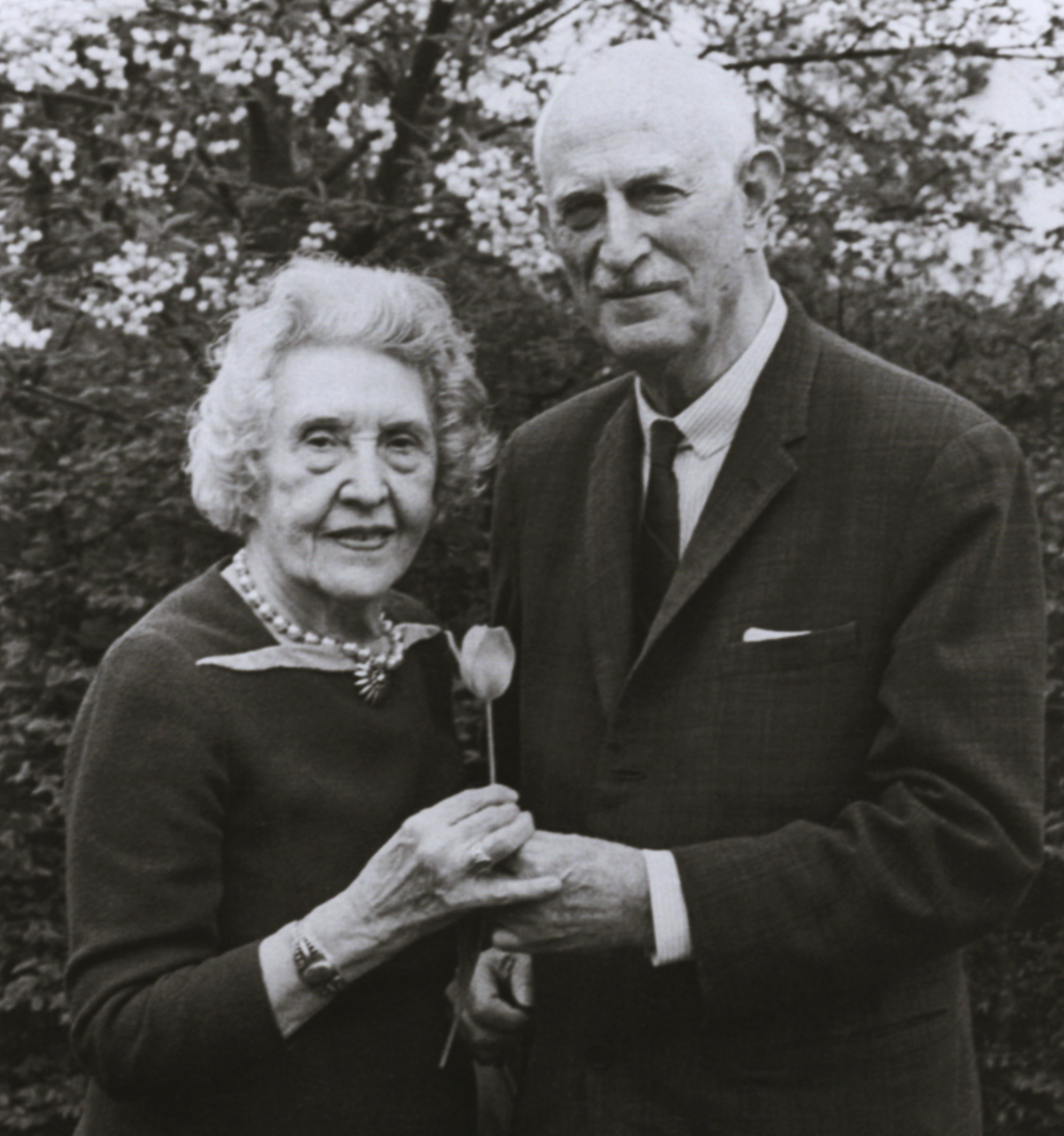
Hand of the Cause Ugo Giachery and his wife, Angeline. Source: We are Bahá'ís.
On 25 November 1954, Ugo Giachery and his wife Angeline received a cable from Shoghi Effendi with long-awaited news:
Permitted pilgrimage you and Angeline dearest love Shoghi.
Ugo and Angeline Giachery were so overjoyed, they made plans to leave Rome immediately, but they received a second cable from Shoghi Effendi asking them to delay their departure by a week.
Finally, in the late evening of Saturday 11 December 1954, the Giacherys left Rome and landed at Lydda airport, in Israel, the following morning, 12 December. This was Angeline’s first pilgrimage and she was elated, it was the greatest event of her life. That night, at dinner, Shoghi Effendi received them lovingly and invited Angeline to sit at the head of the table, the place of honor he reserved for eminent Bahá'ís and first-time pilgrims.
Shoghi Effendi was in high spirits and spoke of the progress of the Faith in Africa, at the time his favorite subject.
For several days during her pilgrimage, Angeline. Giachery had been yearning to ask Shoghi Effendi if he—at any point in his childhood or youth—had ever had an inkling that he would be named Guardian by 'Abdu'l-Bahá. One night, at dinner, the Guardian turned to her and answered her unasked question directly:
I want you to know that the Master neither in writing nor by word of mouth intimated that I was to be His successor, nor left any written instruction as to the manner in which to conduct the affairs of the Cause; I had a tumult in my soul and find my way step by step.
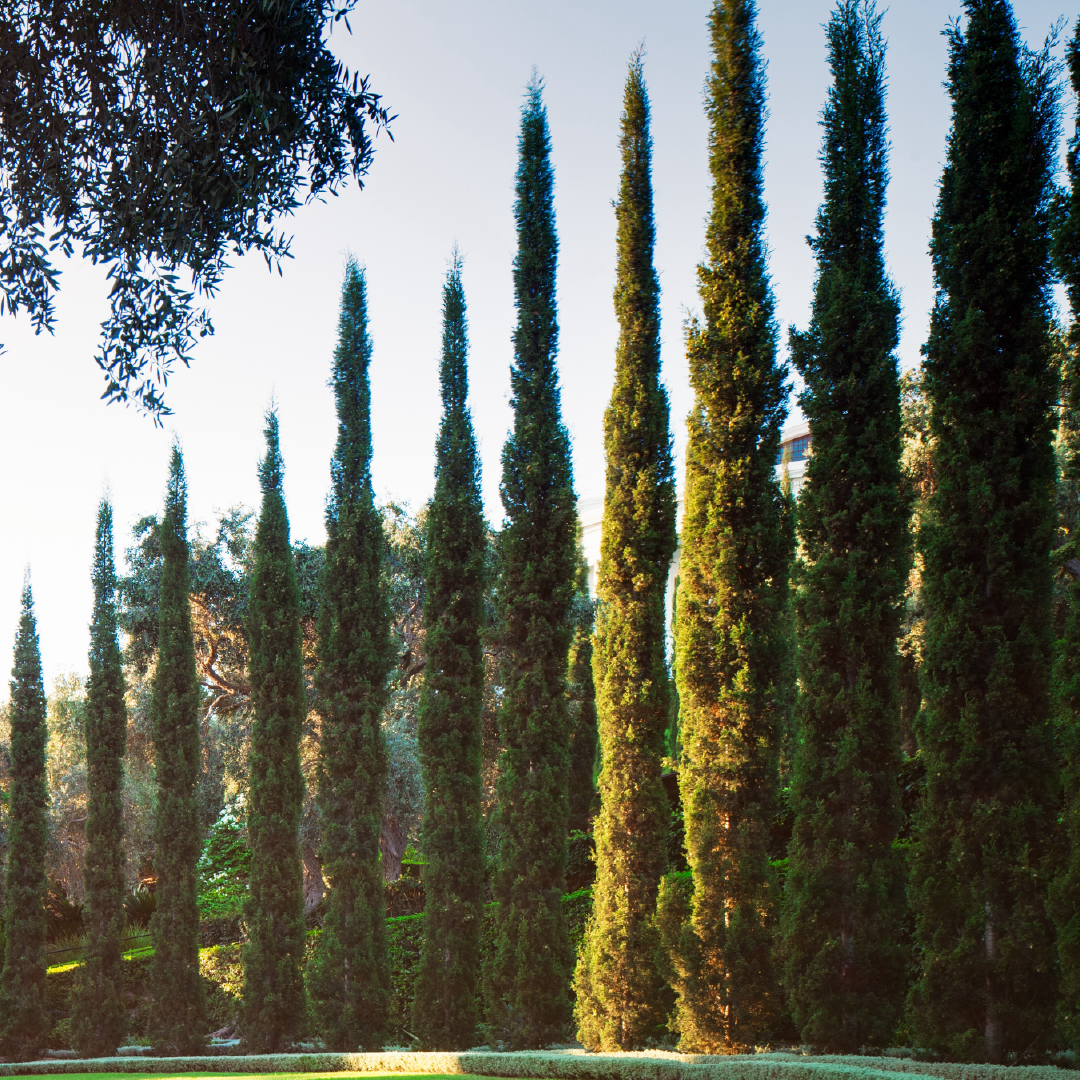
“I have just finished planting eleven cypress trees.” Exactly 11 cypress trees, cropped from a photograph of the monument to the Greatest Holy Leaf. Original image: Bahá'í Media Bank, © Bahá'í International Community 2023.
In the days that followed, Shoghi Effendi spoke to Ugo and Angeline about the urgent work to be done in Italy regarding the preparations for constructing the International Bahá'í Archives, and asked Ugo Giachery to personally inspect the field measurements he had tentatively made for the building on the slopes of Mount Carmel. This was a delicate endeavor given the roughness of the slope on which the Guardian had chosen to build the Archives, compounded by the lack of proper surveying equipment.
When Hand of the Cause Ugo Giachery went to the site the next morning after the Guardian had asked him to, he was amazed to discover how perfectly the Guardian had laid out the building on the ground, assisted by his chauffeur, and with the use of the simplest of tools, wooden pickets and white string.
The Guardian’s most pressing concern was that the International Bahá'í Archives be absolutely perfect orientated facing the Shrine of Bahá'u'lláh, the Qiblih (Direction, in Arabic)—the Most Holy Place— and the very heart and soul of the Bahá'í world.
The Guardian had already started to landscape the ground in the immediate vicinity of the building site, and one evening at dinner, particularly satisfied and happy, he turned to Angeline Giachery and said:
I have just finished planting eleven cypress trees along the future path leading to the Archives building.
Everyone was amazed at the Guardian’s long-range vision, planting the gardens around the International Bahá'í Archives which was still just sticks and strings, and a concept.
As the days passed, Shoghi Effendi asked Ugo and Angeline Giachery to extend their pilgrimage beyond the usual 9 days.

“I would very much like to keep you and Ugo here indefinitely, but Ugo must return to Italy and start immediately to work on the International Archives.” Italian mountain path photograph by Jonas Verstuyft on Unsplash.
The Giacherys’ 13-day pilgrimage was filled with joy and delightful new experiences.
The night before their departure was 24 December 1954, and at dinner that night, the Guardian again turned to Angeline at the dinner table and said:
I would very much like to keep you and Ugo here indefinitely, but Ugo must return to Italy and start immediately to work on the International Archives.
The Giacherys had mixed feelings: they wanted to stay in Shoghi Effendi’s presence as long as possible, but they were also eager to return to Rome to begin serving and assisting him with his new project.
Saturday 25 December 1948 was their date of departure, and it cast a shadow of sadness on Ugo and Angeline Giachery. Shoghi Effendi, exquisitely sensitive, could feel the gloom in their hearts, and lifted their spirits with his brilliance, speaking in his sweet and melodious voice of his visions for the Faith, unveiling them for the astonished and deeply moved pilgrim.
Shoghi Effendi spoke of the spiritual conquest of entire continents, the multiplication of the institutions of the Faith.
Angeline and Ugo realized they were not leaving his presence, rather, they were carrying away with them forever the Guardian’s dreams, his vision and the certainty of extraordinary things that were to happen.

“Precious relics.” Left: Photograph of the Italian Alps by Stefano Zocca on Unsplash. Right: Photograph of the Swiss Alps by Marco Meyer on Unsplash.
The Guardian told the Giacherys that, as soon as conditions allowed it, he would give instructions for the election of new National Spiritual Assemblies, making reference to the day arrived when an independent Regional Spiritual Assembly for Italy and Switzerland. The Guardian said:
I have brought with me some gifts, that I wish you to take back to Europe; they are for the National Ḥaẓíratu’l-Quds [the National Bahá'í Center] of Rome and Berne, and they will become permanent property of the National Assemblies of the two countries, when these bodies come into existence.
The relics the Guardian was entrusting to Ugo Giachery were for Italy and Switzerland. To Rome, Italy, the Guardian gave a large piece of brocade which had, for a long time lain upon the inner Shrine of Bahá'u'lláh, at Bahjí.
To Berne, Switzerland, the Guardian offered a Greatest Name embroidered on silk, from the Shrine of 'Abdu'l-Bahá. Added to this, Shoghi Effendi offered two photographs of the North American House of Worship in Wilmette, two lithographs of the Greatest Name, two copies of the seals of Bahá'u'lláh to be given to the Bahá'ís of Italy and Switzerland, and finally, a photograph of the Shrine of the Báb for Berne, and of the Shrine of Bahá'u'lláh for Rome.
The Guardian explained to Ugo Giachery in detail how the precious relics should be preserved for all generations of believers to come.

“You shall both return to see the Archives when completed.” Photograph of the completed Archives in transparency. Source: Bahá'í Media Bank, © Bahá'í International Community 2023.
Finally, the time had come for the Giacherys to take their leave of their beloved Guardian, and Shoghi Effendi rose from the table and lovingly bid them farewell. The Guardian said:
You shall both return to see the Archives when completed.
Then, the Guardian embraced Ugo Giachery tenderly, holding him in his arms for a long time, then, taking Angeline’s hand in his, he said:
I want you to travel and see the friends.
Everyone who witnessed this deeply tender scene was deeply moved.
Ugo and Angeline Giachery could never have imagined this would be the last time they saw their beloved Guardian. They left the Holy Land on 27 December after a long delay and arrived at Rome's Ciampino airport the next day, 28 December. Two hours later, they were home, and that same afternoon, they received a cable from Shoghi Effendi bearing a message of love for them.
The Guardian never forgot anyone.
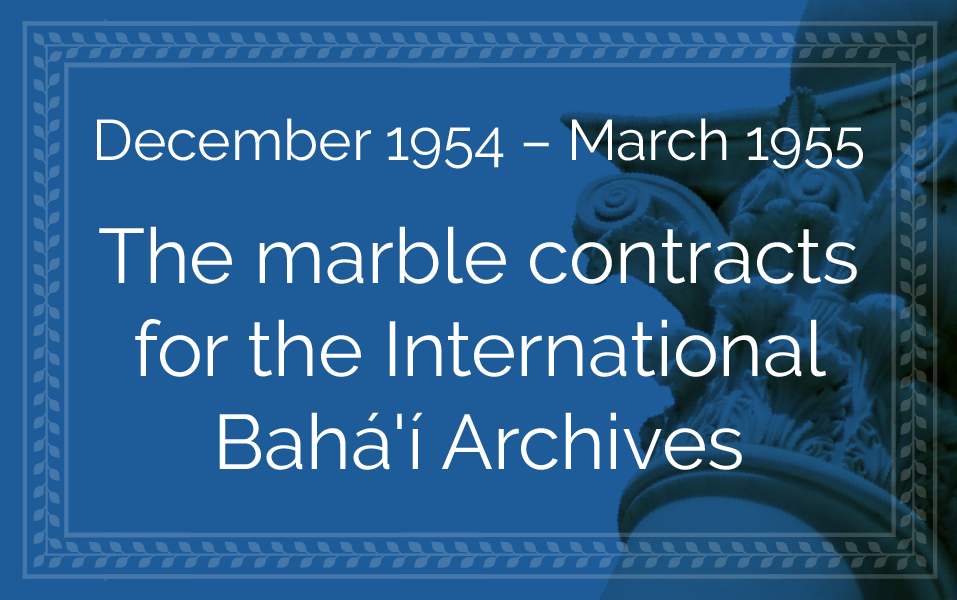

The Venetian Prealps in the province of Vicenza. Photo by Stacy Ropati on Unsplash.
From the moment Ugo Giachery arrived in Italy after his pilgrimage to Haifa with Angeline, on 29 December, he hit the ground running and began working on sourcing what the Guardian needed to build the Archives. Shoghi Effendi turned to Italy for supplies.
He wanted the same very pale beige marble he had used in constructing the superstructure of the Shrine of the Báb, a variety of marble called Chiampo Paglierino, and Ugo Giachery began calling for bids from four different firms to provide the cut and carved marble pieces ready to be loaded onto ships and sent to Haifa.
Divine intervention had a hand in what happened next. Three of the firms’ bids were so high the Guardian could never have afforded them. The last firm’s bid was so reasonable compared to the other three, that two things happened in very quick succession: first, Ugo Giachery was convinced they had made a mistake and second, the Guardian immediately accepted their bid and they got the contract.
The winning bid was from the Vicenza-based Industria dei Marmi Vicentini, a reputable and well-known marble quarry founded in 1906 and located in the Venetian Prealps. The hand of God operated its magic. Because the Guardian had already chosen Chiampo marble for the Archives, Ugo Giachery strongly wished for the marble workshop to be as close to the Chiampo quarry as possible.
Industria dei Marmi Vicentini owned the Chiampo quarries and had a very well-equipped laboratory in the little town of Chiampo. The Guardian signed the contract for his first order of marble in January 1955.All this work took the better part of a year because detailed plans had to familiarize the firm’s engineering staff with the details of the project.
Two months later, in March 1955, excavations began, and Shoghi Effendi cabled:
Joyfully announce the commencement of the excavation for the foundations of the International Archives…

Detail of the capital placed above the column of the central square of the Municipality of Chiampo in Vicenza. The same type of marble used in the International Bahá'í Archives, and for the same purpose—carving columns. Originally uploaded by Feroce maria bumerlo. Source: Wikimedia Commons.
On 30 December 1954, two days after arriving in Italy, one of Ugo Giachery’s first steps was to contact the Industria dei Marmi Vicentini, the firm which owned the Chiampo quarries and had made the lowest bid a few months earlier. The firm in question was situated in Chiampo with offices in Rome, and Ugo Giachery began negotiations immediately.
Professor Andrea Rocca once again played a vital part in the execution of this new Bahá'í project, offering his skill and competence to the construction of the International Bahá'í Archives, and with the Guardian’s approval, he was hired to strictly supervise the excavation, cutting and carving of all the marble needed for the edifice. Professor Rocca was energetic and enthusiastic, which made him a precious collaborator.
Ugo Giachery traveled to Chiampo to finalize the contract for the marble. He met the managing partners and employees of Industria dei Marmi Vicentini, and happily recognized one of his university friends, Architect Ercole Sanguinetti, who was the sales manager. This personal connection facilitated communication between Industria dei Marmi Vicentini and Ugo Giachery.
Industria dei Marmi Vicentini’s general manager—a former Italian naval officer—and the chief engineer were keenly interested in the Guardian’s project and were helpful and accommodating. All the technical staff, from the miners in the quarries to the draughtsman and the artisan carvers and sculptors, were eager and sincere in their enthusiasm.
Ugo Giachery was able to secure a final estimate which the Guardian approved by cable on 3 January 1955. The contract was signed in Rome a few days later, and the Guardian congratulated Ugo by cable on 12 January 1954:
Loving prayers accompanying you.
Construction on the International Bahá'í Archives was beginning!
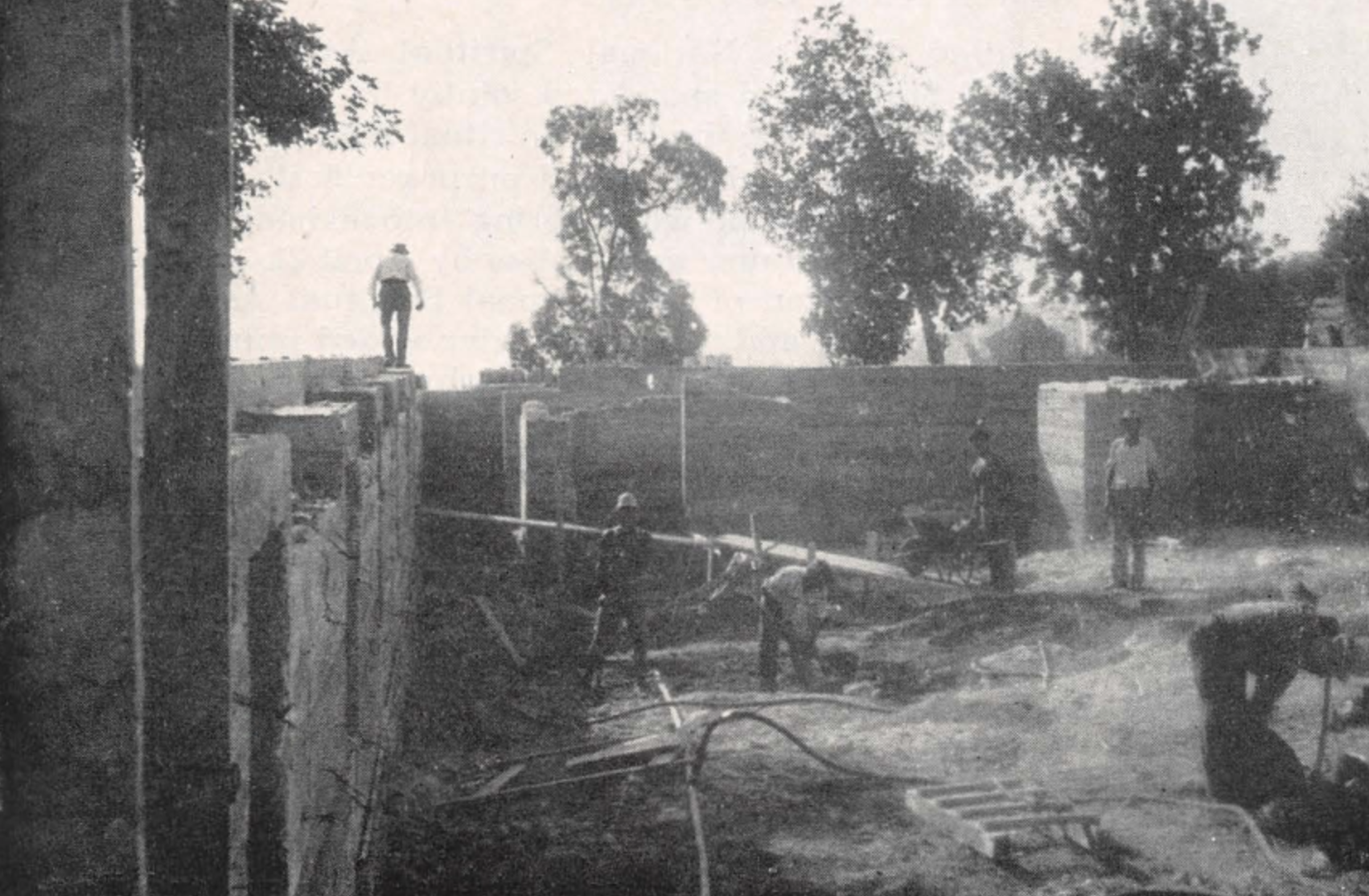
Construction begins on the International Bahá'í Archives, with the excavations for the foundation in the spring of 1955. Source: Bahaimedia.
Two months later, in March 1955, excavations began, and Shoghi Effendi cabled:
I joyfully announce the commencement of the excavation for the foundations of the International Archives heralding the rise of the first edifice destined to inaugurate the establishment of the seat of the World Bahá'í Administrative order in the Holy Land.
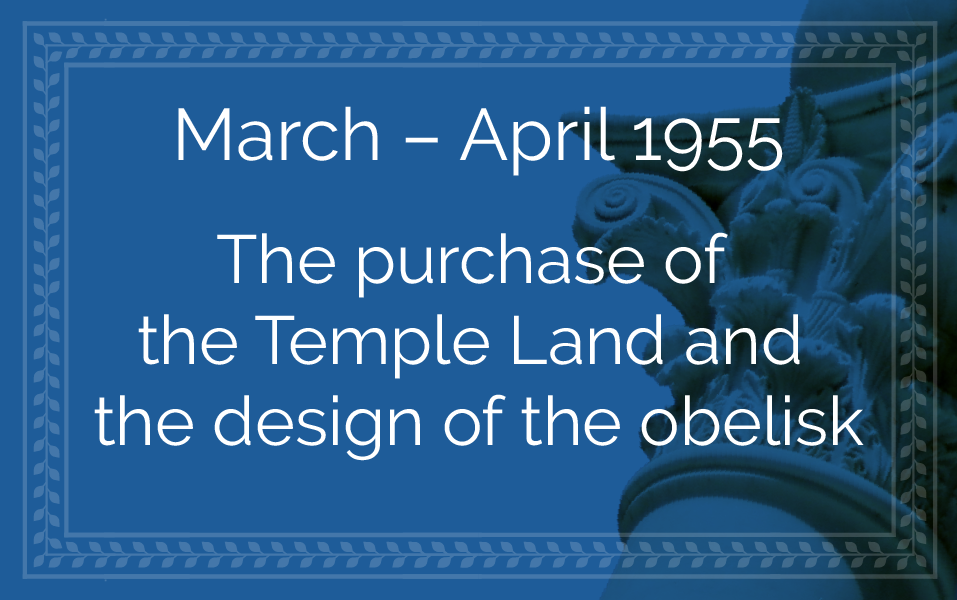

The model designed by architect and Hand of the Cause Mason Remey for the Mashriqu’l-Adhkár or House of Worship in the Holy Land. Photograph by Dlherrmann19 - Own work. Source: Wikimedia Commons.
While these painful and slow negotiations were drawing to a close, Shoghi Effendi did not stop acting as if the Temple Land was already in the hands of the Bahá'ís, a lifelong way at looking at this that had the power to manifest them into reality.
He commissioned the design of the House of Worship of the Holy Land to Mason Remey and on 20 March 1955, announced to the Bahá'ís of the world that he had approved the design:
I announce moreover the selection of the design submitted by the Hand of the Cause, Mason Remey, for the projected Mother Temple in Bahá'u'lláh's native land, paving the way for the construction of the third Mashriqu'l-Adhkár of the Bahá'í world.
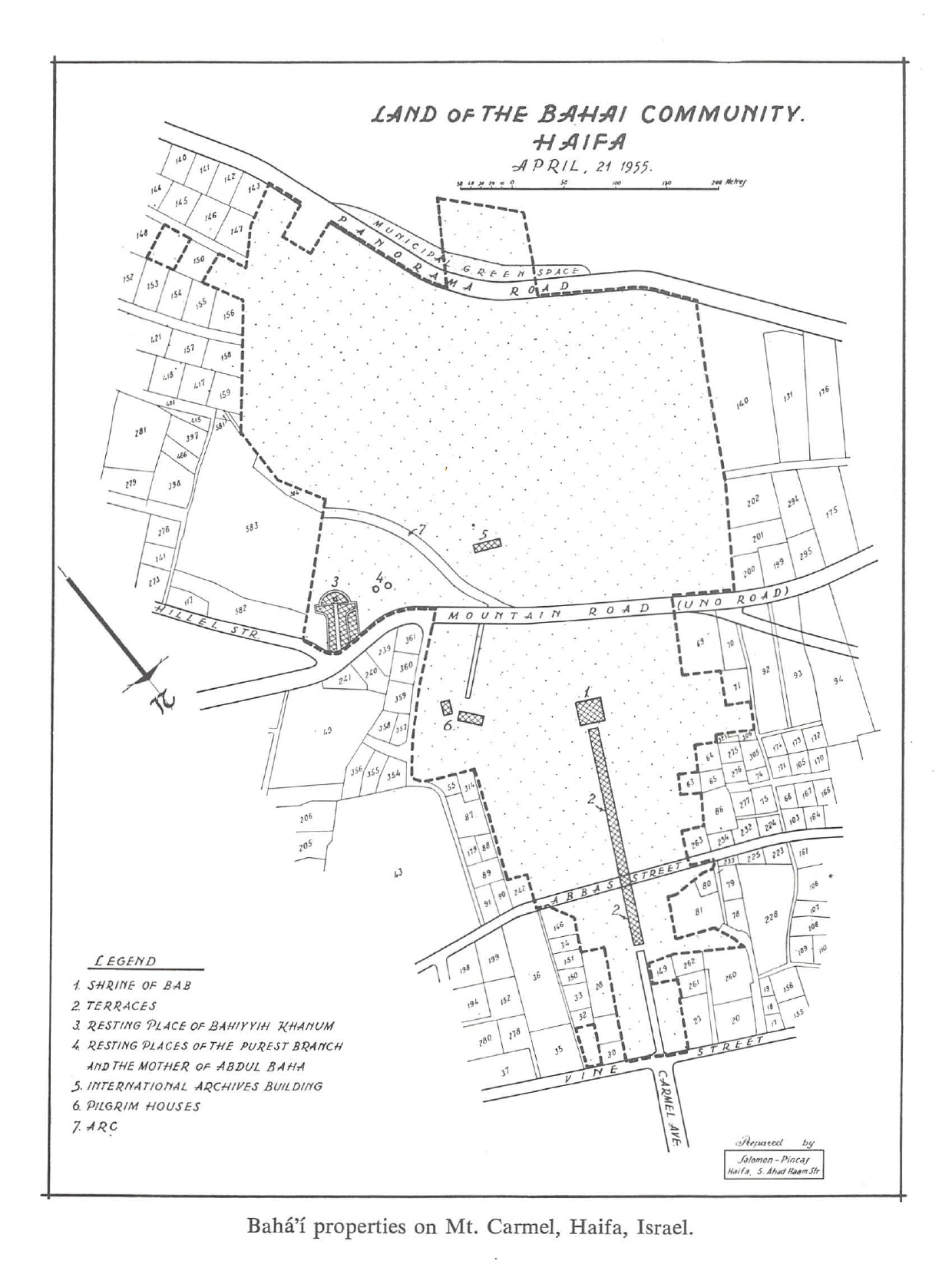
The Bahá'í properties on Mount Carmel. The land of the International Bahá'í Archives is the space around the building marked number 5 on this map, published in The Bahá'í World Volume 12, page 95.
Leroy Ioas picked himself up after receiving this blow, and went to the Carmelite with whom he had dealt and told him:
Father, you know me and I know you. You know we have to have this land and you want us to have it, the State has agreed to let us . have it. What can we do about it? You have handled many of these matters, tell me how to do it.
The solution was pure imaginative loophole genius, but very complicated: because the property was still officially registered in the name of the British War Office, they would have to transfer it to the Carmelites, who then would have to transfer it to a third, nonreligious party—the Baha’i’s lawyer—who would have to purchase the land as a Trustee for the Bahá'ís, and then, finally, he would have to transfer it to the Bahá'ís.
But thankfully, that didn’t happen. In the end, the Israeli Government agreed to a single transfer, and the Temple Land passed directly from the British War Office to the Guardian in a single transaction.
When the Temple land was finally acquired, Shoghi Effendi cabled:
Tell Leroy loving appreciation achievement.
It took two years to formally purchase the land and the protracted negotiations involved, in chronological order, Lawyers, the Carmelite Order, the British War Office, the Israeli Defense Ministry, the Israeli Government, The Defense Minister, a State Domain official, and the Vatican.
The Guardian was finally able to announce the momentous news to the Bahá'í world in a cable dated April 1955, where he paid tribute to Amelia Collins’ extraordinary generosity:
The international Bahá'í endowments on Mt. Carmel have been greatly enhanced by the signature of a contract with the Israeli Authorities for the acquisition of an area of thirty-six thousand square meters, situated on the promontory of Mt. Carmel, overlooking the Cave of Elijah, as well as the spot sanctified by the footsteps of Bahá'u'lláh and associated with the revelation of the Tablet of Carmel, for the price of one hundred and eight thousand dollars, to serve as the site for the first Mashriqu'l-Adhkár of the Holy Land, the entire sum having been donated by Amelia Collins, Hand of the Cause and outstanding benefactress of the Faith.
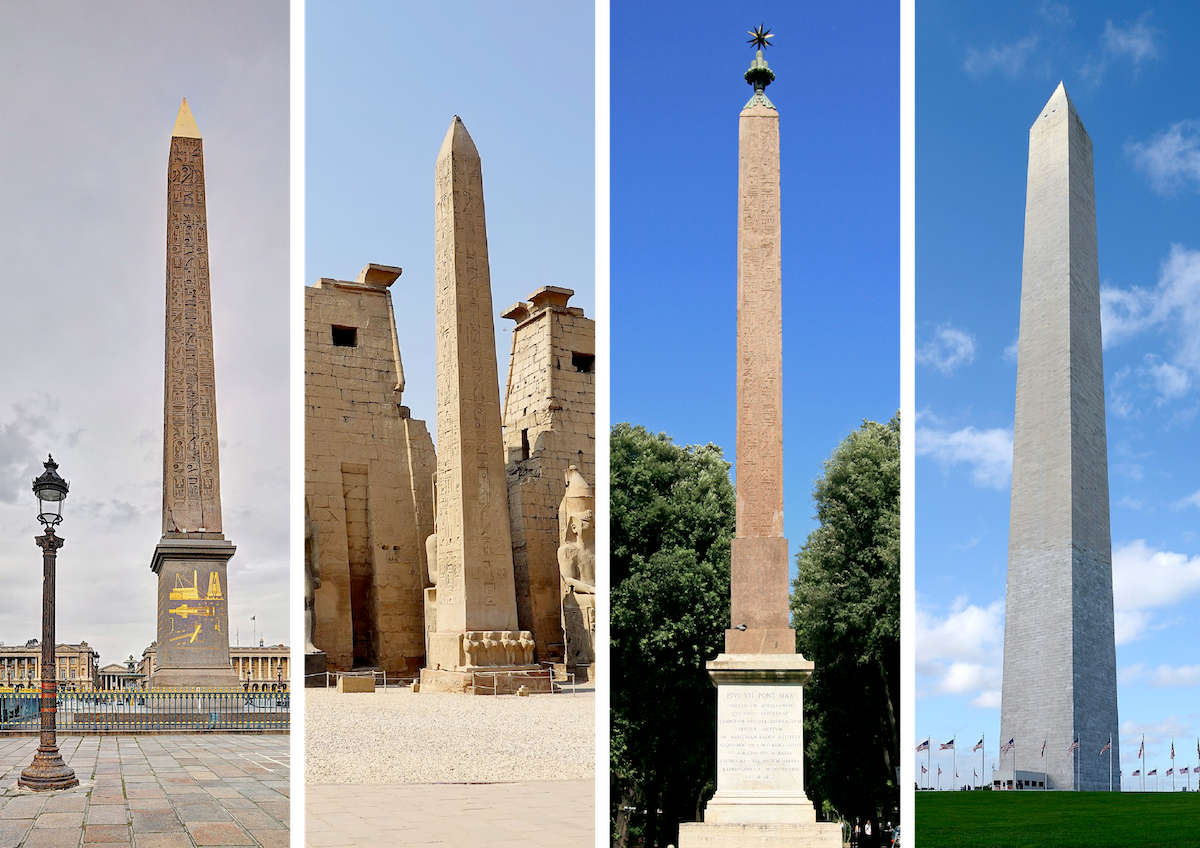
Obelisks from the past, the inspiration to Shoghi Effendi’s unique design, from left to right: The second Egyptian obelisk from Luxor in Place de la Concorde, Paris by Moonik - Own work, CC BY-SA 3.0, Source: Wikimedia Commons. The first Egyptian obelisk at the Temple of Luxor by Olaf Tausch - Own work, CC BY 3.0. Source: Wikimedia Commons. The Roman Antinous obelisk in Rome’s Pincian Hill by Jensens. Source: Wikimedia Commons. The obelisk at the Washington Monument, erected between 1848 and 1884 Bb Alvesgaspar - Own work, CC BY-SA 4.0. Source: Wikimedia Commons.
Shortly after making the October announcement regarding the eventual purchase of the Temple Land, the Guardian gave thought to which type of marker he was going to design to place on the Temple Land when the time was right. He consulted with Hand of the Cause Ugo Giachery, asking. Him what would be an appropriate manner to mark and celebrate the future House of Worship in the Holy Land.
Ugo Giachery replied that the Romans had always used either a single column or an obelisk to celebrate their heroes or mark historic events. Shoghi Effendi opted for an obelisk and sent Ugo Giachery a simple sketch, asking him to get estimates from several firms. On 12 April 1954, the Guardian validated the estimate of Enrico Pandolfini, of Pietrasanta, whose bid was the most reasonable.
Professor Ugo Mazzei, Enrico Pandolfini’s architect then prepared the final design which the Guardian approved by telegram on 29 April 1954.
By the end of 1954, just 8 months later, the obelisk was fully complete and all the marble, more than 20 tons contained in many heavy wooden crates, was shipped to Haifa. There were legitimate security concerns to suddenly erecting such a large vertical structure on the top of Mount Carmel, however, and the obelisk could not be raised during the Guardian’s lifetime.
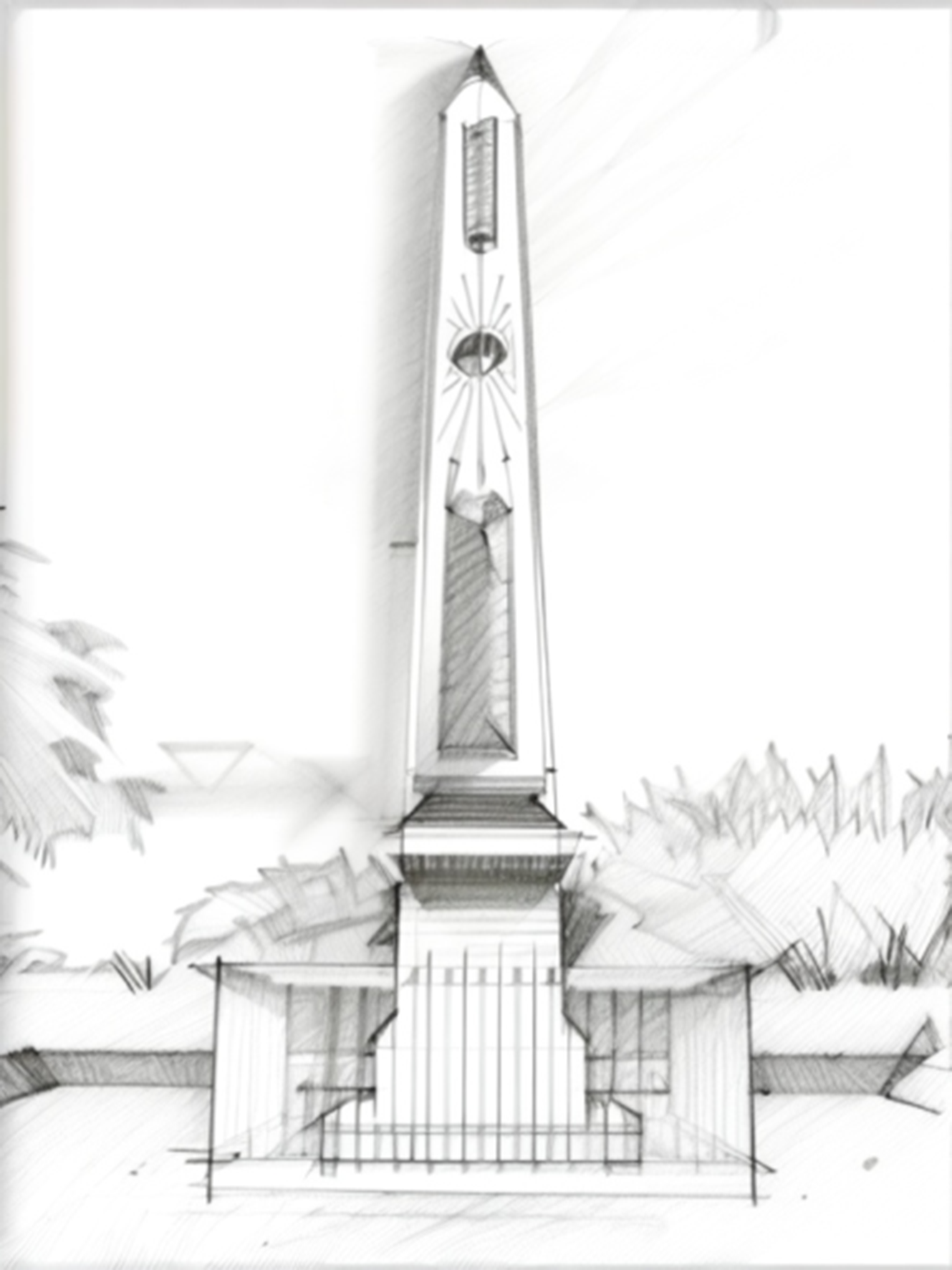
Architectural sketch render of a photograph of the obelisk with Prome AI. Original image: Bahaimedia.
The obelisk was 11 meters high, starting at the base as a square and extending itself like a very long, narrow pyramid, tapering into a point at the top. The base of the obelisk was hollow and made of large slates of marble.
The obelisk was composed of blocks of travertino marble to be assembled together. Travertino marble is the marble Romans used to build Rome, the most legendary marble there is, with a very interesting quality: it is soft and malleable marble to work with as soon as it is quarried, and hardening after exposure to the air. The Colosseum, and one of Shoghi Effendi’s most favorite buildings—and domes—St. Peter’s Basilica, were both built out of travertino marble.
The south-facing pillar of the obelisk boasted a mosaic bearing the Greatest Name.
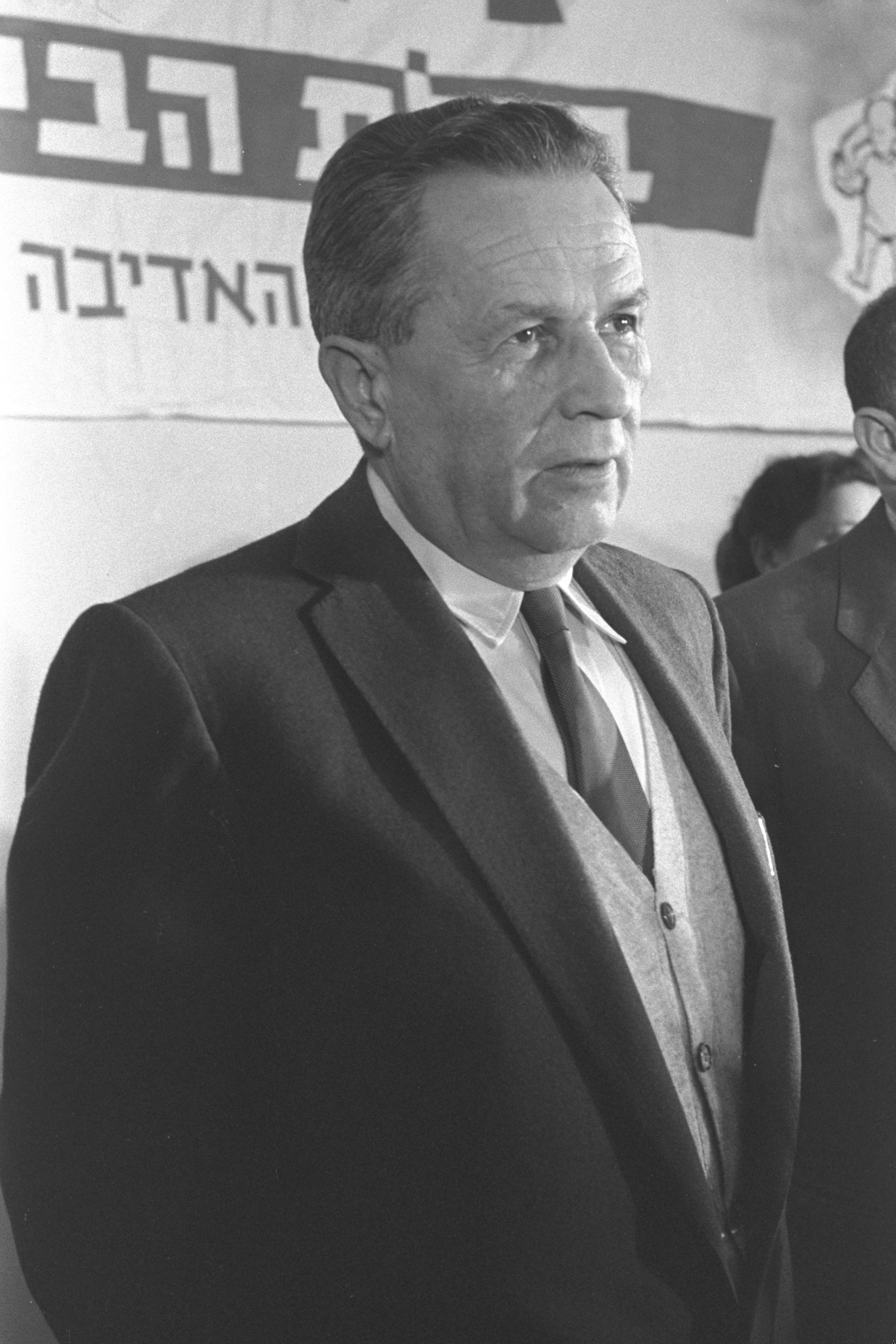
Abba Hushi, mayor of Haifa, to whom Hand of the Cause Leroy Ioas speaks in the story below. Photograph taken on 3 March 1958 by Israeli GPO photographer. Source: Wikimedia Commons.
Shortly after the land was purchased Hand of the Cause Amelia Collins asked the Guardian one night if, in the distant future, the Temple Land, the land of the Shrine of the Báb, and the land around the Shrine of Bahá'u'lláh might rejoin each other.
The Guardian told Amelia Collins yes, that would be the case, and there would be a road connecting the two.
A month or two later Leroy Ioas was in the office of Abba Hushi, the Mayor of Haifa from 1951 and 1969 on other, unrelated business, and the Mayor said to him:
Today I signed a contract with the Carmelites that will interest you—it was a contract whereby they will permit the city of Haifa to make a permanent Open Space of green trees and flowers on their land on the flank of the mountain. Ideally this should be linked up with your lands and gardens, so the entire area would be a Green Place.
Leroy Ioas immediately told him that the Bahá'ís were eager to purchase that land if it became available, and the Mayor responded:
You had to build your own gardens around the Shrine, now we will build gardens for you on the front of the mountain.

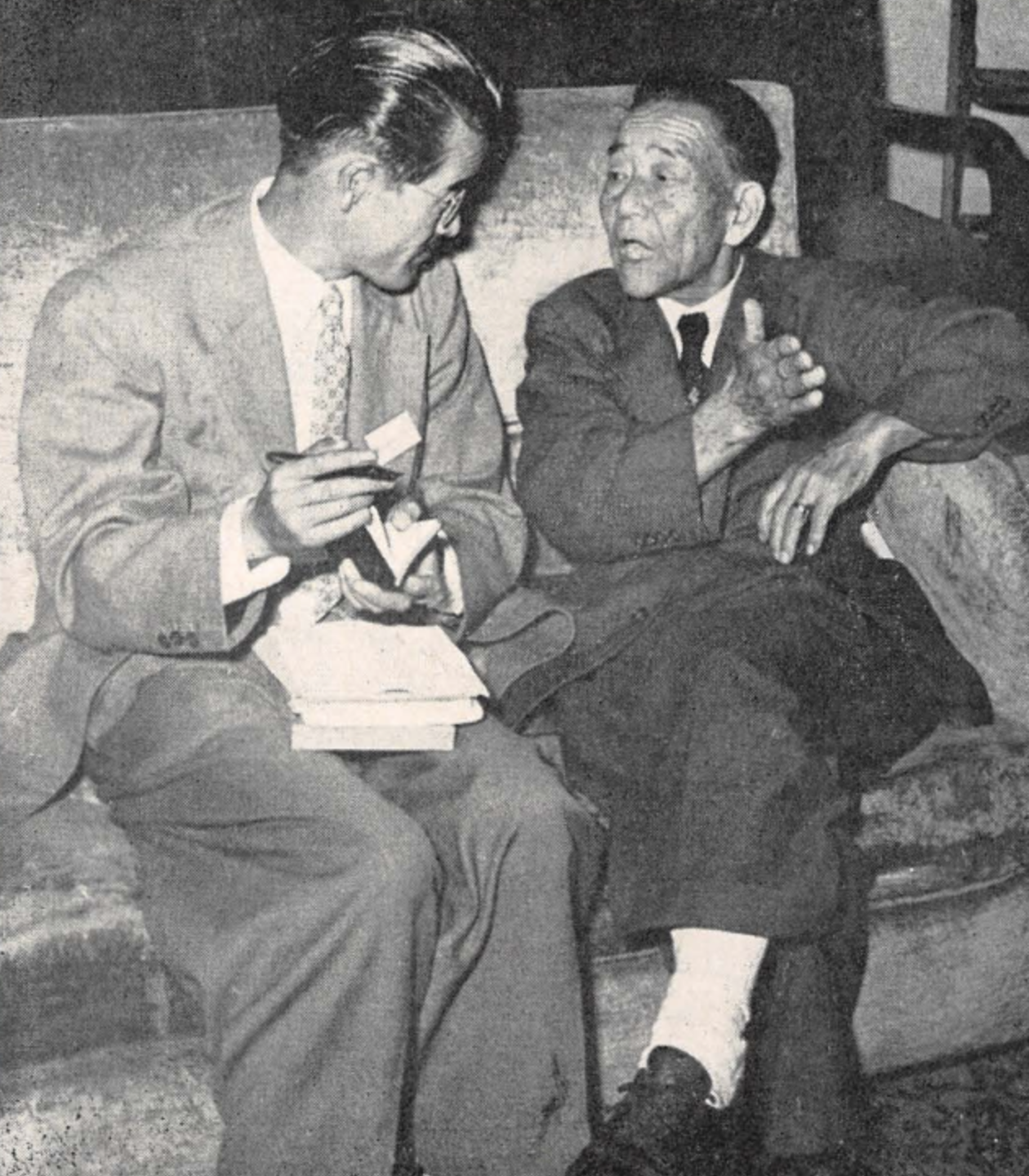
Photograph of Takeyasu Hasegawa of Kyushu Island speaking with Saichiro Fuiita about his experiences serving in 'Abdu'l-Baha's household in Haifa for many years. This photograph was taken during the first Asia Regional Teaching Conference in Japan, on 23-25 September 1955. Saichiro Fujita spoke to the entire Conference of 'Abdu'l-Baha's promises for Japan. On a separate note, Takeyasu Hasegawa and Saichiro Fuiita were respectively the second and first Japanese Bahá'ís to meet the Guardian. Source: Bahaimedia.
Shoghi Effendi had sent Saichiro Fujita back to Japan in 1938 out of concern for his safety and the growing hatred against the Japanese. When he arrived in Japan, Saichiro Fujita settled in Yanai and actively taught the Faith, particularly to visiting soldiers from Australia, Britain, and the United States after the end of World War II in 1945. Saichiro Fujita was in Japan when the two atomic bombs were detonated in Hiroshima and Nagasaki. Saichiro Fujita stayed in Japan throughout World War II, and for a decade after, in total 17 years from 1938 to 1955.
It proved to be very difficult for Saichiro Fujita to obtain a passport, a visa, and secure transport back to the Holy Land, but he finally was able to return in 1955, two years before the Guardian’s passing, after having attended the first Asia Regional Teaching Conference in Japan, on 23-25 September 1955.
After his return, Saichiro Fujita served as a messenger for Shoghi Effendi, and the Guardian gave him a small piece of land on Mount Carmel to develop, immediately above the International Bahá'í Archives, where there was a small cluster of pine trees. Saichiro Fujita worked very hard on that plot, and Shoghi Effendi came up every afternoon around 4:00 PM until sunset to check on Saichiro Fujita’s progress, observe the gradual unfoldment of his gardens.

Top photograph: First Spiritual Assembly of the Baha'is of Bathurst, Gambia, elected April 1955. Source: Bahaimedia. Bottom photograph: The Haziratu'l-Quds of the Baha'is of Kampala, Uganda, British East Africa, which will become the Regional Bahá'í Center for the Bahá'ís of Central and East Africa. The Center was purchased in 1952. On the lawn to the right the tent was erected in which the First Intercontinental Conference was held in 1953. Source: Bahaimedia. Background:An aerial photograph of Mpumalanga ("Where the sun rises") in South Africa by Lina Loos on Unsplash.
The Faith grew exponentially in Africa, to the Guardian’s utmost joy, and the progress by Riḍván 1955 was extraordinary:
- There were over 120 Local Spiritual Assemblies in Africa
- 31 new Local Spiritual Assemblies were formed in Central and East Africa alone
- Uganda formed 17 new Local Spiritual Assemblies
- There were now 900 Bahá'ís in Uganda and 100 communities
- Kenya formed eight new Local Spiritual Assemblies
- Tanganyika elected 2 Local Spiritual Assemblies
- The very first Local Spiritual Assemblies were formed in 7 countries:
- The Belgian Congo (now the Democratic Republic of Congo)
- Ruanda-Urundi (the two countries of Rwanda and Burundi)
- The Island of Zanzibar
- The Seychelles Islands
- Ashanti (now Ghana)
- The French Cameroons (now Cameroon)
- And the Canary Islands
- Enoch Olinga had formed 8 new Local Spiritual Assemblies in the British Cameroons
- And three territories were just opened to the Faith
- Spanish Guinea
- The Comoros Islands
- and St Thomas Island were finally opened to the Faith.
Deeply proud of the Bahá'ís efforts and victories in Africa, the Guardian joyfully and gratefully cabled Músá Banání on 26 April 1955:
Rejoice greatly, admire deeply, grateful magnificent achievements valiant friends, coloured white pioneers, teachers, administrators, four areas African continent. Loving fervent prayers surrounding them.
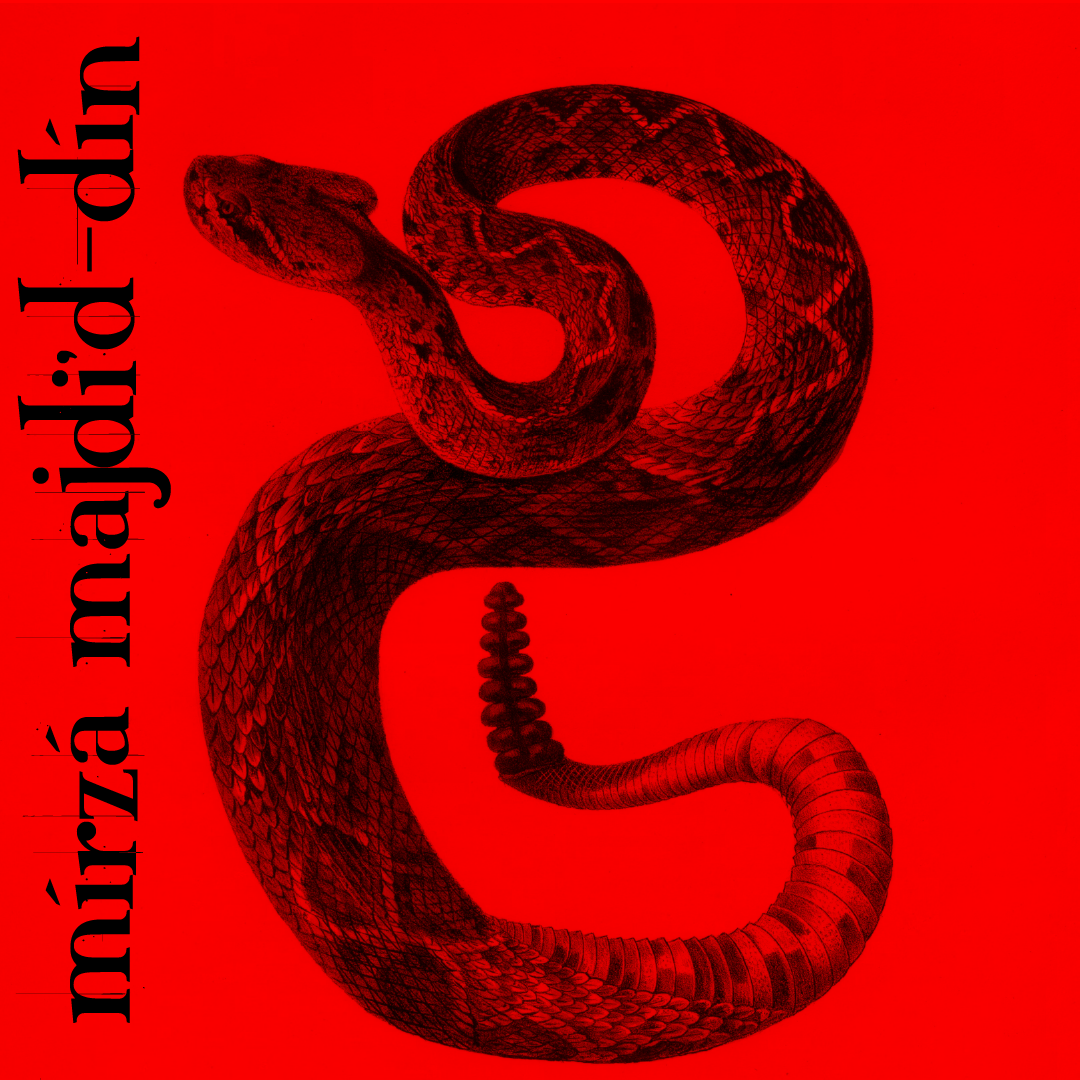
Art asset by The New York Public Library on Unsplash.
Mírzá Majdi’d-Dín was Mírzá Badí’u’lláh’s accomplice. He was the son of Bahá'u'lláh’s faithful brother, Mírzá Músá, and a sworn enemy of 'Abdu'l-Bahá. He lived to be over 100 years old and before he died he managed to spread the poison of Covenant-breaking among 'Abdu'l-Bahá’s family, his last act of perfidy. He was such an evil presence that after he died, Shoghi Effendi sent the following cable to the Bahá'í world:
Announce to National Assemblies that Mírzá Majdi’d-Dín, the most redoubtable adversary of Abdu'l-Bahá, denounced by Him as the incarnation of Satan and who played a predominant part in kindling the hostility of Abdu'l-Hamid and Jamal Pasha, and who was the chief instigator of Covenant-breaking and Archbreaker of Bahá'u'lláh's Covenant, and who above sixty years labored with fiendish ingenuity and guile to undermine its foundations, miserably perished struck with paralysis affecting his limbs and tongue. Dispensation of Providence prolonged the span of his infamous life to a hundred years, enabling him to witness the extinction of his cherished hopes and the disintegration with dramatic rapidity of the infernal crew he unceasingly incited and zealously directed, and the triumphant progress and glorious termination of Abdu'l-Bahá's thirty-year ministry as well as evidences of the rise and establishment in all continents of the globe of the administrative order, child of the divinely-appointed Covenant and harbinger of the world-encircling order.
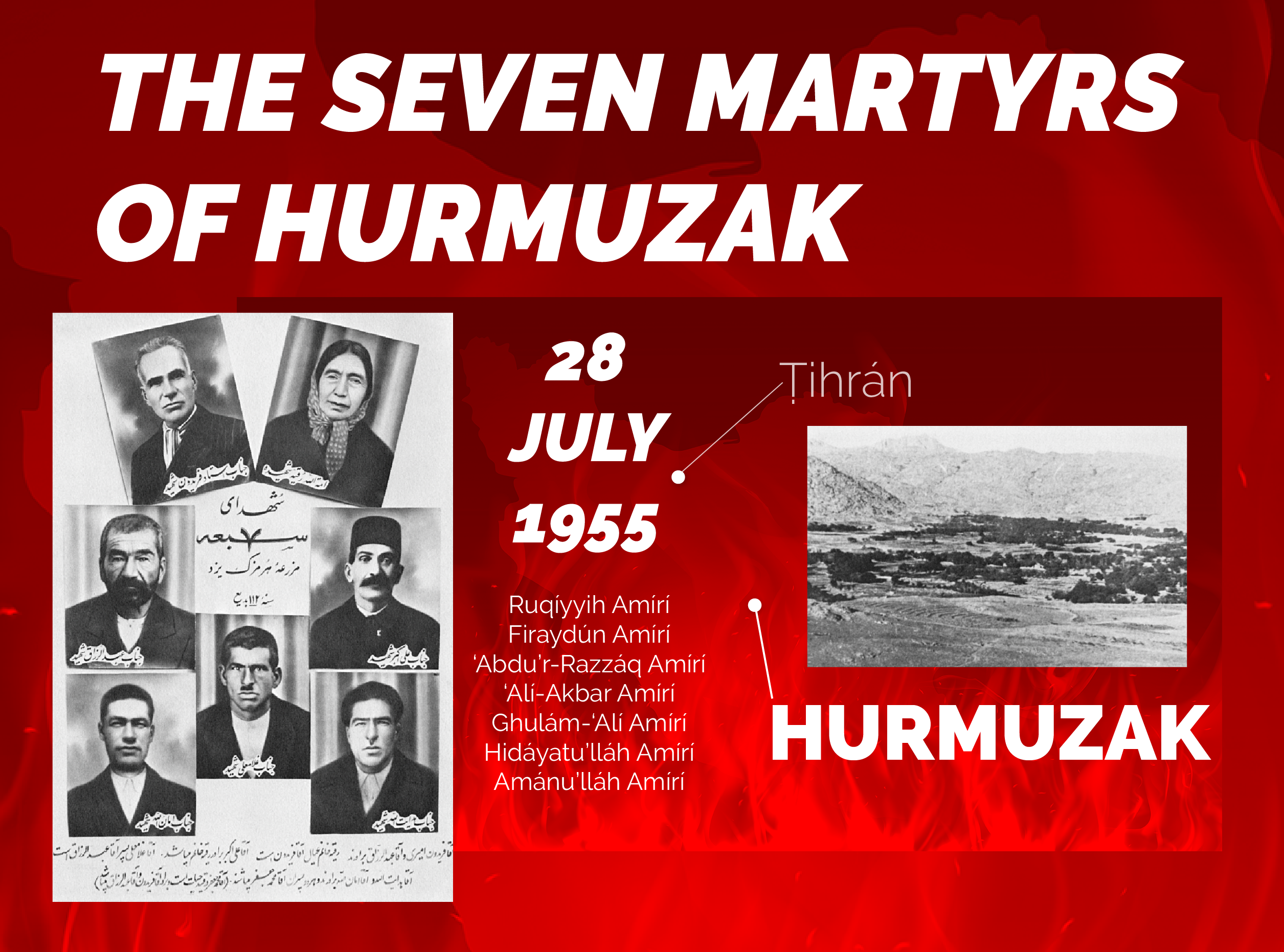
The Seven Martyrs of Hurmuzak, savagely killed on 28 July 1955. The seven martyrs were all members of the Amíri family, and their names were: Ruqíyyih Amírí, Firaydún Amírí, ‘Abdu’r-Razzáq Amírí, ‘Alí-Akbar Amírí, Ghulám-‘Alí Amírí, Hidáyatu’lláh Amírí, Amánu’lláh Amírí. Source of photographs: The Seven Martyrs of Hurmuzak by Muḥammad Labib, translated from the Persian by Dr. Moojan Momen.
There is no doubt in Rúḥíyyih Khánum’s mind, that the violent, barbaric persecutions against kind and helpless Bahá'ís in Iran in the summer of 1955 which so devastated the Guardian, were a factor in his early death. This was the worst persecution of Bahá'ís during the entire ministry of the Guardian.
In April and May of 1955, during the fasting month of Ramaḍán, a popular preacher known as Falsafi began inciting violence against Bahá'ís. His sermons were broadcast nationally by the Government, and the population's hatred was fanned by local religious leaders. The National Bahá'í headquarters were destroyed, and on 17 May 1955 the Minister of the Interior announced in Parliament orders to suppress the Bahá'í Faith, and an avalanche of persecution ensued.
Bahá'í holy places including the House of the Báb in Shiraz were ransacked or occupied, homes and farms looted and burned, Bahá'í cemeteries destroyed, adults beaten, young women abducted and forced to marry Muslims, children expelled and employees fired. The violence was unchecked by the Government or police and in many areas, it was Government officials who instigated and led the attacks on the Bahá'ís.
Hurmuzak is a village approximately 50 kilometers (30 miles) southwest of Yazd, where seven members of the Amiri family, ranging in age from 19 to 80, were savagely murdered on 28 July 1955, after the tidal wave of hatred and violence spurred the inhabitants of surrounding villages into a homicidal rage.

The Guardian was so affected by this act of savagery that he . Background: Village of Hurmuzak. Top photograph: Widows and orphans of the Seven Martyrs of Hurmuzak in front row (6 are missing) Bottom photograph: Part of roof of ruined stable belonging to a Bahá'í villager. Background: The village of Hurmuzak. Source of photographs: The Seven Martyrs of Hurmuzak by Muḥammad Labib, translated from the Persian by Dr. Moojan Momen.
In a letter dated 20 August 1955, and titled “A Mysterious Dispensation of Providence,” describes this barbaric episode:
Emboldened by the general applause accorded by the populace to the savage perpetrators of these crimes, a mob of many hundreds marched upon the hamlet of Hurmuzak, to the beating of drums and the sounding of trumpets, and, armed with spades and axes, fell upon a family of seven, the oldest eighty, the youngest nineteen, and, in an orgy of unrestrained fanaticism, literally hacked them to pieces.
In the same letter of 20 August 1955, Shoghi Effendi reflects on the unexpected widespread publicity that immediately followed the martyrdom of the Amiri family in Hurmuzak:
Whatever its outcome, this sudden commotion that has seized the Bahá’í world, that has revived the hopes and emboldened the host of the adversaries of the Faith intent on quenching its light and obliterating it from the face of the earth, has served as a trumpet call in the sounding of which the press of the world, the cries of its vociferous enemies, the public remonstrances of both men of good will and those in authority have joined, proclaiming far and wide its existence, publicizing its history, defending its verities, unveiling its truths, demonstrating the character of its institutions and advertising its aims and purposes.
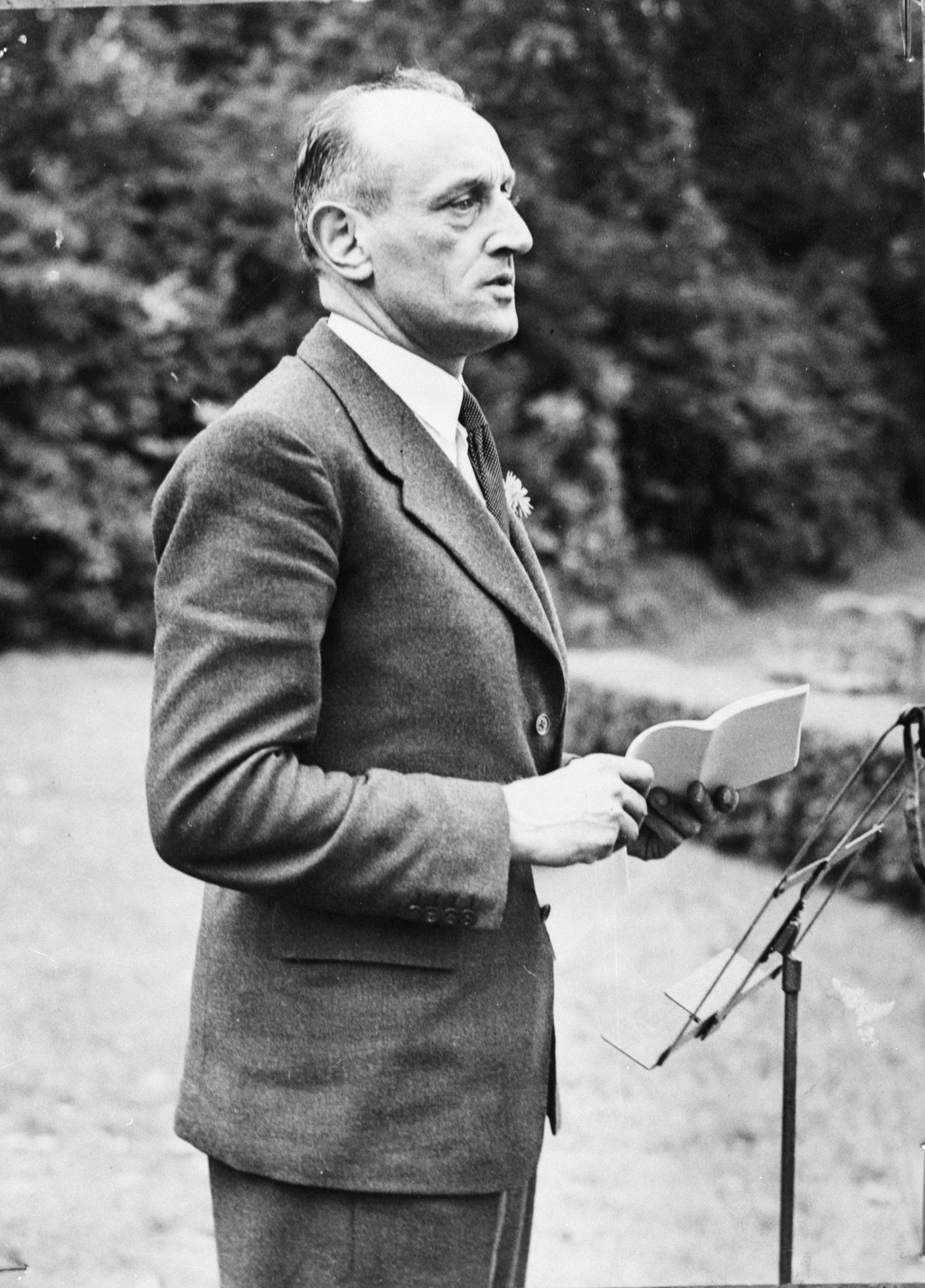
The United Nations High Commissioner for Refugees (UNHCR), Gerrit Jan van Heuven Goedhart, who served from 1951 to 1956. Source: Wikimedia Commons.
The entire Bahá'í world was horrified beyond description by the atrocities perpetrated on their brothers and sisters in Iran.
The Guardian bore the shock of these sudden and violent waves of these attacks and devised his strategy alone from the heart of Europe. He comforted the oppressed, raised money for their aid, and defended them ceaselessly left and right.
The Guardian instructed the Bahá'ís and National Spiritual Assemblies to send over 1,000 telegrams and letters expressing their shock and dismay at the unjust and lawless persecution of a harmless religious community based solely on prejudice to the Shah, to the Iranian government and parliament, and the President of the United States. Cables streamed into Iran from places they had never heard of.
Directed by Shoghi Effendi, the Bahá'ís appealed to presidents and to prominent figures throughout the world.
The Guardian personally nominated representatives from the Bahá'í International Community to bring the matter up with the Social and Economic Council, the Director of the Human Rights Division, and specialized non-governmental agencies with consultative status.
This was the first time in its history that a Faith, under attack by its enemies was able to defend itself with legal weapons, in the case of the Faith, its nascent Administrative Order and international agencies.
The Guardian inaugurated a special fund called "Aid the Persecuted" for the oppressed Iranian Bahá'ís and opened it by contributing $18,000—the equivalent in today’s currency of $200,000—and called for the construction in Kampala of the Mother Temple of Africa as a consolation for the oppressed masses.
The Bahá'í Faith was now a force to be reckoned with on the world stage.

Valíyu'lláh Varqá (1884 – 1955). Source: Bahaipedia.
Mírzá Valíyu'lláh Khán-i-Varqá—better known as Valíyu'lláh Varqá—was born in Tabríz in 1884.
Valíyu'lláh Varqá was born into a Bahá’í family in Tabriz in 1884. His father was father was Varqá, a Hand of the Cause, an Apostle of Bahá'u'lláh, and a Martyr. He was killed along with his son Rúhu'lláh in 1896.
This family is exceptional in that three generations were Hands of the Cause: Varqá, in the time of 'Abdu'l-Bahá, his son Valíyu'lláh Varqá in the time of the Guardian, and finally ‘Alí-Muḥammad Varqá, his grandson, during the time of both Shoghi Effendi and the Universal House of Justice.
In 1900, at the age of 6, Valíyu'lláh Varqá moved to Míyándu’áb, a village in Persia’s northwestern province of Ádhirbáyján, with his paternal uncle Mírzá Ḥusayn Yazdí and became a Bahá'í through him. He moved to Beirut for his university studies and during his summer holidays, he visited the Holy Land and spent time with ‘Abdu’l-Bahá.
In 1909 ‘Abdu’l-Bahá asked Valíyu'lláh Varqá to return to Ṭihrán and work in the court of the Sháh of Persia. Valíyu'lláh Varqá became a chamberlain and in this position, he was able to correct misinformation about the Bahá'í Faith and serve as intermediary between 'Abdu'l-Bahá and the Sháh.
In 1910, Valíyu'lláh Varqá married Bahíyyih Sani Illahi, and they had ten children who all became active Bahá’ís. Shortly after his wedding, he began working for the Russian Embassy in Ṭihrán.
Valíyu'lláh Varqá accompanied 'Abdu'l-Bahá in His Journeys to the West in 1912, and traveled to North America, London, and Paris, serving the Master as a translator. He returned to Persia after this journey and worked at the Turkish Embassy.
When the first National Spiritual Assembly of Persia was formed in 1934, Valíyu'lláh Varqá was elected to the body, and in 1939, the Guardian appointed him Trustee of the Ḥuqúqu’lláh. He resigned from his work at the beginning of World War II to serve the Faith full-time.
On 24 December 1951, the Guardian appointed Valíyu'lláh Varqá a Hand of the Cause for Iran. Valíyu'lláh Varqá attended all four Intercontinental Teaching Conferences during the Holy Year of 1953, during which time he took the opportunity to visit Brazil, Chile, Germany—where he became ill and was hospitalized for a week—Iraq, Egypt, Syria and Turkey.
After his extensive travels in 1953, he submitted a report to the Guardian who instructed him to return to Persia, before coming on pilgrimage to the Holy Land. Valíyu'lláh Varqá spent two weeks in Haifa meeting with Shoghi Effendi, then returned to Germany on the Guardian’s instructions to receive treatment.
In March 1955, after experiencing severe pain, Valíyu'lláh Varqá traveled to France and Italy for further medical treatment, then returned to Germany and was hospitalized in Tubingen. He passed away on 12 November 1955 and was buried in Stuttgart.
On 15 November 1955, three days after his passing, the Guardian sent the following eulogy cable where he instructed a memorial be erected in his honor:
Profoundly grieved loss outstanding Hand Cause God, exemplary trustee Ḥuqúq, distinguished representative most venerable community Bahá’í world, worthy son brother twin immortal martyrs Faith, dearly beloved disciple Center Covenant. Shining record services extending over half century enriched annals heroic formative ages Bahá’í Dispensation. His reward Abhá Kingdom inestimable. Advise erect my behalf befitting monument his grave. His mantle as trustee funds Ḥuqúq now falls on ‘Ali Muhammad, his son. lnstruct Rowhani Ṭihrán arrange befitting memorial gatherings capital provinces honor memory mighty pillar cradle Faith Bahá’u’lláh. Newly-appointed trustee Ḥuqúq now elevated rank Hand Cause.
When Valíyu'lláh Varqá’s son, ‘Alí-Muḥammad Varqá was elevated to the rank of Hand of the Cause and appointed as Trustee of the Ḥuqúqu’lláh to replace his illustrious father, he became the only third-generation Hand of the Cause, after his grandfather, the martyr Mírzá ‘Alí-Muḥammad Varqá—appointed a Hand of the Cause by Bahá'u'lláh —and his father Valíyu'lláh Varqá.
SOURCES FOR PART XIX
Shoghi Effendi: Recollections, Ugo Giachery, George Ronald, 1973, pages 151-152.
The Bahá’í World Volume 12: In Memoriam: Dorothy Beecher Baker.
Citadel of Faith, Shoghi Effendi, 13 January 1954.
February 1954: A gift from the Guardian for Ugo Giachery
Shoghi Effendi: Recollections, Ugo Giachery, George Ronald, 1973, pages 107-108.
Late February – Early March 1954: The Guardian speaks about Japan to the first Japanese pilgrim
Bahá’í Library Online: Memories of talks with the Guardian, Hiroyasu Takano (1980).
A Tribute to Amatul’Bahá Ruḥíyyíh Khánum, Violette Nakhjávání.
Bahá’í Library Online: This is Faith, Rúḥíyyih Khánum.
6 April 1954: The Guardian inaugurates the Auxiliary Board
The Auxiliary Boards: A turning point in Bahá’í Administration
REFERENCES FOR THE PREVIOUS TWO STORIES:
The Priceless Pearl, Rúḥíyyih Rabbání, Bahá’í Publishing Trust, London, 1969, pages 256-257 and 425.
Bahaipedia: Auxiliary Board.
The Bahá’í Faith: The Official Website of the Worldwide Bahá’í Community: The Institution of the Counsellors.
Messages to the Bahá’í World: 1950–1957, Shoghi Effendi, Bahá’í Publishing Trust, Wilmette, Illinois, 1971, Cablegram dated 6 April 1954: page 60.
Riḍván 1954: Israel Branches of National Spiritual Assemblies
Leroy Ioas: Hand of the Cause of God, Anita Ioas Chapman, George Ronald, 1998, page 206.
Messages to the Bahá’í World: 1950–1957, Shoghi Effendi, Bahá’í Publishing Trust, Wilmette, Illinois, 1971, page 64.
1953 – 1954: Heights of Heroism – Heroes of the Heroic Age and Heroes of the Formative Age
Leroy Ioas: Hand of the Cause of God, Anita Ioas Chapman, George Ronald, 1998, page 263.
The historical background of the Temple Land on Mount Carmel
Leroy Ioas: Hand of the Cause of God, Anita Ioas Chapman, George Ronald, 1998, pages 212-213.
Violetta Zein, The Blessed Beauty chronology Part IX: Mazra’ih, Bahjí, and Haifa (1877 – 1892): A few days later: REVELATION: Lawḥ-i-Karmíl (The Tablet of Carmel).
Leroy Ioas: Hand of the Cause of God, Anita Ioas Chapman, George Ronald, 1998, pages 212-213.
Leroy Ioas: Hand of the Cause of God, Anita Ioas Chapman, George Ronald, 1998, pages 213-214.
“What is so particular about this spot?”
REFERENCES FOR THE PREVIOUS TWO STORIES:
Leroy Ioas: Hand of the Cause of God, Anita Ioas Chapman, George Ronald, 1998, page 214-215.
Amelia Collins’s gift to the Guardian
Sweet Enchanting Stories. Aziz Rohani (comp.) & (ed.), Juxta Publishing Ltd, (2005), pages 18-20.
Shoghi Effendi Through the Pilgrim’s Eye, Volume 2 The Ten Year Crusade, 1953-1963. Earl Redman, George Ronald, Oxford, 2016, Kindle Edition, Locations 916-939.
April 1954: The purchase of the Temple Land: Negotiations with the Carmelites
April 1954: The Guardian selects the site for the Mashriqu’l-Adhkár in the Holy Land
REFERENCES FOR THE PREVIOUS TWO STORIES:
Leroy Ioas: Hand of the Cause of God, Anita Ioas Chapman, George Ronald, 1998, page 213.
Messages to the Bahá’í World: 1950–1957, Shoghi Effendi, Bahá’í Publishing Trust, Wilmette, Illinois, 1971, page 63.
“The Shiny Man” and cobra attacks: How Bill Sears became a Bahá’í and pioneered to Africa
Lights of Fortitude: Glimpses into the Lives of the Hands of the Cause of God, Barron Deems Harper, George Ronald, 1997, pages 496-506.
1 April 1954: Bill Sears arrives on pilgrimage
Bahá’í Library Online: Pilgrimage to Haifa and ‘Akká: Parts 2 and 3, (Part 1 missing), Bill Sears, pages 1-2.
2 April 1954: Bill Sears meets the Guardian
Bahá’í Library Online: Pilgrimage to Haifa and ‘Akká: Parts 2 and 3, (Part 1 missing), Bill Sears, pages 2-3.
Shoghi Effendi: The call to higher service
Bahá’í Library Online: Pilgrimage to Haifa and ‘Akká: Parts 2 and 3, (Part 1 missing), Bill Sears, pages 1 and 3-4, 5-6.
Bahá’í Library Online: Pilgrimage to Haifa and ‘Akká: Parts 2 and 3, (Part 1 missing), Bill Sears, pages 1 and 3-4, 5-6.
Bahá’í Library Online: Pilgrimage to Haifa and ‘Akká: Parts 2 and 3, (Part 1 missing), Bill Sears, pages 1 and 3-4, 5-6.
Bill Sear’s pen portrait of Shoghi Effendi
The Guardian’s overpowering feeling of motion and action
The Guardian’s eloquence regarding pioneering
The heartache for pilgrims of watching the Guardian leave the dinner table
REFERENCES FOR THE PREVIOUS FIVE STORIES:
Bahá’í Library Online: Pilgrimage to Haifa and ‘Akká: Parts 2 and 3, (Part 1 missing), Bill Sears, pages 6-7.
Bahá’í Library Online: Pilgrimage to Haifa and ‘Akká: Parts 2 and 3, (Part 1 missing), Bill Sears, pages 1 and 6-7.
10 April 1954: The end of Bill Sears’ pilgrimage
Bahá’í Library Online: Pilgrimage to Haifa and ‘Akká: Parts 2 and 3, (Part 1 missing), Bill Sears, pages 7-8.
Spring 1954: The embankment at Bahjí
Shoghi Effendi: Recollections, Ugo Giachery, George Ronald, 1973, pages 130-131.
Riḍván 1954: The achievements of Phase 1 of the Ten Year Crusade: A Divinely-Guided Faith
22nd Ḥasan M. Balyúzí Memorial Lecture: The Ten Year Crusade, ‘Alí Nakhjávání, pages 11-12.
Messages to the Bahá’í World: 1950–1957, Shoghi Effendi, Bahá’í Publishing Trust, Wilmette, Illinois, 1971, pages 60-67.
First phase achievements: The prophecy of Daniel
Leroy Ioas: Hand of the Cause of God, Anita Ioas Chapman, George Ronald, 1998, pages 264-265.
Wikipedia: Book of Daniel.
King James Bible: Daniel 12:12.
26 April 1954: President Yitzhak Ben-Zvi meets the Guardian and Rúḥíyyih Khánum
26 April 1954: The first head of a nation visits a Bahá’í Holy Shrine
29 April– 26 May 1954: Continued exchanges between President Ben-Zvi and the Guardian
29 April– 26 May 1954: Continued exchanges between President Ben-Zvi and the Guardian
REFERENCES FOR THE PREVIOUS FOUR STORIES:
The Priceless Pearl, Rúḥíyyih Rabbání, Bahá’í Publishing Trust, London, 1969, pages 291-294.
Earl Redman, Visiting ‘Abdu’l-Baha Volume 2: The Final Years, 1913–1921 and Rúḥíyyih Rabbání, The Guardian of the Bahá’í Faith, Chapter X: The Heart and Nerve Centre
Violetta Zein, The Extraordinary Life of ‘Abdu’l-Bahá Part VIII: Return to the Holy Land: Sometime in 1919 – HAIFA – Abdu’l-Bahá meets a future President of Israel.
Wikipedia: List of Presidents of Israel.
Leroy Ioas: Hand of the Cause of God, Anita Ioas Chapman, George Ronald, 1998, pages 185-186.
Messages to the Bahá’í World: 1950–1957, Shoghi Effendi, Bahá’í Publishing Trust, Wilmette, Illinois, 1971, page 68.
4 June 1954: The Guardian is “most proud of Uganda”
Enoch Olinga: Hand of the Cause Of God: The memorial article by Rúḥíyyih Rabbání with the reminiscences of Rowshan Mustapha, Bahá’í Publishing Agency, Kenya, Nairobi, 2001, pages xii-xiii.
Shoghi Effendi: The Range and Power of His Pen, ‘Alí Nakhjávání, Acuto 2006, Casa Editrice Bahá’í, pages 85-86.
Bahaipedia: Shoghi Effendi.
Late October 1954: The land above the Shrine of the Báb
Leroy Ioas: Hand of the Cause of God, Anita Ioas Chapman, George Ronald, 1998, pages 210-211..
Decades prior to November 1954: The Covenant-breaker’s land on Mount Carmel
REFERENCES FOR THE PREVIOUS TWO STORIES:
Coronation on Carmel: The Story of the Shrine of the Báb Volume II: 1922-1963, Michael V. Day, George Ronald, 2018, pages 263-264.
Leroy Ioas: Hand of the Cause of God, Anita Ioas Chapman, George Ronald, 1998, pages 210-211, and 238.
Messages to the Bahá’í World: 1950–1957, Shoghi Effendi, Bahá’í Publishing Trust, Wilmette, Illinois, 1971, 27 November 1954: Administrative Seats of Divinely-Appointed Institutions, pages 73-75.
Before 12 December 1954: Field measuring the International Bahá’í Archives
Leroy Ioas: Hand of the Cause of God, Anita Ioas Chapman, George Ronald, 1998, pages 241-242.
The Priceless Pearl, Rúḥíyyih Rabbání, Bahá’í Publishing Trust, London, 1969, pages 263-266.
Coronation on Carmel: The Story of the Shrine of the Báb Volume II: 1922-1963, Michael V. Day, George Ronald, 2018, pages 264-265.
NOTE: The Guardian field measured the International Bahá’í Archives before Ugo Giachery arrived on pilgrimage on 12 December 1954, because he asked Dr. Giachery to go over the field measurements.
12 December 1954: Ugo and Angeline Giachery arrive on pilgrimage
Ugo Giachery checks the field measurements of the International Bahá’í Archives
REFERENCES FOR THE PREVIOUS TWO STORIES:
Shoghi Effendi: Recollections, Ugo Giachery, George Ronald, 1973, pages 153-154.
24 December 1954: The Giacherys’ last dinner with the Guardian
Shoghi Effendi: Recollections, Ugo Giachery, George Ronald, 1973, pages 154-155.
25 December 1954: The Guardian entrusts Ugo Giachery with precious relics for Switzerland and Italy
25 December 1954: The Guardian bids the Giacherys farewell
REFERENCES FOR THE PREVIOUS TWO STORIES:
Shoghi Effendi: Recollections, Ugo Giachery, George Ronald, 1973, pages 154-155.
28 December 1954 – January 1955: Ugo Giachery finds the marble firm
Leroy Ioas: Hand of the Cause of God, Anita Ioas Chapman, George Ronald, 1998, page 240.
The Bahá’í World Volume 12: The Completion of the International Bahá’í Archives, Amatul’Bahá Ruḥíyyíh Khánum, pages 418-419.
Shoghi Effendi: Recollections, Ugo Giachery, George Ronald, 1973, page 152.
3 January 1955: Signing the contract with Industria dei Marmi Vicentini for the Chiampo marble
Shoghi Effendi: Recollections, Ugo Giachery, George Ronald, 1973, pages 156-158.
20 March 1955: Excavations for the International Bahá’í Archives
Messages to the Bahá’í World: 1950–1957, Shoghi Effendi, Bahá’í Publishing Trust, Wilmette, Illinois, 1971, page 75.
20 March 1955: The design for the House of Worship in the Holy Land
Messages to the Bahá’í World: 1950–1957, Shoghi Effendi, Bahá’í Publishing Trust, Wilmette, Illinois, 1971, page 75.
April 1955: The purchase of the Temple Land
Leroy Ioas: Hand of the Cause of God, Anita Ioas Chapman, George Ronald, 1998, pages 211, 215-216.
Messages to the Bahá’í World: 1950–1957, Shoghi Effendi, Bahá’í Publishing Trust, Wilmette, Illinois, 1971, page 78-79.
12 April 1954: The Guardian designs the obelisk
REFERENCES FOR THE PREVIOUS TWO STORIES:
Shoghi Effendi: Recollections, Ugo Giachery, George Ronald, 1973, pages 173-174.
The destiny of the Temple Land
Leroy Ioas: Hand of the Cause of God, Anita Ioas Chapman, George Ronald, 1998, page 216.
1955: Saichiro Fujita returns to the Holy Land after World War II
Wikipedia: Saichiro Fujita.
Bahaipedia: Saichiro Fujita.
Bahá’í Library Online: Interview of Saichiro Fujita, Sylvia Ioas (1975).
26 April 1955: The Guardian’s joy at Africa’s monumental progress
Lights of Fortitude: Glimpses into the Lives of the Hands of the Cause of God, Barron Deems Harper, George Ronald, 1997, page 345.
The Bahá’í World Volume 13.
3 June 1955: Mírzá Majdi’d-Dín
The Covenant of Bahá’u’lláh, Adib Taherzadeh, George Ronald, Oxford, 1992: Chapter 32: The Faithless Relatives of Shoghi Effendi.
Messages to the Bahá’í World: 1950–1957, Shoghi Effendi, Bahá’í Publishing Trust, Wilmette, Illinois, 1971, pages 87-88.
Wikipedia: Bahá’u’lláh’s family.
28 July 1955: The Seven Martyrs of Hurmuzak
20 August 1955: “An orgy of unrestrained fanaticism”
REFERENCES FOR THE PREVIOUS TWO STORIES:
The Priceless Pearl, Rúḥíyyih Rabbání, Bahá’í Publishing Trust, London, 1969, pages 426-427.
Seven Martyrs of Hurmuzak, The. Muhammad Labíb, Moojan Momen, George Ronald, Oxford, 1981.
Citadel of Faith, Shoghi Effendi: Letter from 20 August 1955: A Mysterious Dispensation of Providence.
August 1955: The response of the Bahá’í community to the persecutions in Iran
The Priceless Pearl, Rúḥíyyih Rabbání, Bahá’í Publishing Trust, London, 1969, pages 310-312.
12 November 1955: A Blessing for Germany: The passing of Hand of the Cause Valíyu’lláh Varqá
The Bahá’í World Volume 13: In Memoriam: Valíyu’lláh Varqá.
Bahaipedia: Valíyu’lláh Varqá.
Wikipedia: Varqá.
![]()
 The Auxiliary Boards: A turning point in Bahá'í Administration
The Auxiliary Boards: A turning point in Bahá'í Administration




























